Mar 2012
A Different Perspective
31/03/12 05:36
I was at the Black Hills Workshop and Training Center yesterday for several hours preparing for and making a presentation. At one point, while waiting for some other folks I took a few minutes to visit the art gallery of the Suzie Cappa Center. I always find that to be an amazing and wonderful experience. The Suzie Cappa Center was established in 2001 as a memorial to Suzie Cappa who was a person who received services from the Workshop. It is a place where people of all abilities can study and create in many different artistic mediums. The vision of the center is expressed in four basic beliefs:

The Suzie Cappa Center provides support for a lot of artistic expression. In addition to painting and sculpture, there are batik, weaving, photography and collage. The Center has regular opportunities for musical expression and has sponsored plays, musicals and even hosted ballet.
I know that there has been much criticism of the National Endowment for the Arts, but a quick visit to the Suzie Cappa Center will show you that not all of the money from that source is wasted. The Center adds so much to the quality of life for all of us living in the hills.
My time was short yesterday, so I took a look at the work of some of the past recipients of the Artist of the Year award. Back in 2010, the artist of the year was Shad Bebout. His bright oil paintings sport his bold and distinctive signature. They also invite viewers into a deep sense of the spirit of the land. One painting in particular caught my attention yesterday.
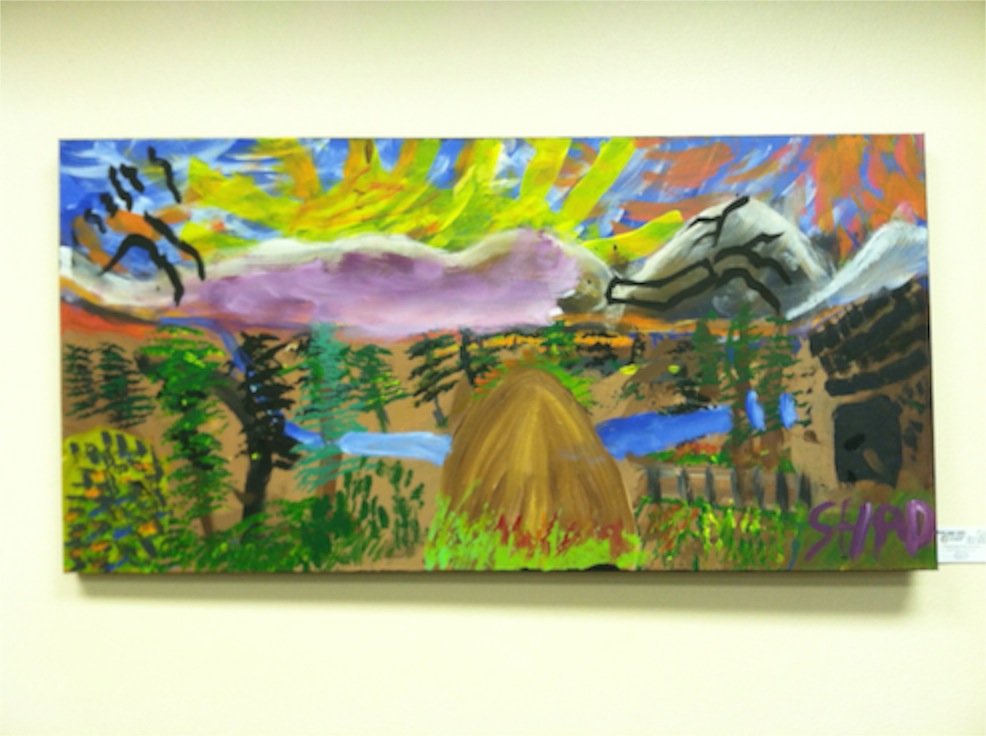
The work is titled Devil’s Tower.
President Theodore Roosevelt established Devils Tower as a National Monument in 1906. It is an amazing rock formation in northeastern Wyoming on the outer ring of the Black Hills. Long before settlers discovered this formation, it was recognized as a sacred site by plains people. The Arapaho, Crow, Lakota, Cheyenne, Kiowa and Shoshone all gathered at the site for ceremonies and gatherings. It was also a place for personal vision questing and funerals. The plains tribes did not have the concept of a negative “devil.” The commonly accepted modern name of the rock, Devil’s Tower probably comes from a misinterpretation of the Lakota concept of Spirit. In North Dakota Spirit Lake is know as Devil’s Lake, though, like the tower in Wyoming, the Lakota Stories of the place have no mention of a devil. The Lakota Name for the place, Mato Tipi, means “home of the bear,” and stories link it with Paha Mato, also known as Bear Butte.
Shad has captured the tower in a very different perspective. Most of us, when experiencing the tower see it as a dramatic standout amongst the surrounding landscape. It towers over everything in the vicinity and can be seen from a long way off. Shad’s painting depicts the tower to be sure, but it is not the dominant feature in the painting. What first catches your eye is the dramatic sunset with a fiery sky, the hills and trees, the river running by and the grass in the foreground. The tower is a prominent feature in the center of the painting, but from my point of view it appears much smaller in Shad’s painting than it feels when one visits.

I think that I have a tendency to become so focused on the foreground that I sometimes don’t notice the background. Shad’s painting invites me to think of the background as well and remember that there is more to the world than whatever is closest or biggest. There is truthfulness to Shad’s painting. The sky really is bigger than the tower. The hills are much more than just a single monolith. If you travel from Rapid City to the tower, you pass through a lot of beautiful country. If you were to sit on the edge of the Belle Fourche River, you would notice its vermillion cliffs and its very winding and indirect path as it flows from Keyhole Reservoir.
Artists have a way of getting us to look at things from a different perspective. It is one of the values of art. Somehow Shad has caught the spirit of the place in a way that surprised and delighted me yesterday as I looked at the painting.
We have been working on a special event that will be held April 15 at our church. The “Widen the Welcome” event is designed to open our doors to our community, but it is also an opportunity for those of us in the existing congregation to become better educated about the gifts of persons living with disabilities. Too often we think of those who have particular disabilities as being in need. We think about what we can do for them. We sometimes try to advocate and speak for them. What I am learning is that no one really needs me to speak for him or her. Some persons living with disabilities need me to listen carefully. When they express their hopes and fears, desires and needs, I need to open myself to careful listening, especially when their method of communication is not verbal.
The simple truth is that our community is richer because we have members of many different abilities. The people I have met through my association with the Workshop enrich my life. The Widen the Welcome event is about building a more complete community by eliminating barriers and inviting more of our neighbors to participate in the life of our church.
Who knows? Maybe one day we can add a painting by Shad to the collection of art hanging on the walls of our church.
- Disability is not a boundary. All people can be creative in a supportive environment.
• Creative expression fosters personal growth and self-esteem. Recognition of creative efforts by others gives the artist a feeling of worth that carries over in all areas of his/her life.
• Exhibitions which integrate the work of artists with and without disabilities help others see past preconceived notions of disability and begin to honor the creative spirit of every person.
• Creating art professionally adds value to one’s life. Through the cultivation of their talents, people with disabilities make contributions to the cultural and economic life of our community.

The Suzie Cappa Center provides support for a lot of artistic expression. In addition to painting and sculpture, there are batik, weaving, photography and collage. The Center has regular opportunities for musical expression and has sponsored plays, musicals and even hosted ballet.
I know that there has been much criticism of the National Endowment for the Arts, but a quick visit to the Suzie Cappa Center will show you that not all of the money from that source is wasted. The Center adds so much to the quality of life for all of us living in the hills.
My time was short yesterday, so I took a look at the work of some of the past recipients of the Artist of the Year award. Back in 2010, the artist of the year was Shad Bebout. His bright oil paintings sport his bold and distinctive signature. They also invite viewers into a deep sense of the spirit of the land. One painting in particular caught my attention yesterday.

The work is titled Devil’s Tower.
President Theodore Roosevelt established Devils Tower as a National Monument in 1906. It is an amazing rock formation in northeastern Wyoming on the outer ring of the Black Hills. Long before settlers discovered this formation, it was recognized as a sacred site by plains people. The Arapaho, Crow, Lakota, Cheyenne, Kiowa and Shoshone all gathered at the site for ceremonies and gatherings. It was also a place for personal vision questing and funerals. The plains tribes did not have the concept of a negative “devil.” The commonly accepted modern name of the rock, Devil’s Tower probably comes from a misinterpretation of the Lakota concept of Spirit. In North Dakota Spirit Lake is know as Devil’s Lake, though, like the tower in Wyoming, the Lakota Stories of the place have no mention of a devil. The Lakota Name for the place, Mato Tipi, means “home of the bear,” and stories link it with Paha Mato, also known as Bear Butte.
Shad has captured the tower in a very different perspective. Most of us, when experiencing the tower see it as a dramatic standout amongst the surrounding landscape. It towers over everything in the vicinity and can be seen from a long way off. Shad’s painting depicts the tower to be sure, but it is not the dominant feature in the painting. What first catches your eye is the dramatic sunset with a fiery sky, the hills and trees, the river running by and the grass in the foreground. The tower is a prominent feature in the center of the painting, but from my point of view it appears much smaller in Shad’s painting than it feels when one visits.

I think that I have a tendency to become so focused on the foreground that I sometimes don’t notice the background. Shad’s painting invites me to think of the background as well and remember that there is more to the world than whatever is closest or biggest. There is truthfulness to Shad’s painting. The sky really is bigger than the tower. The hills are much more than just a single monolith. If you travel from Rapid City to the tower, you pass through a lot of beautiful country. If you were to sit on the edge of the Belle Fourche River, you would notice its vermillion cliffs and its very winding and indirect path as it flows from Keyhole Reservoir.
Artists have a way of getting us to look at things from a different perspective. It is one of the values of art. Somehow Shad has caught the spirit of the place in a way that surprised and delighted me yesterday as I looked at the painting.
We have been working on a special event that will be held April 15 at our church. The “Widen the Welcome” event is designed to open our doors to our community, but it is also an opportunity for those of us in the existing congregation to become better educated about the gifts of persons living with disabilities. Too often we think of those who have particular disabilities as being in need. We think about what we can do for them. We sometimes try to advocate and speak for them. What I am learning is that no one really needs me to speak for him or her. Some persons living with disabilities need me to listen carefully. When they express their hopes and fears, desires and needs, I need to open myself to careful listening, especially when their method of communication is not verbal.
The simple truth is that our community is richer because we have members of many different abilities. The people I have met through my association with the Workshop enrich my life. The Widen the Welcome event is about building a more complete community by eliminating barriers and inviting more of our neighbors to participate in the life of our church.
Who knows? Maybe one day we can add a painting by Shad to the collection of art hanging on the walls of our church.
Copyright © 2012 by Ted Huffman. I wrote this. If you want to copy it, please ask for permission. There is a contact me button at the bottom of this page. If you want to share my blog a friend, please direct your friend to my web site.
Heading Outdoors
30/03/12 04:44

When the kids were 2 and 4, we moved to Boise, Idaho, a much larger town. Work was a mile away. I would occasionally walk, sometimes ride my bike, and often drive to work. We had two cars. Our mail was delivered to our home. All of our shopping involved using the car. Still, we worked hard to give our children lots of opportunities to be outdoors. We built a new fence around the back yard of our home. We built a climbing structure with a platform for them. We went to the park regularly. We headed for the hills to hike and ski and camp as often as possible.
But I know how a bit of fear can change a lifestyle. The streets were more dangerous. There was an irrigation canal behind our house that required a significant barrier to keep it from enticing the children. I’ve never been a city guy, though we’ve lived in cities, so I was a bit unsure of what our risks were. We invested in quality locks and watched our kids carefully. By the time we moved to Boise we had a television set and our children were allowed to watch a few programs. But it was several years before we had a VCR and our kids tell us that when they were growing up their television watching was very restricted compared to their friends. We didn’t have a video game in our house until our kids were teens and purchased the game system on their own. There were rules about the use of the game, and we played every game with the kids and knew what they were seeing on the screen.
The world is not like that any more. Almost every day we read of some form of violence directed at children. Children are not allowed to roam freely and unsupervised out of doors. They go outside only for planned activities. Their lives are filled with lots of appointments for scheduled activities and very few opportunities for unstructured play. Televisions have multiple devices connected to deliver all kinds of entertainment and education. Some of the video game systems provide opportunities to interact, get up and get exercise. And they are fun to play.
And children stay indoors more than ever before.
In 2005 Richard Louv coined the phrase “nature deficit disorder.” He wrote about the human cost of alienation from nature and cited “diminished use of the senses, attention difficulties and higher rates of physical and emotional illness.” His term, while clever – and accurate – is not accepted as a medical condition.
It is hard to say that it is not a health crisis, however. Educators have discovered that children learn better when part of their lessons are delivered out of doors and that symptoms of ADHD improve when children spend more time out of doors. In a recent poll conducted in Britain, children reported that happiness depends more on being outside than on owning more technology.
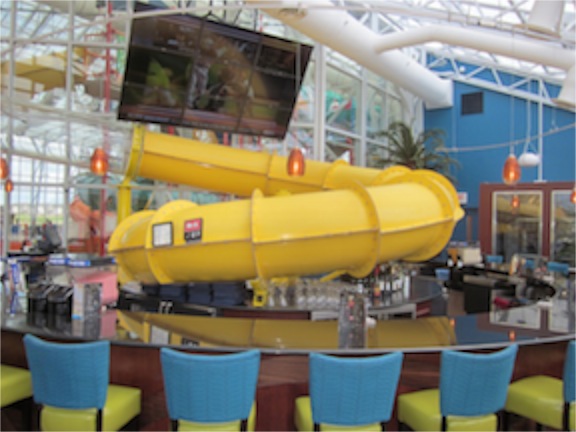

What if we decided that instead of more organized activities, children needed more free time? What if instead of developing trail systems, we decided children needed more empty lots? What if instead of forming more leagues, we took more picnics? And here is a radical suggestion: what if families set aside one day each week with no other purpose but to give thanks to God and spend time with each other?
OK that last one is a commandment. One of my teachers once said, “How do we expect to get people to obey commandments about adultery, stealing and murder when we can’t get them to observe the Sabbath?”
Still, now that I’ve become a grandfather and what many consider to be a grumpy old man, I’ve decided that I support less structure – not more for children. We don’t need more programs and planned activities. We need more days off. We don’t need more ballparks and soccer fields. We need more sandlots and open space. We don’t need more landscaping and manicured lawns. We need more plants that children can pick and places where they can get dirty.
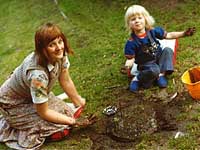
Copyright © 2012 by Ted Huffman. I wrote this. If you want to copy it, please ask for permission. There is a contact me button at the bottom of this page. If you want to share my blog a friend, please direct your friend to my web site.
Y'all come back now
29/03/12 05:18
Earl Scruggs was born in Cleveland County, North Carolina. His daddy, George Elam Scruggs was a farmer and a bookkeeper. He was also a fiddle player. His momma, Lula Ruppe Scruggs, played the organ. He was the fifth child. His older brothers, Junie and Horace, and his older sisters, Eula Mae and Ruby, all played he banjo and guitar. He was born into a musical family. But he was also born to a place where music was the only form of entertainment. Music is what they did to keep their spirits up in really tough times. He once said, “My music came up from the soil of North Carolina.” And times were about to get much harder.
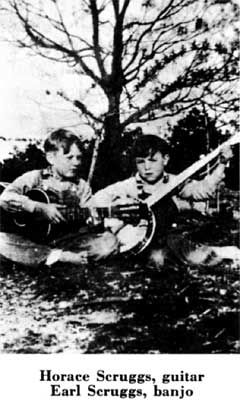 Earl’s daddy died after a long illness when the boy was only four years old. As an adult, Earl said he could remember his daddy, but not his daddy playing the banjo. Still, the boy picked up the banjo around the time of his father’s death. He started playing Junie’s banjo or the one his father played. He was so small that the only way he could play the thing was to sit on the floor with the body of the banjo to his right. He’d slide the instrument around quite a bit, depending on what position on the neck he was attempting to play. He started out with his own self-taught two-finger picking style.
Earl’s daddy died after a long illness when the boy was only four years old. As an adult, Earl said he could remember his daddy, but not his daddy playing the banjo. Still, the boy picked up the banjo around the time of his father’s death. He started playing Junie’s banjo or the one his father played. He was so small that the only way he could play the thing was to sit on the floor with the body of the banjo to his right. He’d slide the instrument around quite a bit, depending on what position on the neck he was attempting to play. He started out with his own self-taught two-finger picking style.
The nation spiraled toward the Great Depression. Earl’s family struggled to have enough food to put on the table. Earl was the baby. He was allowed the opportunity to play, though there wasn’t much in the way of toys. No matter, Earl preferred the banjo for every moment that he was allowed to escape from chores or school. By the time he was 10 he got his own banjo – a $10.95 Montgomery-Ward mail order model. It was on that banjo that he developed the three-finger style that launched the rebirth of the traditional instrument. To this day the style is known as “Scruggs-Style Picking.” The style of picking that he developed wasn’t heard anywhere else except in that small region in North Carolina. Nobody played it any better than Earl. He could emphasize the melody while ornamenting it with rolls and melody. The thumb, index and middle fingers of his right hand moved so fast that other players couldn’t even observe, let alone imitate his style.
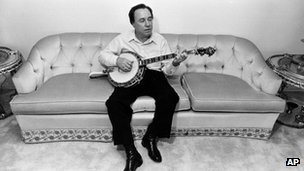 By 1945, Earl was playing a Gibson RB-11 banjo with Bill Monroe’s Blue Grass Boys. That is where he met Lester Flatt. Scruggs and Flatt left the band and formed the Foggy Mountain Boys in 1948, but the band was mostly known simply as Flatt and Scruggs until 1969 when Earl and his sons formed the Earl Scruggs Revue.
By 1945, Earl was playing a Gibson RB-11 banjo with Bill Monroe’s Blue Grass Boys. That is where he met Lester Flatt. Scruggs and Flatt left the band and formed the Foggy Mountain Boys in 1948, but the band was mostly known simply as Flatt and Scruggs until 1969 when Earl and his sons formed the Earl Scruggs Revue.
If you don’t know anything about country music, you know the music of Earl Scruggs. Think of the music during the car chases in the movie “Bonnie and Clyde.” Think “The Ballad of Jed Clampett” from the TV show, “The Beverly Hillbillies.” The song was played at the beginning and the end of every episode. Flatt and Scruggs appeared in several episodes, always playing the part of friends of the Clampett family.
Here is what I remember: In 1969, he played “Foggy Mountain Breakdown” on an open-air stage in Washington D.C., at the Moratorium to End the War in Vietnam. There weren’t many bluegrass or country-Western artists in the anti-war movement. They were more likely to ascribe to the “fly the flag and support the troops” position. Earl said: “I think the people in the South is just as concerned as the people that’s walkin’ the streets here today . . . I’m sincere about bringing our boys back home. I’m disgusted and in sorrow about the boys we’ve lost over there. And if I could see a good reason to continue, I wouldn’t be here today.”
That song, “Foggy Mountain Breakdown” won Scruggs a Grammy that year. It was instrumental in assuring him a place in the Country Music Hall of Fame, a National Heritage Fellowship, a National Medal of Arts, and a spot in the International Bluegrass Hall of Honor. He has a star on the Hollywood Walk of Fame. There are so many honors earned over the years that it is difficult to compile the whole list.
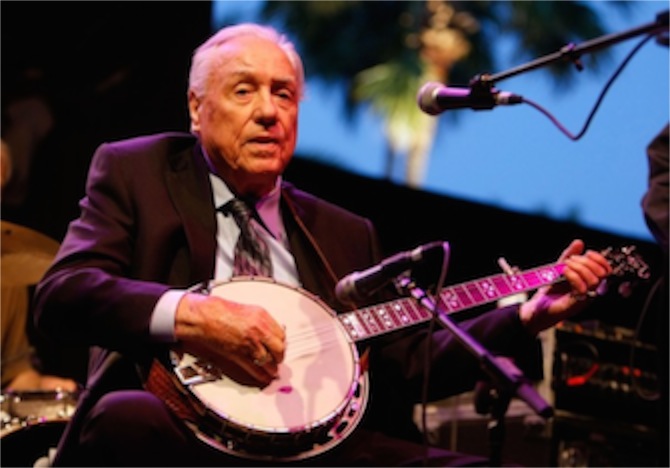 And what he loved best was making music with other folks. Over the years he recorded with Doc Watson, John Fogerty, Elton John, Sting, Johnny Cash, Don Henley, Travis Tritt, Billy Bob Thornton and many others. He played with Vince Gill and Albert Lee on electric guitar, with Paul Shaffer on the piano, with Leon Russell on the organ, and Marty Stuart on mandolin. He even played with Steve Martin.
And what he loved best was making music with other folks. Over the years he recorded with Doc Watson, John Fogerty, Elton John, Sting, Johnny Cash, Don Henley, Travis Tritt, Billy Bob Thornton and many others. He played with Vince Gill and Albert Lee on electric guitar, with Paul Shaffer on the piano, with Leon Russell on the organ, and Marty Stuart on mandolin. He even played with Steve Martin.
Earl’s wife was also his manager and they formed a great team until she died in 2006 after a long illness.
Yesterday, the 60+ year performing career came to its end. Earl died in a Nashville hospital of natural causes. He was 88 years old.
He may have died, but the music continues. Sons Gary and Randy are both musicians. Another son, Steve, was a drummer but died tragically in 1992. The music will also continue in generations of banjo players who will play his recordings as they attempt to master that three-finger style. And Earl wouldn’t want the world to keep listening to the same old songs played over and over. While he was a champion of traditional music and certainly excelled playing the classics, Earl was always looking for new sounds. “If you don’t let things develop, it’s like keeping something in a bag and not letting it out to fly,” he said in 2000. “There’s so many different types of music that you can put together to come up with a fresh sound. So that’s been the whole thing, to try to play something that sounded good. You never know until you try it out.”
You’ll never know until you try it out. Earl’s trying out new tunes in a new place these days. I’m betting it’s a fresh sound. And I know it sounds real good.
Thanks, ol’ Banjo picker. The music has been great!

The nation spiraled toward the Great Depression. Earl’s family struggled to have enough food to put on the table. Earl was the baby. He was allowed the opportunity to play, though there wasn’t much in the way of toys. No matter, Earl preferred the banjo for every moment that he was allowed to escape from chores or school. By the time he was 10 he got his own banjo – a $10.95 Montgomery-Ward mail order model. It was on that banjo that he developed the three-finger style that launched the rebirth of the traditional instrument. To this day the style is known as “Scruggs-Style Picking.” The style of picking that he developed wasn’t heard anywhere else except in that small region in North Carolina. Nobody played it any better than Earl. He could emphasize the melody while ornamenting it with rolls and melody. The thumb, index and middle fingers of his right hand moved so fast that other players couldn’t even observe, let alone imitate his style.

If you don’t know anything about country music, you know the music of Earl Scruggs. Think of the music during the car chases in the movie “Bonnie and Clyde.” Think “The Ballad of Jed Clampett” from the TV show, “The Beverly Hillbillies.” The song was played at the beginning and the end of every episode. Flatt and Scruggs appeared in several episodes, always playing the part of friends of the Clampett family.
Here is what I remember: In 1969, he played “Foggy Mountain Breakdown” on an open-air stage in Washington D.C., at the Moratorium to End the War in Vietnam. There weren’t many bluegrass or country-Western artists in the anti-war movement. They were more likely to ascribe to the “fly the flag and support the troops” position. Earl said: “I think the people in the South is just as concerned as the people that’s walkin’ the streets here today . . . I’m sincere about bringing our boys back home. I’m disgusted and in sorrow about the boys we’ve lost over there. And if I could see a good reason to continue, I wouldn’t be here today.”
That song, “Foggy Mountain Breakdown” won Scruggs a Grammy that year. It was instrumental in assuring him a place in the Country Music Hall of Fame, a National Heritage Fellowship, a National Medal of Arts, and a spot in the International Bluegrass Hall of Honor. He has a star on the Hollywood Walk of Fame. There are so many honors earned over the years that it is difficult to compile the whole list.

Earl’s wife was also his manager and they formed a great team until she died in 2006 after a long illness.
Yesterday, the 60+ year performing career came to its end. Earl died in a Nashville hospital of natural causes. He was 88 years old.
He may have died, but the music continues. Sons Gary and Randy are both musicians. Another son, Steve, was a drummer but died tragically in 1992. The music will also continue in generations of banjo players who will play his recordings as they attempt to master that three-finger style. And Earl wouldn’t want the world to keep listening to the same old songs played over and over. While he was a champion of traditional music and certainly excelled playing the classics, Earl was always looking for new sounds. “If you don’t let things develop, it’s like keeping something in a bag and not letting it out to fly,” he said in 2000. “There’s so many different types of music that you can put together to come up with a fresh sound. So that’s been the whole thing, to try to play something that sounded good. You never know until you try it out.”
You’ll never know until you try it out. Earl’s trying out new tunes in a new place these days. I’m betting it’s a fresh sound. And I know it sounds real good.
Thanks, ol’ Banjo picker. The music has been great!
Copyright © 2012 by Ted Huffman. I wrote this. If you want to copy it, please ask for permission. There is a contact me button at the bottom of this page. If you want to share my blog a friend, please direct your friend to my web site.
Still looking for hope
28/03/12 05:59
One of the tasks of physicians is to treat pain. People are motivated to go into the healing arts because they want to decrease the amount of suffering in the world. But pain is a tricky matter. It has a function in healing. Pain can be a signal to the body to cease motion in an injured area, allowing time for bones to knit. The decreased motion can result, however, in atrophy of muscle strength. The human body has amazing qualities of self-healing, but there are things that can be done to enhance healing and to decrease the discomfort of the affected person.
Since ancient times healers have known of certain substances that can be used to decrease pain. Long before scientists understood the workings of the nervous system, they discovered that there were certain plants that, if administered, could decrease pain. As is true with many things in life, however, most painkilling substances have unintended consequences. There are side effects that come from the painkillers. One problem with some painkillers is that they create a sense of well being that invites use in circumstances where no physical pain exists. These drugs are highly addictive and once abuse begins it is nearly impossible for the addict to stop use. People will destroy relationships and their very lives in search of the high caused by the drug.
In the early part of the 20th century, the German pharmaceutical company Bayer stopped the mass production of heroin due to hazardous use, addiction and harmful side effects. Despite the altered dynamics when a patient is suffering from extreme pain with a condition that cannot be cured, the abuse of drugs by those not in such a position created such suffering that it was decided to stop production of the drug in mass quantities. The problems of heroin addiction were far greater than the benefits of the medicine. Scientists searched carefully for alternative drugs to help ease pain for those suffering serious illness or injury.
Among the synthetic drugs that were developed is Oxycodone. It was hoped that the drug would provide the benefits of morphine and heroin with less dependence. That is somewhat true. Oxycodone has a somewhat milder initial effect and the effect does not last as long.
We in the United States are the highest consumers of pain medications. Approximately 82% of all Oxycodone produced worldwide is consumed in the United States. Brand names include OxyContin and Percocet. Canada is the second largest consumer of these medicines.
 The US and Canada are also the locations of the most devastating forms of abuse of Oxycodone. The effects of the abuse are especially evident in isolated communities in northern Canada. Fort Hope is a community in northern Ontario that is so isolated that no roads reach the community. It is a three-hour flight to the nearest airport with connections to the rest of Canada. In the winter, ice roads are opened across the lakes to allow trucks to arrive with supplies, but most residents have no cars to travel away from the community. Oxycodone and its abuse have arrived in Fort Hope. It is estimated that 80% of the people living in the community are addicted.
The US and Canada are also the locations of the most devastating forms of abuse of Oxycodone. The effects of the abuse are especially evident in isolated communities in northern Canada. Fort Hope is a community in northern Ontario that is so isolated that no roads reach the community. It is a three-hour flight to the nearest airport with connections to the rest of Canada. In the winter, ice roads are opened across the lakes to allow trucks to arrive with supplies, but most residents have no cars to travel away from the community. Oxycodone and its abuse have arrived in Fort Hope. It is estimated that 80% of the people living in the community are addicted.
Addicts crush the tablets, heat them and then inject the drug for an immediate feeling of well-being. It doesn’t last. And the need for the drug increases. The addiction is so strong that users think of little else and are willing to do almost anything to get their next hit. If they do not obtain another dose they go through severe withdrawal symptoms including anxiety, panic attack, nausea, muscle pain, fever and more.
The addiction brings with it financial devastation. In Fort Hope one OxyContin pill sells for $400 - $600. With the street price of $40 per tablet in Toronto, there is a lot of profit in transporting drugs into isolated places like Fort Hope. Recruiting addicts as mules for the drug trade is easy. Some addictions cost upwards of $2,000 per day. It is money that the people do not have. They literally sell or trade everything they have for the next hit. The addiction is destroying the community.
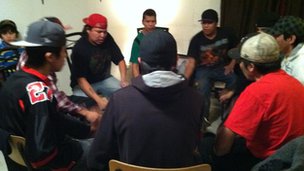 The local chief and council have set up a detox center in Fort Hope. The center uses another drug, Suboxone, to wean users. The center has the ability to treat four people at one time. There are seventy names on the waiting list. Chief Harry Papah has declared a state of emergency as a result of the surge in addiction. With the addiction has come a wave of violent crime including two murders and nearly 50 arson attacks.
The local chief and council have set up a detox center in Fort Hope. The center uses another drug, Suboxone, to wean users. The center has the ability to treat four people at one time. There are seventy names on the waiting list. Chief Harry Papah has declared a state of emergency as a result of the surge in addiction. With the addiction has come a wave of violent crime including two murders and nearly 50 arson attacks.
The crime wave and the state of emergency have resulted in increased law enforcement support from the Provence of Ontario. They are catching more drug smugglers. It is relatively easy to find the drugs at checkpoints in the airport or along the ice highway. The preferred trick of smugglers is to modify a Red Bull can into a place to carry the drugs. They have slowed the flow of the drug into the community.
The immediate short-term effect of increased law enforcement, however, is increased suffering. Interdiction causes the price to rise. Rising prices means more financial distress for addicts. Addicts take whatever they can from family members and friends in a desperate attempt to obtain the drug. Children are left without food in homes that have been stripped bare in search of items to exchange for drugs.
There isn’t much hope in Fort Hope these days.
Chief Harry Papah has now taken the extraordinary step of inviting reporters from BBC and other world news agencies to come to his community to report on the problem. Community leaders have come together to discuss possible solutions for the problem. Fund-raising has begun to increase the capacity of the detox center. Educational efforts have been raised. The number of people who are signing up for detox is increasing. There are a few signs that change is coming.
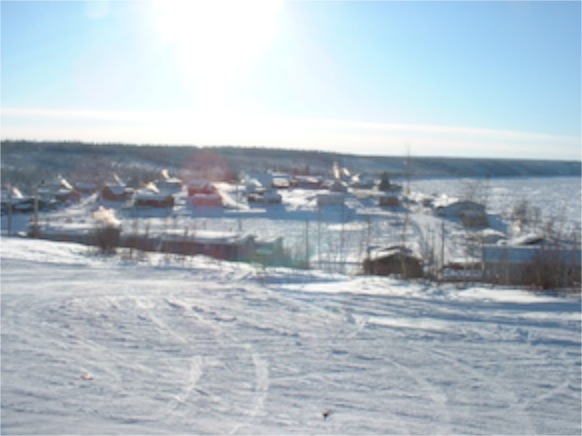 The people of Fort Hope and other native communities suffering under the weight of addictions don’t need simple solutions or easy fixes. They need long-term commitments from the wider community to address the root causes of addiction and to forge long-term solutions. It starts with raising awareness. The road ahead is long and fraught with danger.
The people of Fort Hope and other native communities suffering under the weight of addictions don’t need simple solutions or easy fixes. They need long-term commitments from the wider community to address the root causes of addiction and to forge long-term solutions. It starts with raising awareness. The road ahead is long and fraught with danger.
The people of the North Country are strong people. Their very existence has depended on the ability to live in conditions that others cannot imagine. They have developed courage and resourcefulness born of a harsh climate. Those virtues will come to the fore as they struggle with the challenges of this day. All is not lost, but tiny pills, smuggled in from the cities, will prove to be one of the toughest dangers the people have ever faced.
I hope that in years to come it will become the focus of story and legend and song as the elders teach younger members of the community the history of their people and the dangers they have overcome.
Since ancient times healers have known of certain substances that can be used to decrease pain. Long before scientists understood the workings of the nervous system, they discovered that there were certain plants that, if administered, could decrease pain. As is true with many things in life, however, most painkilling substances have unintended consequences. There are side effects that come from the painkillers. One problem with some painkillers is that they create a sense of well being that invites use in circumstances where no physical pain exists. These drugs are highly addictive and once abuse begins it is nearly impossible for the addict to stop use. People will destroy relationships and their very lives in search of the high caused by the drug.
In the early part of the 20th century, the German pharmaceutical company Bayer stopped the mass production of heroin due to hazardous use, addiction and harmful side effects. Despite the altered dynamics when a patient is suffering from extreme pain with a condition that cannot be cured, the abuse of drugs by those not in such a position created such suffering that it was decided to stop production of the drug in mass quantities. The problems of heroin addiction were far greater than the benefits of the medicine. Scientists searched carefully for alternative drugs to help ease pain for those suffering serious illness or injury.
Among the synthetic drugs that were developed is Oxycodone. It was hoped that the drug would provide the benefits of morphine and heroin with less dependence. That is somewhat true. Oxycodone has a somewhat milder initial effect and the effect does not last as long.
We in the United States are the highest consumers of pain medications. Approximately 82% of all Oxycodone produced worldwide is consumed in the United States. Brand names include OxyContin and Percocet. Canada is the second largest consumer of these medicines.

Addicts crush the tablets, heat them and then inject the drug for an immediate feeling of well-being. It doesn’t last. And the need for the drug increases. The addiction is so strong that users think of little else and are willing to do almost anything to get their next hit. If they do not obtain another dose they go through severe withdrawal symptoms including anxiety, panic attack, nausea, muscle pain, fever and more.
The addiction brings with it financial devastation. In Fort Hope one OxyContin pill sells for $400 - $600. With the street price of $40 per tablet in Toronto, there is a lot of profit in transporting drugs into isolated places like Fort Hope. Recruiting addicts as mules for the drug trade is easy. Some addictions cost upwards of $2,000 per day. It is money that the people do not have. They literally sell or trade everything they have for the next hit. The addiction is destroying the community.

The crime wave and the state of emergency have resulted in increased law enforcement support from the Provence of Ontario. They are catching more drug smugglers. It is relatively easy to find the drugs at checkpoints in the airport or along the ice highway. The preferred trick of smugglers is to modify a Red Bull can into a place to carry the drugs. They have slowed the flow of the drug into the community.
The immediate short-term effect of increased law enforcement, however, is increased suffering. Interdiction causes the price to rise. Rising prices means more financial distress for addicts. Addicts take whatever they can from family members and friends in a desperate attempt to obtain the drug. Children are left without food in homes that have been stripped bare in search of items to exchange for drugs.
There isn’t much hope in Fort Hope these days.
Chief Harry Papah has now taken the extraordinary step of inviting reporters from BBC and other world news agencies to come to his community to report on the problem. Community leaders have come together to discuss possible solutions for the problem. Fund-raising has begun to increase the capacity of the detox center. Educational efforts have been raised. The number of people who are signing up for detox is increasing. There are a few signs that change is coming.

The people of the North Country are strong people. Their very existence has depended on the ability to live in conditions that others cannot imagine. They have developed courage and resourcefulness born of a harsh climate. Those virtues will come to the fore as they struggle with the challenges of this day. All is not lost, but tiny pills, smuggled in from the cities, will prove to be one of the toughest dangers the people have ever faced.
I hope that in years to come it will become the focus of story and legend and song as the elders teach younger members of the community the history of their people and the dangers they have overcome.
Copyright © 2012 by Ted Huffman. I wrote this. If you want to copy it, please ask for permission. There is a contact me button at the bottom of this page. If you want to share my blog a friend, please direct your friend to my web site.
Early Spring
27/03/12 05:18
It has been a strange winter here in the hills. The truth is that we had very little weather that was at all like winter. Instead, we had an extended fall that somehow drifted into an extended spring. It is not yet April and we have had lots of days with temperatures in the seventies. There is no ice in Sheridan Lake. The ice fishermen are cleaning out their boats and getting ready to take to the water.
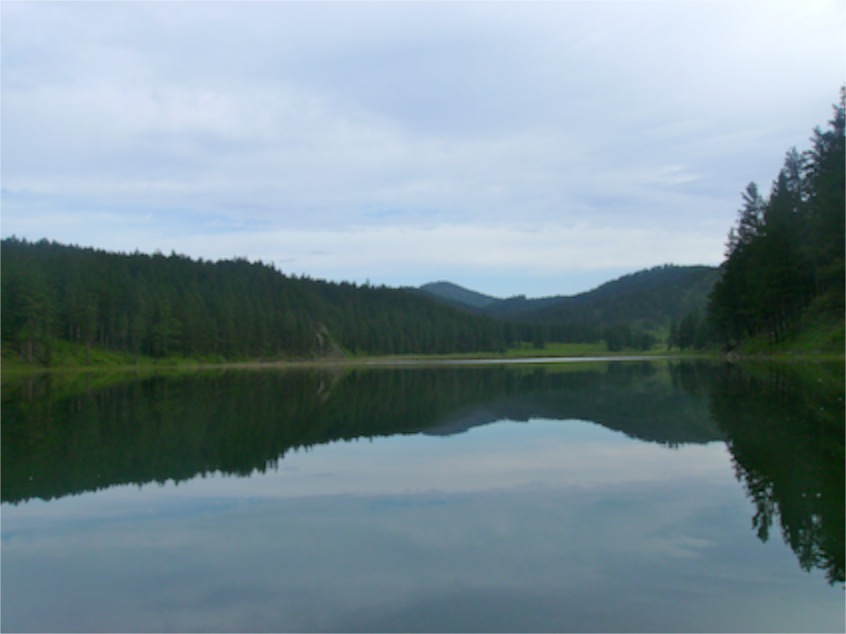 I pay a bit more attention to Sheridan Lake for the simple reason that it is close. The hills have no natural lakes, but we have several very nice reservoirs that hold water for use by the city and irrigators downstream and provide a place for recreation. When I get home from work, I am almost half way to Sheridan Lake. It is close enough for a paddle in the morning before I head to work or a paddle in the evening after a day’s work.
I pay a bit more attention to Sheridan Lake for the simple reason that it is close. The hills have no natural lakes, but we have several very nice reservoirs that hold water for use by the city and irrigators downstream and provide a place for recreation. When I get home from work, I am almost half way to Sheridan Lake. It is close enough for a paddle in the morning before I head to work or a paddle in the evening after a day’s work.
This time of year, however, I usually am not thinking about paddling. Some years I sneak out in late April or early May for my first paddle, but paddling is a summer sport around here and it is usually late May before there is much regular boating at Sheridan Lake. They put the docks in and but the buoys out sometime around the end of May anticipating the return of crowds to the campgrounds and day use areas around Memorial Day.
But this year is different. They opened one campground loop and two boat docks at Sheridan Lake yesterday. The North Ramp and part of the South Ramp are now available for folks who want to launch boats. As a canoeist and kayaker, I don’t need a boat ramp and don’t use the docks because it is easier to stay out of the way of the folks who need those facilities. I usually just walk down to the shore and launch my boats.
I’m sure that the forest officials know that we can get spring blizzards. I can remember a significant snowfall on May 11 one year not too far back. April blizzards can drop up to a couple of feet of snow. Most of us who are living in the hills would be delighted to see a good snowfall. Precipitation in any form will be welcome this year. It is dry out there, and we keep sniffing the wind for fire. There have already been a few small fires.
I’ve fallen prey to premature spring fever as well. Last night I was outside cooking on the barbecue when thunderstorms rolled through the area. The wind blew and lightning crackled – not a good sign for a fire-anxious part of the world. It was a bit strange, however, to have thunderstorms build up in March. This morning, the local newspaper web site reports several storm-related fires, but nothing too large. Lightening sparked a 2-acre grass fire near Rochford. We saw the brush truck from our local volunteer fire department heading toward a 10-acre burn north of Fairburn. That fire was caused when winds blew down power poles that in turn sparked the blaze. A transformer and pole burned near Johnson Siding when lighting hit the pole.
Here at the house we got quite a bit of rain, which is welcome. Rain is good, but when there is lightning and rain, fires can smolder in wet fuels and then flare up the next day when the fuels dry out. We’ll be watching the hills for puffs of smoke and sniffing the air for the smell of fires all day today.
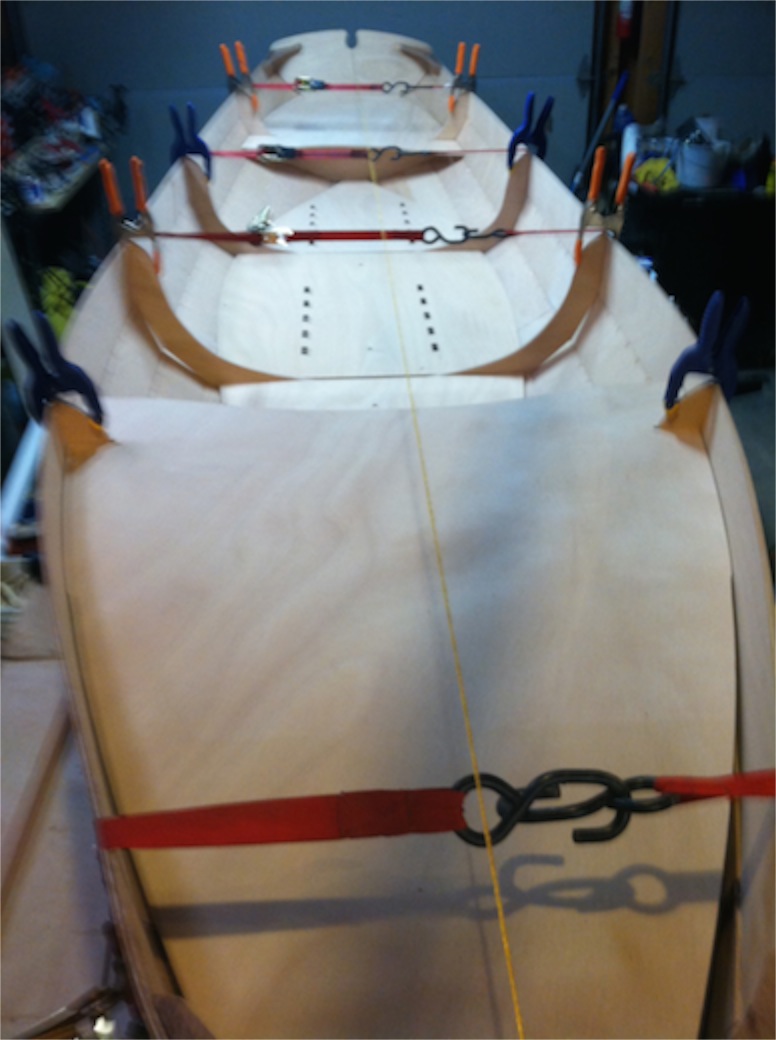 I enjoy the warm weather as much as anyone. I’ve been driving around town with the windows down since February. But I’m not really eager for summer to come quite yet. Part of the reason is that I have a winter project going in my garage. I am building a rowboat. A rowboat is a good craft to have around young children. It is stable and secure and can be maneuvered slowly. It has capacity to take along a parent to hold the child. So a rowboat is something that a grandpa could use. In addition, I am working hard at reforming my own lifestyle. I have changed my eating patterns and have taken off a significant amount of weight since the first of the year, but I have a long way to go before hitting my ideal weight. A good exercise program needs to be part of my plan. While I like to paddle and have used paddling as a big part of summer exercise for years, it mostly builds upper body strength. Sitting or kneeling while you let your arms and shoulders do all of the work is hardly a full-body workout. It does nothing for the ring of fat that has settled around my waist. Rowing is just better exercise for someone whose body is shaped like mine. In fact they make sliding rowing seats for an even better workout. So the rowboat is an indulgence and an investment in health.
I enjoy the warm weather as much as anyone. I’ve been driving around town with the windows down since February. But I’m not really eager for summer to come quite yet. Part of the reason is that I have a winter project going in my garage. I am building a rowboat. A rowboat is a good craft to have around young children. It is stable and secure and can be maneuvered slowly. It has capacity to take along a parent to hold the child. So a rowboat is something that a grandpa could use. In addition, I am working hard at reforming my own lifestyle. I have changed my eating patterns and have taken off a significant amount of weight since the first of the year, but I have a long way to go before hitting my ideal weight. A good exercise program needs to be part of my plan. While I like to paddle and have used paddling as a big part of summer exercise for years, it mostly builds upper body strength. Sitting or kneeling while you let your arms and shoulders do all of the work is hardly a full-body workout. It does nothing for the ring of fat that has settled around my waist. Rowing is just better exercise for someone whose body is shaped like mine. In fact they make sliding rowing seats for an even better workout. So the rowboat is an indulgence and an investment in health.
See I can justify almost any project that I really want to undertake.
Still, the boat is far from finished. It is blocked up, but there is no small amount of work left before it is ready to head for the water. In general, when a boat is fully constructed and ready for sanding, paint and varnish, it is usually only about half way done. And I am weeks away from ordering the paint and varnish for this boat.
Despite the outdoor weather, spring is a time to sit and be patient. It would be OK to till the garden, and I’m sure that some people are already setting plants out that they can cover with greenhouse structures if the weather turns cold. But while we may debate whether Mother’s Day or Memorial Day is the best time to set out tomatoes, we all know that it is too early for some planting. Spring is a season of waiting.
 Still, with the docks in the water and the campground open, I’m glad that the rowboat isn’t my only watercraft. I may have to head for the lake with a canoe before the rowboat is finished. After all, carrying a canoe down to the shore is good exercise.
Still, with the docks in the water and the campground open, I’m glad that the rowboat isn’t my only watercraft. I may have to head for the lake with a canoe before the rowboat is finished. After all, carrying a canoe down to the shore is good exercise.

This time of year, however, I usually am not thinking about paddling. Some years I sneak out in late April or early May for my first paddle, but paddling is a summer sport around here and it is usually late May before there is much regular boating at Sheridan Lake. They put the docks in and but the buoys out sometime around the end of May anticipating the return of crowds to the campgrounds and day use areas around Memorial Day.
But this year is different. They opened one campground loop and two boat docks at Sheridan Lake yesterday. The North Ramp and part of the South Ramp are now available for folks who want to launch boats. As a canoeist and kayaker, I don’t need a boat ramp and don’t use the docks because it is easier to stay out of the way of the folks who need those facilities. I usually just walk down to the shore and launch my boats.
I’m sure that the forest officials know that we can get spring blizzards. I can remember a significant snowfall on May 11 one year not too far back. April blizzards can drop up to a couple of feet of snow. Most of us who are living in the hills would be delighted to see a good snowfall. Precipitation in any form will be welcome this year. It is dry out there, and we keep sniffing the wind for fire. There have already been a few small fires.
I’ve fallen prey to premature spring fever as well. Last night I was outside cooking on the barbecue when thunderstorms rolled through the area. The wind blew and lightning crackled – not a good sign for a fire-anxious part of the world. It was a bit strange, however, to have thunderstorms build up in March. This morning, the local newspaper web site reports several storm-related fires, but nothing too large. Lightening sparked a 2-acre grass fire near Rochford. We saw the brush truck from our local volunteer fire department heading toward a 10-acre burn north of Fairburn. That fire was caused when winds blew down power poles that in turn sparked the blaze. A transformer and pole burned near Johnson Siding when lighting hit the pole.
Here at the house we got quite a bit of rain, which is welcome. Rain is good, but when there is lightning and rain, fires can smolder in wet fuels and then flare up the next day when the fuels dry out. We’ll be watching the hills for puffs of smoke and sniffing the air for the smell of fires all day today.

See I can justify almost any project that I really want to undertake.
Still, the boat is far from finished. It is blocked up, but there is no small amount of work left before it is ready to head for the water. In general, when a boat is fully constructed and ready for sanding, paint and varnish, it is usually only about half way done. And I am weeks away from ordering the paint and varnish for this boat.
Despite the outdoor weather, spring is a time to sit and be patient. It would be OK to till the garden, and I’m sure that some people are already setting plants out that they can cover with greenhouse structures if the weather turns cold. But while we may debate whether Mother’s Day or Memorial Day is the best time to set out tomatoes, we all know that it is too early for some planting. Spring is a season of waiting.

Copyright © 2012 by Ted Huffman. I wrote this. If you want to copy it, please ask for permission. There is a contact me button at the bottom of this page. If you want to share my blog a friend, please direct your friend to my web site.
Why we support chamber music
26/03/12 05:28
The myth of perpetual growth is just that: a myth. Bigger is not always better. But that doesn’t stop us from basing our society and our economy on the myth. It is a matter of simple math, really. If you combine the fantasy that each succeeding generation should be more wealthy than the previous one with the growth in world population it is obvious that the planet does not hold enough resources to sustain the growth. At some point something has to give. While we do have the resources to provide adequate nutrition and simple shelter for all of the world’s population, we do not have the resources, ability or will to provide everyone with high levels of luxury.
There are a few people who have discovered the beauty of living more simply. They find joy in homes that are smaller, easier to clean and maintain and demand less energy to heat and cool. They are content with less consumption and invest instead in quality items that last a long time. They given themselves the gift of time by freeing themselves from the grind of working more and more hours to sustain an ever growing lifestyle.
Urban planners tell us that successful cities are attentive to neighborhoods. Individuals and families might identify with the greater city, but they are only able to make their homes within a network of neighbors where they can become known. There is a natural limit to the capacity of a person to know others on a first-name basis. There is a limit to the number of friendships that can be nurtured with a finite amount of time. People are happiest when they find themselves to be surrounded by community. And community is a function of smallness not of largeness. People feel lost and experience a loss of community when institutions grow too big.
It is for this reason that big banks do their business through many small branch offices. It is for this reason that mega churches focus on small group ministries. It is for this reason that the most successful chain of coffee houses plans small neighborhood gathering places instead of large bustling centers.
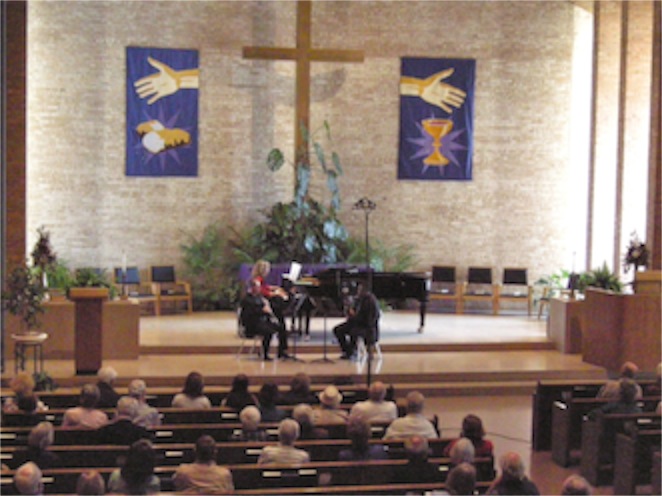 It is because we believe in community that our church is pleased to sponsor chamber music. Chamber music is composed and performed with specific attention to the size of the production. The name “chamber music” is a reference to the size of the room where the music is to be performed. It is not concert hall music. It is not grand opera music. It is chamber music. And the size of the room dictates the size of the audience.
It is because we believe in community that our church is pleased to sponsor chamber music. Chamber music is composed and performed with specific attention to the size of the production. The name “chamber music” is a reference to the size of the room where the music is to be performed. It is not concert hall music. It is not grand opera music. It is chamber music. And the size of the room dictates the size of the audience.
Ear-splitting rock concerts with masses of bodies crammed into rooms by the thousands or fans spilling beyond the boundaries of an outdoor venue while the thumping sound of the giant speakers carries far beyond even the massive crowd may be cultural events. In general they are not good places to make new friends or form neighborhood networks.
Chamber music is based on the simple conviction that bigger is not always better. The result is that concert audiences are small enough that the members of the audience get to know one another. Yesterday, as the time for the concert at our church came, one regular attendee came rushing in at the last minute. I was standing next to the man punching tickets at the door to the room. He greeted the concertgoer like this: “Good. We can begin now that you’re here.” They weren’t literally holding up the beginning of the concert for this one ticket holder, but it was noted that her presence was treasured and her attendance was appreciated.
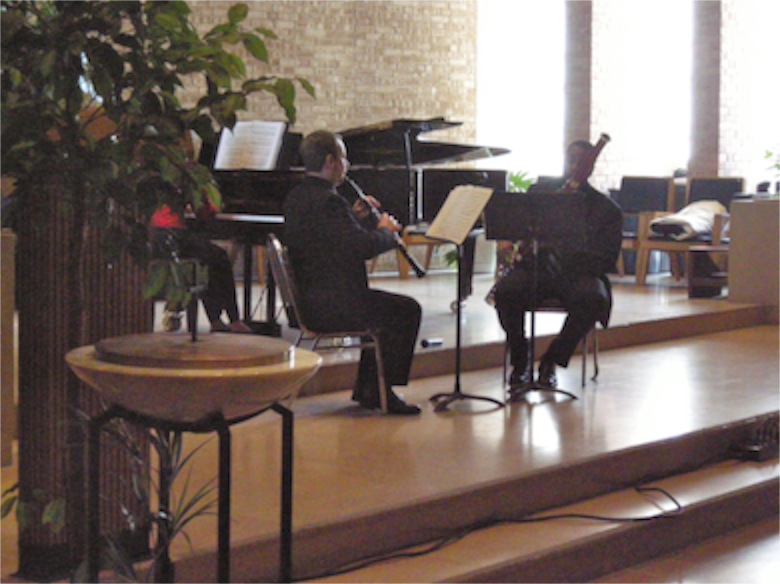 Our congregation is pleased to sponsor chamber music in our town precisely because it is one of the ways that we build community. There are larger venues in our community. There are bigger halls. And there are musical events with bigger audiences. But we are investing in a style of music that is more intimate: a gathering of friends.
Our congregation is pleased to sponsor chamber music in our town precisely because it is one of the ways that we build community. There are larger venues in our community. There are bigger halls. And there are musical events with bigger audiences. But we are investing in a style of music that is more intimate: a gathering of friends.
Yesterday’s concert was a delightful trio of piano, oboe and bassoon. The Polenc Trio presented a thrilling and delightful concert that demonstrated their unique instrumental combination and their practiced artistry. Double reed instruments often play a supporting role in a symphony orchestra. Hearing them in our sanctuary provided a different way to get to know the virtuosity of the instruments in the hands of masters. After a 90-minute concert, the audience was still begging for more. They were rewarded with an encore.
As is the custom with the Black Hills Chamber Music Society, the concert was followed by an artists’ reception, where the audience had the opportunity to speak face to face with the performers. Over a few light refreshments, they were able to express their appreciation of the music directly to the artists who performed it.
The press gives plenty of attention to a few megachurches. These giant institutions count their members by the thousands and boast growth rates of 5% per year and sometimes more. But there are other statistics that are often ignored. 45% of participants in megachurches do no volunteer work in the church. And even with their massive sizes, their members represent a small minority of American Christians. The majority of Christians belong to much smaller churches. Congregations of less than 500 members are still preferred by the majority of American Christians. It can be difficult to become involved in a congregation that has thousands of people. It is easy to get lost in the crowd. It is easy to believe that you are not needed when the church is too big.
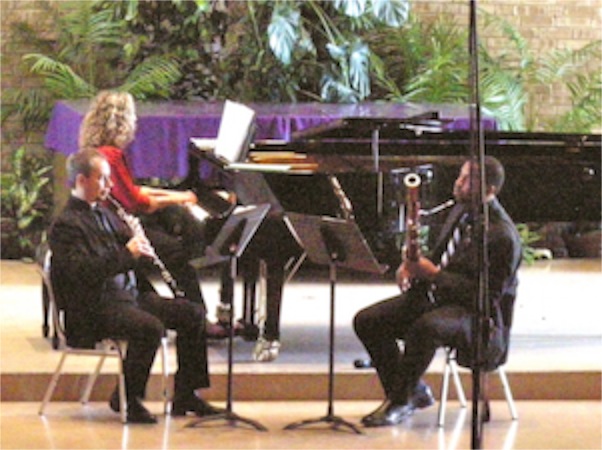 It pleases me to know that our congregation continues to invest in things that are not based on continual growth, but rather is content to remain small, intimate and a gathering of friends. We are in the relationship business, not in a race to become the biggest, though we sometimes forget this fact. It is easy to become seduced by the popular notion that you have to grow in numbers to remain vital.
It pleases me to know that our congregation continues to invest in things that are not based on continual growth, but rather is content to remain small, intimate and a gathering of friends. We are in the relationship business, not in a race to become the biggest, though we sometimes forget this fact. It is easy to become seduced by the popular notion that you have to grow in numbers to remain vital.
There was no lack of vitality in yesterday’s concert. You do not have to be big to be alive.
There are a few people who have discovered the beauty of living more simply. They find joy in homes that are smaller, easier to clean and maintain and demand less energy to heat and cool. They are content with less consumption and invest instead in quality items that last a long time. They given themselves the gift of time by freeing themselves from the grind of working more and more hours to sustain an ever growing lifestyle.
Urban planners tell us that successful cities are attentive to neighborhoods. Individuals and families might identify with the greater city, but they are only able to make their homes within a network of neighbors where they can become known. There is a natural limit to the capacity of a person to know others on a first-name basis. There is a limit to the number of friendships that can be nurtured with a finite amount of time. People are happiest when they find themselves to be surrounded by community. And community is a function of smallness not of largeness. People feel lost and experience a loss of community when institutions grow too big.
It is for this reason that big banks do their business through many small branch offices. It is for this reason that mega churches focus on small group ministries. It is for this reason that the most successful chain of coffee houses plans small neighborhood gathering places instead of large bustling centers.

Ear-splitting rock concerts with masses of bodies crammed into rooms by the thousands or fans spilling beyond the boundaries of an outdoor venue while the thumping sound of the giant speakers carries far beyond even the massive crowd may be cultural events. In general they are not good places to make new friends or form neighborhood networks.
Chamber music is based on the simple conviction that bigger is not always better. The result is that concert audiences are small enough that the members of the audience get to know one another. Yesterday, as the time for the concert at our church came, one regular attendee came rushing in at the last minute. I was standing next to the man punching tickets at the door to the room. He greeted the concertgoer like this: “Good. We can begin now that you’re here.” They weren’t literally holding up the beginning of the concert for this one ticket holder, but it was noted that her presence was treasured and her attendance was appreciated.

Yesterday’s concert was a delightful trio of piano, oboe and bassoon. The Polenc Trio presented a thrilling and delightful concert that demonstrated their unique instrumental combination and their practiced artistry. Double reed instruments often play a supporting role in a symphony orchestra. Hearing them in our sanctuary provided a different way to get to know the virtuosity of the instruments in the hands of masters. After a 90-minute concert, the audience was still begging for more. They were rewarded with an encore.
As is the custom with the Black Hills Chamber Music Society, the concert was followed by an artists’ reception, where the audience had the opportunity to speak face to face with the performers. Over a few light refreshments, they were able to express their appreciation of the music directly to the artists who performed it.
The press gives plenty of attention to a few megachurches. These giant institutions count their members by the thousands and boast growth rates of 5% per year and sometimes more. But there are other statistics that are often ignored. 45% of participants in megachurches do no volunteer work in the church. And even with their massive sizes, their members represent a small minority of American Christians. The majority of Christians belong to much smaller churches. Congregations of less than 500 members are still preferred by the majority of American Christians. It can be difficult to become involved in a congregation that has thousands of people. It is easy to get lost in the crowd. It is easy to believe that you are not needed when the church is too big.

There was no lack of vitality in yesterday’s concert. You do not have to be big to be alive.
Copyright © 2012 by Ted Huffman. I wrote this. If you want to copy it, please ask for permission. There is a contact me button at the bottom of this page. If you want to share my blog a friend, please direct your friend to my web site.
Phone Booths
25/03/12 05:28
A couple of years ago, we were in England visiting our daughter and, while walking around London, came on one of those iconic English phone booths. We stopped and our daughter posed for a few pictures. Afterward, she told us that it was “disgusting” in there – in need of a thorough cleaning. She didn’t call any one. The idea of a phone booth was strange to her. The idea of a telephone that is hooked up with a wire seems old-fashioned and obsolete to her.
 Who needs a phone booth when you have a cell phone in your pocket or purse? Apparently not very many people have such a need. You certainly don’t see pay phones around like you used to.
Who needs a phone booth when you have a cell phone in your pocket or purse? Apparently not very many people have such a need. You certainly don’t see pay phones around like you used to.
I remember when every public building had a pay phone. Many had full-blown phone booths with doors that close and a ventilator fan in the ceiling. I can remember a few of the old ones that were made out of wood before the more “modern” glass and metal ones that were more common later. In the back of the drug store in our hometown, there was a wooden phone booth with small windowpanes on the door. It had a leather seat and a shelf with a phone book and extra space for a notebook and a pencil.
I can also remember the rows of pay phones at O’Hare Airport in Chicago. We would walk by rows and rows of people talking on the phones as we headed down the concourse in the airport. In those days, you went out to the gate to meet an incoming party and you parked the car and walked your friend or family member to the gate and watched that person board the airplane.
 I don’t mean to be overly nostalgic, and I know that such reminiscences are interesting to people my age and boring to those who are younger. But I think that we need the comeback of the phone booth. Obviously, we don’t need pay phones any more. They simply wouldn’t make enough money to cover their expenses. It seems like everyone has a cell phone these days.
I don’t mean to be overly nostalgic, and I know that such reminiscences are interesting to people my age and boring to those who are younger. But I think that we need the comeback of the phone booth. Obviously, we don’t need pay phones any more. They simply wouldn’t make enough money to cover their expenses. It seems like everyone has a cell phone these days.
It also seems like they are constantly talking on their phones. All too often they are talking on their phones in inappropriate places at inappropriate times. You’ve seen enough drivers talking on their phones and distracted by the conversations to know what I mean. But cell phone use in other places is just as irritating, if not quite as dangerous. People talk on their phones in the checkout lane in the grocery store as if we couldn’t overhear their conversations – or worse, as if we should be listening to what they are saying. I’ve had to wait while someone finished a conversation on the phone to pay the checker. And it isn’t just grocery stores. There are people talking on the phone in restaurants, in office buildings, and in the lobby of the theater. I guess I should be glad that it is the lobby. So far many theatres maintain a ban on the use of cell phones in the actual theater, thank goodness. I’ve had meetings and personal conversations interrupted by the devices. It seems that a phone call or a text takes precedence over actual face-to-face conversation for some people.
I understand the convenience of cell phones in the case of emergencies. But emergencies are relatively rare in real life. Reminding someone to pick up clothes left at the cleaners is hardly an emergency. Calling to check in to see where someone else is doesn’t seem like a real emergency.
So I think we need phone booths in public places. We don’t need the pay phones – we just need a place for people to go to have their private conversations in private. The rest of us don’t need to hear what they have to say. And the people talking on the phone need to learn that there is a time and a place for everything. So, if we can’t teach them the time, at least we might provide the place.
 When we have been traveling recently, we have noticed that the phones in airports have been replaced by recharging stations. It seems that people have so many battery powered devices that they are almost constantly in need of recharging something and the waiting time in the airport is a good chance to make sure the batteries are charged for the next adventure. All it would take would be some little privacy walls with a little soundproofing and we could provide a place to isolate some of the conversations from the rest of the noise and hubbub of the airport.
When we have been traveling recently, we have noticed that the phones in airports have been replaced by recharging stations. It seems that people have so many battery powered devices that they are almost constantly in need of recharging something and the waiting time in the airport is a good chance to make sure the batteries are charged for the next adventure. All it would take would be some little privacy walls with a little soundproofing and we could provide a place to isolate some of the conversations from the rest of the noise and hubbub of the airport.
Of course providing the place doesn’t insure that people would use it. And, as is true of all public places, it would require frequent and careful cleaning. Getting people to use the space wouldn’t guarantee that they would keep it clean. After all, I am advocating providing a place for people who aren’t particularly thoughtful in their behavior already.
Having made the suggestion, I am sure that it probably wouldn’t work. Just providing the space doesn’t mean that people would use it. It seems that one of the qualities that many people have and that I lack is the ability to carry on a conversation without caring who overhears what you are saying. Perhaps it is the ability to simply ignore the other people in your immediate area. I’m not sure. I seem to not have that ability. I find myself talking so quietly on the phone in some locations that the person on the other end has trouble hearing me. In some places, I can’t hear the person on the other end of the phone.
Here is where a phone booth would really work, in my opinion. If there were phone booths in every public building, perhaps from time to time people like me could duck into the booth for a moment of peace and quiet and separation from all of the people outside of the booth who are yammering on their cell phones.

I remember when every public building had a pay phone. Many had full-blown phone booths with doors that close and a ventilator fan in the ceiling. I can remember a few of the old ones that were made out of wood before the more “modern” glass and metal ones that were more common later. In the back of the drug store in our hometown, there was a wooden phone booth with small windowpanes on the door. It had a leather seat and a shelf with a phone book and extra space for a notebook and a pencil.
I can also remember the rows of pay phones at O’Hare Airport in Chicago. We would walk by rows and rows of people talking on the phones as we headed down the concourse in the airport. In those days, you went out to the gate to meet an incoming party and you parked the car and walked your friend or family member to the gate and watched that person board the airplane.

It also seems like they are constantly talking on their phones. All too often they are talking on their phones in inappropriate places at inappropriate times. You’ve seen enough drivers talking on their phones and distracted by the conversations to know what I mean. But cell phone use in other places is just as irritating, if not quite as dangerous. People talk on their phones in the checkout lane in the grocery store as if we couldn’t overhear their conversations – or worse, as if we should be listening to what they are saying. I’ve had to wait while someone finished a conversation on the phone to pay the checker. And it isn’t just grocery stores. There are people talking on the phone in restaurants, in office buildings, and in the lobby of the theater. I guess I should be glad that it is the lobby. So far many theatres maintain a ban on the use of cell phones in the actual theater, thank goodness. I’ve had meetings and personal conversations interrupted by the devices. It seems that a phone call or a text takes precedence over actual face-to-face conversation for some people.
I understand the convenience of cell phones in the case of emergencies. But emergencies are relatively rare in real life. Reminding someone to pick up clothes left at the cleaners is hardly an emergency. Calling to check in to see where someone else is doesn’t seem like a real emergency.
So I think we need phone booths in public places. We don’t need the pay phones – we just need a place for people to go to have their private conversations in private. The rest of us don’t need to hear what they have to say. And the people talking on the phone need to learn that there is a time and a place for everything. So, if we can’t teach them the time, at least we might provide the place.

Of course providing the place doesn’t insure that people would use it. And, as is true of all public places, it would require frequent and careful cleaning. Getting people to use the space wouldn’t guarantee that they would keep it clean. After all, I am advocating providing a place for people who aren’t particularly thoughtful in their behavior already.
Having made the suggestion, I am sure that it probably wouldn’t work. Just providing the space doesn’t mean that people would use it. It seems that one of the qualities that many people have and that I lack is the ability to carry on a conversation without caring who overhears what you are saying. Perhaps it is the ability to simply ignore the other people in your immediate area. I’m not sure. I seem to not have that ability. I find myself talking so quietly on the phone in some locations that the person on the other end has trouble hearing me. In some places, I can’t hear the person on the other end of the phone.
Here is where a phone booth would really work, in my opinion. If there were phone booths in every public building, perhaps from time to time people like me could duck into the booth for a moment of peace and quiet and separation from all of the people outside of the booth who are yammering on their cell phones.
Copyright © 2012 by Ted Huffman. I wrote this. If you want to copy it, please ask for permission. There is a contact me button at the bottom of this page. If you want to share my blog a friend, please direct your friend to my web site.
The Heartbeat of Australia
24/03/12 05:09
We arrived at Uluru in the center of Australia in the middle of the day. We landed at Uluru airport having flown from Melbourne. My eyes were pinned to the window of the airplane as we flew across such an expanse of empty country. If you were to drive there, it would be over 1,400 miles Even with Australia’s lack of speed limits in the really empty country it would be 26 hours of driving. Flying took a few hours. It is amazing to see so much area with so few signs of habitation. Under the route we took, there were virtually not roads to be seen. As we descended, we got a glimpse of the enormous rock rising from the desert. Words do not describe what we saw.
 After picking up our rental car, figuring out where we would be staying, and catching a bite for lunch we entered Uluru-Kata Tjuta National Park. We spent the afternoon exploring Kata Tjuta, a series of amazing monoliths a short distance from the big rock. Our plan was to hike around Kata Tjuta in the afternoon, where there was plenty of shade. Even though we were visiting in the winter, we were still in the desert. That evening, as the sunset behind us, we watched the display of color on Uluru. The colors reflected by the giant rock ran the spectrum from red to orange to yellow to purple. Just watching the rock in the changing light was entertainment.
After picking up our rental car, figuring out where we would be staying, and catching a bite for lunch we entered Uluru-Kata Tjuta National Park. We spent the afternoon exploring Kata Tjuta, a series of amazing monoliths a short distance from the big rock. Our plan was to hike around Kata Tjuta in the afternoon, where there was plenty of shade. Even though we were visiting in the winter, we were still in the desert. That evening, as the sunset behind us, we watched the display of color on Uluru. The colors reflected by the giant rock ran the spectrum from red to orange to yellow to purple. Just watching the rock in the changing light was entertainment.
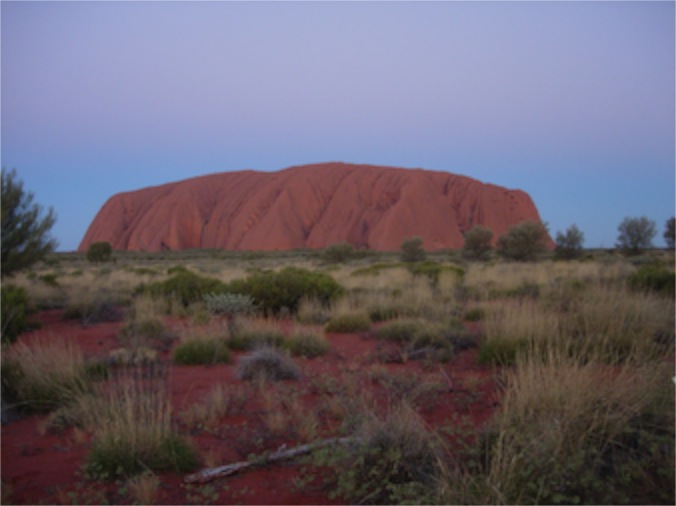 Just as the sun slipped beneath the horizon, when the top of the rock was still lit, but we were in darkness, it began to look as if it were slowly pulsing. I can’t describe it accurately. We knew it was a large rock. We knew it wasn’t moving, but the visual perception is of a slow pulsing in the fading light.
Just as the sun slipped beneath the horizon, when the top of the rock was still lit, but we were in darkness, it began to look as if it were slowly pulsing. I can’t describe it accurately. We knew it was a large rock. We knew it wasn’t moving, but the visual perception is of a slow pulsing in the fading light.
The experience was repeated the next morning after we arose in the dark and climbed to the top of a small hill to watch the sunrise. As the light began to play on the rock we could sense this pulse.
It was as if we could see the heartbeat of Australia.
When you are there, you have no difficulty understanding why this is a sacred site for the people who have lived in the red center of the continent for thousands of years. The Anangu may be the oldest continual culture on the planet. We learned more about them in our visit to the cultural center and our walkabout at the base of the rock the second day of our visit before we drove to Alice Springs for more adventures.
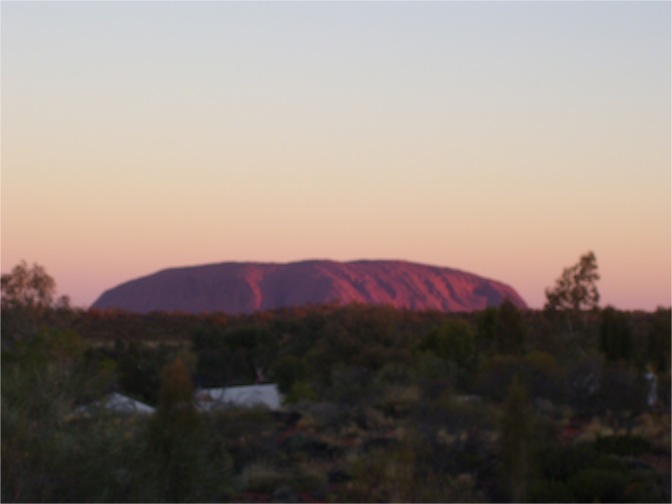 They say you could feel the earth move at Uluru yesterday.
They say you could feel the earth move at Uluru yesterday.
The 6.1 magnitude earthquake was one of the biggest earthquakes recorded in Australia – the largest in the last 15 years. Actually Uluru was more than 200 km (125 miles) away from the eipcenter.
Ernabella is home to a few hundred Anangu, with more living in the surrounding area. It is, to say the least, remote. If you find Alice Springs near the center of the continent on a map, Ernabella is 317 kilometers (197 miles) southwest of Alice Springs. Heading in the same direction you’d have to go another 415 km (258 miles) to get to another town, Coober Pedy, which itself isn’t exactly what you would call a big city.
At a magnitude of 6.1 and a depth of almost two miles, such an earthquake could cause damage up to 25 or more miles away. It could be felt as far as 315 miles away. Where the epicenter occurred, however, there were no injuries and there was no damage from the temblor. It was in a really, really, REALLY remote part of the country.
Australia is like that. The majority of the people are clustered in a few coastal cities and some farmland that surrounds those cities. The rest of the continent is very sparsely populated with few roads and few towns and lots of empty space between them.
Today we have the joy of once again making a trip to Eagle Butte to deliver some firewood. It is 171 miles and it takes a bit over 2½ hours to make the trip one way. We stop, so it will be about 3 hours from our departure time when we get there. Along the way, we’ll go through Sturgis and Newell and Faith – not exactly the biggest towns, but significant places with services and lots of people who call them home. I like to speak of such a trip as a journey across empty country because the traffic is light and there are plenty of places where the only signs of human activity we see are the highway, the power line and a few fences.
People in the more urban areas of the country have a bit of trouble getting their minds wrapped around the way we live out here. For us, driving 340 miles for a meeting or to deliver a bit of firewood is not big deal. For them, it is hard to figure out why someone would do so much driving for such a reason. I often have commented that having a pastor new to the state drive halfway across the state for a 30-minute interview with the Committee on Ministry and then drive halfway back across the state is a good introduction to our culture. If they are not from around here they will probably comment. Some will even complain. But it is our way of life. We are used to big spaces and lots of driving.
 The way we live is nothing compared to life in Australia’s outback. Most of the people who live at Erdnabella don’t have cars. They have no reason to own them and no money to buy such an expensive item. They live the way people have been living in the outback for as long as anyone can remember. They occasionally see a car or truck that comes from far away. They like some of the supplies that are delivered. Most of the people have seen airplanes the bring supplies to the area as well. But what they know is open space.
The way we live is nothing compared to life in Australia’s outback. Most of the people who live at Erdnabella don’t have cars. They have no reason to own them and no money to buy such an expensive item. They live the way people have been living in the outback for as long as anyone can remember. They occasionally see a car or truck that comes from far away. They like some of the supplies that are delivered. Most of the people have seen airplanes the bring supplies to the area as well. But what they know is open space.
The ground shook there yesterday, but no one was hurt. No damage was done. Life goes on. Sometimes you can see the heartbeat of Australia. Sometimes you can feel it. But you have to be willing to go to the remote places to experience such a bond with the world.


The experience was repeated the next morning after we arose in the dark and climbed to the top of a small hill to watch the sunrise. As the light began to play on the rock we could sense this pulse.
It was as if we could see the heartbeat of Australia.
When you are there, you have no difficulty understanding why this is a sacred site for the people who have lived in the red center of the continent for thousands of years. The Anangu may be the oldest continual culture on the planet. We learned more about them in our visit to the cultural center and our walkabout at the base of the rock the second day of our visit before we drove to Alice Springs for more adventures.

The 6.1 magnitude earthquake was one of the biggest earthquakes recorded in Australia – the largest in the last 15 years. Actually Uluru was more than 200 km (125 miles) away from the eipcenter.
Ernabella is home to a few hundred Anangu, with more living in the surrounding area. It is, to say the least, remote. If you find Alice Springs near the center of the continent on a map, Ernabella is 317 kilometers (197 miles) southwest of Alice Springs. Heading in the same direction you’d have to go another 415 km (258 miles) to get to another town, Coober Pedy, which itself isn’t exactly what you would call a big city.
At a magnitude of 6.1 and a depth of almost two miles, such an earthquake could cause damage up to 25 or more miles away. It could be felt as far as 315 miles away. Where the epicenter occurred, however, there were no injuries and there was no damage from the temblor. It was in a really, really, REALLY remote part of the country.
Australia is like that. The majority of the people are clustered in a few coastal cities and some farmland that surrounds those cities. The rest of the continent is very sparsely populated with few roads and few towns and lots of empty space between them.
Today we have the joy of once again making a trip to Eagle Butte to deliver some firewood. It is 171 miles and it takes a bit over 2½ hours to make the trip one way. We stop, so it will be about 3 hours from our departure time when we get there. Along the way, we’ll go through Sturgis and Newell and Faith – not exactly the biggest towns, but significant places with services and lots of people who call them home. I like to speak of such a trip as a journey across empty country because the traffic is light and there are plenty of places where the only signs of human activity we see are the highway, the power line and a few fences.
People in the more urban areas of the country have a bit of trouble getting their minds wrapped around the way we live out here. For us, driving 340 miles for a meeting or to deliver a bit of firewood is not big deal. For them, it is hard to figure out why someone would do so much driving for such a reason. I often have commented that having a pastor new to the state drive halfway across the state for a 30-minute interview with the Committee on Ministry and then drive halfway back across the state is a good introduction to our culture. If they are not from around here they will probably comment. Some will even complain. But it is our way of life. We are used to big spaces and lots of driving.

The ground shook there yesterday, but no one was hurt. No damage was done. Life goes on. Sometimes you can see the heartbeat of Australia. Sometimes you can feel it. But you have to be willing to go to the remote places to experience such a bond with the world.
Copyright © 2012 by Ted Huffman. I wrote this. If you want to copy it, please ask for permission. There is a contact me button at the bottom of this page. If you want to share my blog a friend, please direct your friend to my web site.
Selling the Farm
23/03/12 04:40

So in my household, the phrase “bought the farm,” referred to someone dying in an airplane crash. I now know that using the word “bought” for dying predates airplanes, but my father’s explanation for the phrase was that a responsible pilot carried enough life insurance to pay off the mortgage if he were to be killed.
“Bought the farm” wasn’t especially a good thing from our point of view.
I knew from an early age, at least from my early teen years, that I would not be a farmer or a rancher when I grew up. Lying in the muck and mud, trying to pull a calf in a spring blizzard, vaccinating lambs in the cab of the pickup truck, driving a cabless swather into the wind on a hot July afternoon, even sitting above the reel of a combine breathing all of the dust – these were not career aspirations that I held. I did at one time long to be a pilot and once took home the application for the smokejumper program, but my thick glasses seemed to prevent serious participation in either activity at the time.
I am not unhappy with my vocation. But not having ever lived on a farm or been dependent on the farm life has made me a bit of a romantic about farm life. The things you have never done seem a bit more enticing when they are best known through your imagination as opposed to experience. What I have always known is that the farm of my father’s people was sold before I was born. The farm of my mother’s people is still in the family. The sixth generation now lives in the farmhouse in Floweree, Montana.
I married into a family with roots on the farm but a house in town. The farm that was the place of my father-in-law’s growing up years was still in the family, at least a half section, which was divided between my father-in-law and his sister. He kept his quarter and rented it for the remainder of his life. In his aging years, as a widower, after his memory was slipping a little, he used to introduce himself as a farmer instead of the electrician that was his adult vocation. We didn’t try to correct him. After all he still owned a bit of North Dakota farmland.
When he died, the decision to sell the farm made good sense. The renter was a superb steward of the land. He was prepared to buy and offered a fair price. The three daughters are far more capable of managing money than sharing a bit of land far too small to support a family. The sale went through yesterday, after delay upon lawyer-induced delay. You’d think that someone who was paid that much could get the right county on the purchase agreement, or at least that you wouldn’t have to pay them to correct their own mistake, but that is not the way of the world, I guess. Finally, however, the closing on the land took place. It was rather un-dramatic. And it was a bit of a relief, quite frankly. Now the North Dakota probate can be closed. After that the South Dakota probate can be closed. We can see the end of the journey.
So it was silly for me to be feeling a bit nostalgic last night when I got the news. After all, it wasn’t a farm from my side of the family. It was a place I had visited only a few times. I have been consistently pleased and proud of the wise and levelheaded decisions my wife, executor of the estate, has been making. But still, it seems a bit sad. Instead of “bought the farm,” we “sold the farm.”

I don’t know if I can describe to you how beautiful buckwheat in bloom looks. It is a form of art that I cannot express in words.

So this spring, I’ll be planting sunflowers in my yard. I do it for the art.
After all, I can’t afford to buy a Van Gogh.

Copyright © 2012 by Ted Huffman. I wrote this. If you want to copy it, please ask for permission. There is a contact me button at the bottom of this page. If you want to share my blog a friend, please direct your friend to my web site.
On the Road
22/03/12 05:00
Everyplace that I have lived there have been a few towns that “you have to be from around here to know how to pronounce that.” In Montana, they pronounce their town Valier different than is done in France. Say Helena like the woman’s name is pronounced and they’ll laugh at you. And, in the southern parts of the state they pronounce the last name of former Vice President Dick Cheney like it is pronounced in Wyoming – no long a’s in that name, say it like it has a double e and you may or not be pronouncing it correctly, but you’ll sound like a local, especially if you are in Gillette, which by the way is pronounced the same as the razor company.
In Nebraska, there’s Kearney, and in Idaho the Owyhee Mountains are named after the state of Hawaii, but pronounced with a distinctly Idaho flavor (spelling sometimes has its regional variations as well. Like Montanans, we here in South Dakota have our own distinct way of pronouncing our capital city. When someone mispronounces it, we know that they’re from out of state. For most of us living here, we are happy to have the seat of government located well off of the Interstate Highway and for those of use who live west river, we prefer to have the governor’s home east river, but not too far East, and you don’t get much closer to the river than Pierre. For those of us in Rapid City it is an appropriate distance away. It is an easy 2½-hour drive on good roads. Except, like everyone else who doesn’t live in Mountain time, they don’t know what time it is over there, so you have to allow 3½ hours to get there. On the other hand, you can drive home in 1½ hours without getting a speeding ticket. It is a good distance for a meeting. Five hours of driving is just right for clearing your head and making sure you are ready for what is going to happen next.
 I believe that driving on two lane highways is essential to creative thought. People who drive on freeways too often start to think that driving is work. If driving is work, then a five-hour drive and a five-hour meeting in the same day puts you on overtime. The truth is that it is a very pleasant way to spend a day (except for the meeting part, which is five hours to accomplish what may be one hour’s worth of real work). Anyway, that’s my plan for today.
I believe that driving on two lane highways is essential to creative thought. People who drive on freeways too often start to think that driving is work. If driving is work, then a five-hour drive and a five-hour meeting in the same day puts you on overtime. The truth is that it is a very pleasant way to spend a day (except for the meeting part, which is five hours to accomplish what may be one hour’s worth of real work). Anyway, that’s my plan for today.
There’s lots to check out on the way. I’m not sure whether the meadowlarks are back from their winter vacation. I haven’t heard any yet this year, so I’ll be listening and looking as I go. Basically believing that government operates best without my participation except for voting, I haven’t been up to Pierre since last summer, when the water was high and the flooding was the biggest news in town. I’ll be interested to see what has and what has not recovered since the flood. What do you want to bet they’ve figured out how to get all those lawyers out playing golf by now?
The weather has been good and the calves are old enough to be kicking up their heels. There wasn’t much snow this winter, so I doubt that the winter wheat is showing any green, but I like to look at the fields all the same.
In case you haven’t figured out, I’ll be going over to Wall and then up the regular highway. Taking the Interstate to Vivian and then heading up on the four-lane is fine for legislators, lawyers and lobbyists, but not my preferred cup of tea. If I had a little more time, I might go to Sturgis and drive highway 34, which is another great way to get there. I’m thinking that not too many legislators, lawyers and lobbyists know where Bridger is and I’m thinking that the folks at Bridger probably prefer it that way.
OK, so I have probably offended all of the legislators, lawyers and lobbyists who are reading my blog by now. However, according to Google analytics, if the percentage of lawyers who read my blog is the same as the percentage of lawyers in the United States, only 2 tenths of one lawyer read my blog on a daily basis. Throwing in an occasional complaint or dig is not likely to increase my readership among legislators, lawyers and lobbyists.
 For me, the drive really is the part of the day toward which I am looking forward. The imagination requires unstructured time. It isn’t that I don’t have to think while driving. It takes concentration and attention to navigate the miles safely. But the thinking is different than my usual. Driving is different from sitting at my desk in front of a computer. It is different from listening carefully to what someone else needs to say. It is different from solving office problems, laying out the newsletter, planning worship, supervising staff. And different is good. At 3M, a corporation known for innovation and imagination, engineers are expected to engage in a minimum of one unstructured hour each day. Some walk about the sprawling campus. Some play ping-pong. Some take a nap. Some work on independent projects. What they know about human beings and their brains is that the best ideas often come as a flash of inspiration when the person is engaged in something entirely different from work. Some of my best ideas have come to me in the shower, or when I am in bed but not sleeping. More than a few of my better sermons are products of driving alone across empty spaces.
For me, the drive really is the part of the day toward which I am looking forward. The imagination requires unstructured time. It isn’t that I don’t have to think while driving. It takes concentration and attention to navigate the miles safely. But the thinking is different than my usual. Driving is different from sitting at my desk in front of a computer. It is different from listening carefully to what someone else needs to say. It is different from solving office problems, laying out the newsletter, planning worship, supervising staff. And different is good. At 3M, a corporation known for innovation and imagination, engineers are expected to engage in a minimum of one unstructured hour each day. Some walk about the sprawling campus. Some play ping-pong. Some take a nap. Some work on independent projects. What they know about human beings and their brains is that the best ideas often come as a flash of inspiration when the person is engaged in something entirely different from work. Some of my best ideas have come to me in the shower, or when I am in bed but not sleeping. More than a few of my better sermons are products of driving alone across empty spaces.
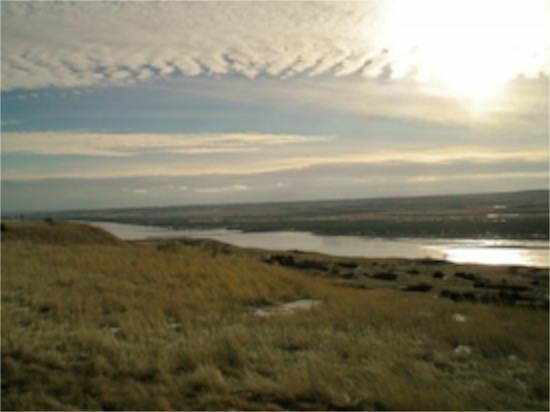 So I am off to a town I know how to pronounce by way of a route that I know well. The GPS is not required and my destination is less than a tank of gas away. The weather is in that perfect niche where you don’t need the heater and you don’t need the air conditioner. And I’ll be home for supper. Life is good. And Saturday promises another lovely drive up to Eagle Butte. Two trips in one week, not bad for a guy who has a desk job.
So I am off to a town I know how to pronounce by way of a route that I know well. The GPS is not required and my destination is less than a tank of gas away. The weather is in that perfect niche where you don’t need the heater and you don’t need the air conditioner. And I’ll be home for supper. Life is good. And Saturday promises another lovely drive up to Eagle Butte. Two trips in one week, not bad for a guy who has a desk job.
Who knows, maybe I’ll think up a topic or two for future blogs while I’m driving.
In Nebraska, there’s Kearney, and in Idaho the Owyhee Mountains are named after the state of Hawaii, but pronounced with a distinctly Idaho flavor (spelling sometimes has its regional variations as well. Like Montanans, we here in South Dakota have our own distinct way of pronouncing our capital city. When someone mispronounces it, we know that they’re from out of state. For most of us living here, we are happy to have the seat of government located well off of the Interstate Highway and for those of use who live west river, we prefer to have the governor’s home east river, but not too far East, and you don’t get much closer to the river than Pierre. For those of us in Rapid City it is an appropriate distance away. It is an easy 2½-hour drive on good roads. Except, like everyone else who doesn’t live in Mountain time, they don’t know what time it is over there, so you have to allow 3½ hours to get there. On the other hand, you can drive home in 1½ hours without getting a speeding ticket. It is a good distance for a meeting. Five hours of driving is just right for clearing your head and making sure you are ready for what is going to happen next.

There’s lots to check out on the way. I’m not sure whether the meadowlarks are back from their winter vacation. I haven’t heard any yet this year, so I’ll be listening and looking as I go. Basically believing that government operates best without my participation except for voting, I haven’t been up to Pierre since last summer, when the water was high and the flooding was the biggest news in town. I’ll be interested to see what has and what has not recovered since the flood. What do you want to bet they’ve figured out how to get all those lawyers out playing golf by now?
The weather has been good and the calves are old enough to be kicking up their heels. There wasn’t much snow this winter, so I doubt that the winter wheat is showing any green, but I like to look at the fields all the same.
In case you haven’t figured out, I’ll be going over to Wall and then up the regular highway. Taking the Interstate to Vivian and then heading up on the four-lane is fine for legislators, lawyers and lobbyists, but not my preferred cup of tea. If I had a little more time, I might go to Sturgis and drive highway 34, which is another great way to get there. I’m thinking that not too many legislators, lawyers and lobbyists know where Bridger is and I’m thinking that the folks at Bridger probably prefer it that way.
OK, so I have probably offended all of the legislators, lawyers and lobbyists who are reading my blog by now. However, according to Google analytics, if the percentage of lawyers who read my blog is the same as the percentage of lawyers in the United States, only 2 tenths of one lawyer read my blog on a daily basis. Throwing in an occasional complaint or dig is not likely to increase my readership among legislators, lawyers and lobbyists.


Who knows, maybe I’ll think up a topic or two for future blogs while I’m driving.
Copyright © 2012 by Ted Huffman. I wrote this. If you want to copy it, please ask for permission. There is a contact me button at the bottom of this page. If you want to share my blog a friend, please direct your friend to my web site.
Hauling Logs
21/03/12 05:25
The town I was raised is named Big Timber. The name does not come from having particularly big trees. There are some old cottonwoods around, but that it is about all. Here’s how the name came to be. On their Eastward return from the Pacific Coast, Lewis and Clark divided their expedition near the headwaters of the Missouri River. Lewis and his crew followed the Missouri and spent some time exploring the Marias. Clark and crew hiked over the Bozeman pass and found the Yellowstone River near the present-day town of Livingston. By the time they got to the confluence with the Boulder River they had been walking for a little over 60 miles. There they finally found trees that were big enough to carve dougout boats so that they could begin river travel. The boats meant that the remainder of the trip would be less strenuous. They named the place where the found the trees Big Timber.
I spent an additional ten years of my life in Boise, Idaho. The story of that town’s name dates back to the days of French Fur trappers who were said to have uttered upon discovering the area, “Les Bois!, Lest Bois!” Actually the trees in Boise aren’t all that spectacular. It seems that the fur trappers had been wandering in the desert for several days and so just finding a place with some trees was an exciting discovery.
Still, I have had a deep appreciation for trees all of my life. All of my growing up summers included time at our Church Camp, Mimanagish, high up the boulder valley nestled in huge stands of lodgepole pine. There really is something very wonderful about the whisper of the wind in the pine trees. I assumed that I would always live in a place where there was an ample supply of trees.
Graduating from seminary, however, we found ourselves called to rural North Dakota. I had a fairly large collection of North Dakota jokes and some biases about life on the prairie. I had tried to find a call in a mountainous location, but God has a wonderful sense of humor and we headed across the prairie to our new home. My biases turned out to be wrong. It was a wonderful place to live. I grew to enjoy the open space, the ability to see long distances, the view from the top of a small hill or rise, and especially the people who lived there. To be honest, our town was not without trees. There just weren’t very many of them outside of town.
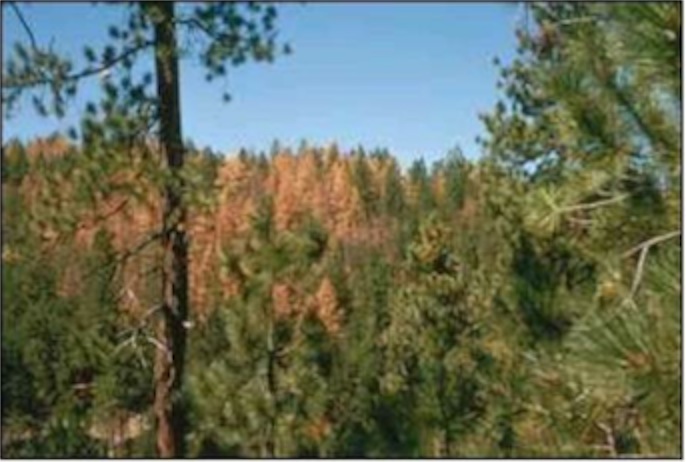 When the time came for us to move to the Black Hills, we were delighted to find our home at the edge of the hills with pine trees all around. There are a few spruce in the hills, a smattering of birch, some clusters of oak and aspen and cottonwoods, but the primary tree of the Black Hills is the Ponderosa Pine. Old photographs from the time of the Custer expedition show far fewer trees in the hills than we have these days, so we know that periodically over the years, fires and insects have taken their toll on the trees in the hills. Still, knowing it doesn’t make it any easier to accept the attack of pine bark beetles that have been decimating our forest for the past few years. It is not something restricted to the Black Hills. All across the west millions of acres of pine trees are dying from the infestation. The tiny critters seem to find more trees to attack and multiply at faster rates during periods of drought and stress on the trees and the long northwest drought a decade ago gave them a real start in many areas. Across the west, we have grown used to seeing a tri-colored forest. There are green trees, many of which are already infected by the beetles, red trees, with needles still attached but clearly dead and grey trees, from which the needles have fallen. The dead and dying trees are especially vulnerable to fire and when huge stands of trees are affected, fires spread more quickly and grow much bigger. It all may be part of the cycle of nature, but it sure changes the vista for the folks who live in the forest.
When the time came for us to move to the Black Hills, we were delighted to find our home at the edge of the hills with pine trees all around. There are a few spruce in the hills, a smattering of birch, some clusters of oak and aspen and cottonwoods, but the primary tree of the Black Hills is the Ponderosa Pine. Old photographs from the time of the Custer expedition show far fewer trees in the hills than we have these days, so we know that periodically over the years, fires and insects have taken their toll on the trees in the hills. Still, knowing it doesn’t make it any easier to accept the attack of pine bark beetles that have been decimating our forest for the past few years. It is not something restricted to the Black Hills. All across the west millions of acres of pine trees are dying from the infestation. The tiny critters seem to find more trees to attack and multiply at faster rates during periods of drought and stress on the trees and the long northwest drought a decade ago gave them a real start in many areas. Across the west, we have grown used to seeing a tri-colored forest. There are green trees, many of which are already infected by the beetles, red trees, with needles still attached but clearly dead and grey trees, from which the needles have fallen. The dead and dying trees are especially vulnerable to fire and when huge stands of trees are affected, fires spread more quickly and grow much bigger. It all may be part of the cycle of nature, but it sure changes the vista for the folks who live in the forest.
We hate to lose any tree. Losing thousands is no picnic.
One of the ways to slow the spread of the beetles is to remove the affected trees. Many landowners have been aggressive about felling trees lost to the beetles. The trees are then cut into short lengths and left scattered in the forest. Another technique is to cover the loges with plastic to contain the insects and raise temperature levels. An even better technique is to haul the logs out of the area so there are no nearby trees for the beetles to migrate towards.
Since we have neighbors living on the prairie who need firewood the solution is obvious to us. Our church has split and delivered large amounts of firewood. Last year we delivered over 40 cords.
 The logs keep coming in.
The logs keep coming in.
This week we are planning a caravan to haul unsplit logs to our partners on the Cheyenne River Reservation north of Eagle Butte. We need to get the bug logs out of the forest and they will need the firewood next year. Sometime in the summer, we will meet up with our reservation partners for a splitting party to split and stack the wood on the reservation. We will get to know the people of the reservation churches better and deepen our relationships as well as provide energy for warmth in the winter. It is a win-win situation.
Our winter was unseasonably mild and spring seems to be following in the same pattern. That is not the best news for the trees. A harsher winter and more moisture would help the trees survive the beetle attacks better. More snow and rainfall would decrease the fire danger as well. But we don’t control the weather.
It looks like we have plenty of logs to split and firewood to deliver for a long time to come.
I spent an additional ten years of my life in Boise, Idaho. The story of that town’s name dates back to the days of French Fur trappers who were said to have uttered upon discovering the area, “Les Bois!, Lest Bois!” Actually the trees in Boise aren’t all that spectacular. It seems that the fur trappers had been wandering in the desert for several days and so just finding a place with some trees was an exciting discovery.
Still, I have had a deep appreciation for trees all of my life. All of my growing up summers included time at our Church Camp, Mimanagish, high up the boulder valley nestled in huge stands of lodgepole pine. There really is something very wonderful about the whisper of the wind in the pine trees. I assumed that I would always live in a place where there was an ample supply of trees.
Graduating from seminary, however, we found ourselves called to rural North Dakota. I had a fairly large collection of North Dakota jokes and some biases about life on the prairie. I had tried to find a call in a mountainous location, but God has a wonderful sense of humor and we headed across the prairie to our new home. My biases turned out to be wrong. It was a wonderful place to live. I grew to enjoy the open space, the ability to see long distances, the view from the top of a small hill or rise, and especially the people who lived there. To be honest, our town was not without trees. There just weren’t very many of them outside of town.

We hate to lose any tree. Losing thousands is no picnic.
One of the ways to slow the spread of the beetles is to remove the affected trees. Many landowners have been aggressive about felling trees lost to the beetles. The trees are then cut into short lengths and left scattered in the forest. Another technique is to cover the loges with plastic to contain the insects and raise temperature levels. An even better technique is to haul the logs out of the area so there are no nearby trees for the beetles to migrate towards.
Since we have neighbors living on the prairie who need firewood the solution is obvious to us. Our church has split and delivered large amounts of firewood. Last year we delivered over 40 cords.

This week we are planning a caravan to haul unsplit logs to our partners on the Cheyenne River Reservation north of Eagle Butte. We need to get the bug logs out of the forest and they will need the firewood next year. Sometime in the summer, we will meet up with our reservation partners for a splitting party to split and stack the wood on the reservation. We will get to know the people of the reservation churches better and deepen our relationships as well as provide energy for warmth in the winter. It is a win-win situation.
Our winter was unseasonably mild and spring seems to be following in the same pattern. That is not the best news for the trees. A harsher winter and more moisture would help the trees survive the beetle attacks better. More snow and rainfall would decrease the fire danger as well. But we don’t control the weather.
It looks like we have plenty of logs to split and firewood to deliver for a long time to come.
Copyright © 2012 by Ted Huffman. I wrote this. If you want to copy it, please ask for permission. There is a contact me button at the bottom of this page. If you want to share my blog a friend, please direct your friend to my web site.
Watching Glue Dry
20/03/12 05:26
I have been reading about reported problems with the new iPads. It seems that they get hot when they are used. It is a problem with other types of computer technology. The electrical chips produce heat as a byproduct. Years ago when the only kinds of computers were mainframes, they were kept in basements with air conditioners running year around to keep the components cool. Many computers, even laptops, have fans to help keep everything cool. The desire for super lightweight, super thin, super bright computers creates compromises. No worries for me at this point. I don’t have an iPad and I don’t have a plan to obtain one at this point. I like technology, but it isn’t uncommon for a new device to be in its third or fourth generation before I enter the market. Even though I was one of the first people in our city to get an iPhone, mine is an iPhone 4. There were three models before I got mine.
Our modern technology creates a sense of urgency. We become frantic about delays. Before the invention of microwave ovens, no one thought that waiting for water to boil was a long delay. We expected it to take some time to prepare a meal. Recently I read an advertisement for a single cup coffee maker that proclaimed “no more waiting.” Is the wait in an automatic coffee maker really too long?
But I know some of the impatience has seized me as well. I get frustrated when a web site runs slowly. The eye doctor that I see for my glasses has a new online registration process. When it took me fifteen minutes to complete the process, I was frustrated. There was a time when it was routine for a medical office to have 15 minutes of paperwork before being seen by the doctor. I have found myself in a local bookshop frustrated that I have to wait two days to obtain a book.
As a result, I try to keep a few things around me that run at a slower pace. I love to cook outdoors on my barbecue grill, but I haven’t yet gotten a gas grill. Waiting for the charcoal to become the right temperature is a gift. It means that I have to plan ahead a little bit in order to cook. There are always a few small outdoor chores that need to be done while the coals warm. I use a charcoal chimney, so it doesn’t take very long for the grill to get up to temperature.
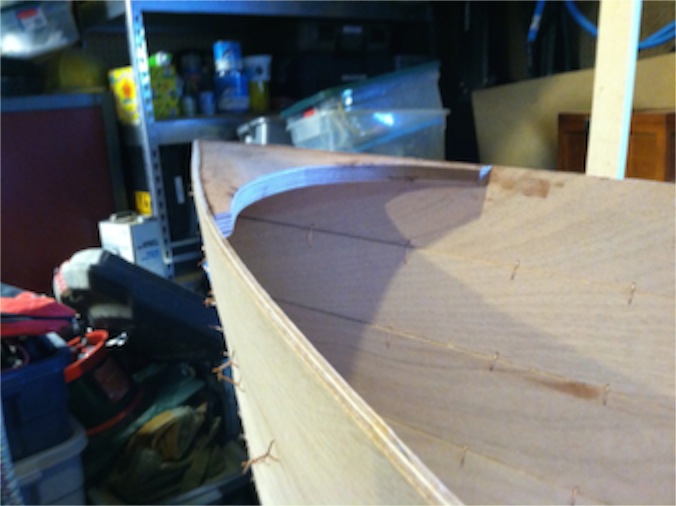 Building boats is another area of my life, where I am intentional about slowing down. I use modern methods and tools in my work. In fact I have only made one boat that did not involve the use of epoxy. The modern two-part adhesive is a gift to amateur boat builders. But epoxy takes 24 hours to cure at 75 degrees. I don’t know any boat builders who keep their shops at 75 degrees. My “shop” is an unheated garage, though I do have a kerosene heater to warm the place when I am working. When the weather is cold, it takes at least twice as long for the epoxy to cure, even with a little space heater. That means that there are times when I am literally waiting for the glue to dry.
Building boats is another area of my life, where I am intentional about slowing down. I use modern methods and tools in my work. In fact I have only made one boat that did not involve the use of epoxy. The modern two-part adhesive is a gift to amateur boat builders. But epoxy takes 24 hours to cure at 75 degrees. I don’t know any boat builders who keep their shops at 75 degrees. My “shop” is an unheated garage, though I do have a kerosene heater to warm the place when I am working. When the weather is cold, it takes at least twice as long for the epoxy to cure, even with a little space heater. That means that there are times when I am literally waiting for the glue to dry.
And I can be impatient. Especially when I have a day off from work and would like to get all sorts of things done. It means that I have to plan my work. It also means that there are times when all I can do in a day is to place one or two parts.
The gift of this is a different perspective on time. In order to build a boat, I need to slow down and take my time. The time delays probably result in a better boat, because I have time to re-read the instructions. I have time to study the plans. I have time to just stare at the project and think about how things will go. Down time also is an opportunity to sharpen and clean tools and to pick up the workspace a little. My area is cluttered. I am not the best at keeping everything organized all of the time. But I do have good toolboxes and places to keep my things when I take the time to put them away properly.
Yesterday I cleaned out a small toolbox that my father-in-law kept at his apartment. As an electrician, he kept a good assortment of pliers, wire strippers, screwdrivers and nut drivers. He wasn’t a woodworker. It took me more than half an hour to put an edge back on a small wood chisel that was in the box. The handle was all beat up. You could tell he used a claw hammer to pound on the chisel to carve wood. Most likely he was trimming to make a place to run a wire in an area where it would never been seen. Still, I couldn’t put the chisel into my toolbox without sharpening it first. There was also a pocketknife that was in need of some time with the stone. I don’t need another chisel or another pocketknife, but I added them to my toolbox all the same. Using tools that belonged to my elders is a good way for me to maintain the connections with them.
Today is a busy day at work, with meetings that stretch into the evening. I’ll be going from meeting to meeting all day long. I will need to be prepared and will need to be able to exhibit a different kind of patience – this time with people who need to be heard. There won’t be any time to work on my rowboat project. That’s good for the project because the epoxy needs to cure. It’s good for me because I need the contact with people. But it is also good that I take time away from the constant flow of meetings to practice the discipline of patience.
Sometimes it is good to just watch the glue dry.
Our modern technology creates a sense of urgency. We become frantic about delays. Before the invention of microwave ovens, no one thought that waiting for water to boil was a long delay. We expected it to take some time to prepare a meal. Recently I read an advertisement for a single cup coffee maker that proclaimed “no more waiting.” Is the wait in an automatic coffee maker really too long?
But I know some of the impatience has seized me as well. I get frustrated when a web site runs slowly. The eye doctor that I see for my glasses has a new online registration process. When it took me fifteen minutes to complete the process, I was frustrated. There was a time when it was routine for a medical office to have 15 minutes of paperwork before being seen by the doctor. I have found myself in a local bookshop frustrated that I have to wait two days to obtain a book.
As a result, I try to keep a few things around me that run at a slower pace. I love to cook outdoors on my barbecue grill, but I haven’t yet gotten a gas grill. Waiting for the charcoal to become the right temperature is a gift. It means that I have to plan ahead a little bit in order to cook. There are always a few small outdoor chores that need to be done while the coals warm. I use a charcoal chimney, so it doesn’t take very long for the grill to get up to temperature.
 Building boats is another area of my life, where I am intentional about slowing down. I use modern methods and tools in my work. In fact I have only made one boat that did not involve the use of epoxy. The modern two-part adhesive is a gift to amateur boat builders. But epoxy takes 24 hours to cure at 75 degrees. I don’t know any boat builders who keep their shops at 75 degrees. My “shop” is an unheated garage, though I do have a kerosene heater to warm the place when I am working. When the weather is cold, it takes at least twice as long for the epoxy to cure, even with a little space heater. That means that there are times when I am literally waiting for the glue to dry.
Building boats is another area of my life, where I am intentional about slowing down. I use modern methods and tools in my work. In fact I have only made one boat that did not involve the use of epoxy. The modern two-part adhesive is a gift to amateur boat builders. But epoxy takes 24 hours to cure at 75 degrees. I don’t know any boat builders who keep their shops at 75 degrees. My “shop” is an unheated garage, though I do have a kerosene heater to warm the place when I am working. When the weather is cold, it takes at least twice as long for the epoxy to cure, even with a little space heater. That means that there are times when I am literally waiting for the glue to dry.And I can be impatient. Especially when I have a day off from work and would like to get all sorts of things done. It means that I have to plan my work. It also means that there are times when all I can do in a day is to place one or two parts.
The gift of this is a different perspective on time. In order to build a boat, I need to slow down and take my time. The time delays probably result in a better boat, because I have time to re-read the instructions. I have time to study the plans. I have time to just stare at the project and think about how things will go. Down time also is an opportunity to sharpen and clean tools and to pick up the workspace a little. My area is cluttered. I am not the best at keeping everything organized all of the time. But I do have good toolboxes and places to keep my things when I take the time to put them away properly.
Yesterday I cleaned out a small toolbox that my father-in-law kept at his apartment. As an electrician, he kept a good assortment of pliers, wire strippers, screwdrivers and nut drivers. He wasn’t a woodworker. It took me more than half an hour to put an edge back on a small wood chisel that was in the box. The handle was all beat up. You could tell he used a claw hammer to pound on the chisel to carve wood. Most likely he was trimming to make a place to run a wire in an area where it would never been seen. Still, I couldn’t put the chisel into my toolbox without sharpening it first. There was also a pocketknife that was in need of some time with the stone. I don’t need another chisel or another pocketknife, but I added them to my toolbox all the same. Using tools that belonged to my elders is a good way for me to maintain the connections with them.
Today is a busy day at work, with meetings that stretch into the evening. I’ll be going from meeting to meeting all day long. I will need to be prepared and will need to be able to exhibit a different kind of patience – this time with people who need to be heard. There won’t be any time to work on my rowboat project. That’s good for the project because the epoxy needs to cure. It’s good for me because I need the contact with people. But it is also good that I take time away from the constant flow of meetings to practice the discipline of patience.
Sometimes it is good to just watch the glue dry.
Copyright © 2012 by Ted Huffman. I wrote this. If you want to copy it, please ask for permission. There is a contact me button at the bottom of this page. If you want to share my blog a friend, please direct your friend to my web site.
The Very Hungry Caterpillar
19/03/12 05:48
There are some stories that you read to your children that stick in your mind. Many children’s books are short with simple story lines. If the child likes the book, you will read it enough times to memorize it. At least that is what happened in our family. With two parents who love books, our children got lots of reading time. We wanted to pass on our love of reading. We always read a story at bedtime, but there were lots of other times in the day when we read books. Our children had their own books from an early age and there was usually an adult who was willing to read every time they brought a book to us.
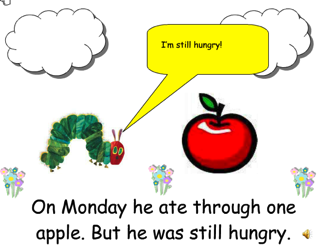 The Very Hungry Caterpillar was not a new book when our children were born. It had been around for at least a dozen years when Isaac came along. But I don’t know if I had seen it before we got a copy to read to him when he was 3 or so. The book was fun, with holes in the pages as if the hungry caterpillar had eaten some of the book. For parents who are wondering how to start a discussion with their children with subjects such as Lepidoptera or metamorphosis, this book is the ticket. After all, the Royal Entomological Society has endorsed it!
The Very Hungry Caterpillar was not a new book when our children were born. It had been around for at least a dozen years when Isaac came along. But I don’t know if I had seen it before we got a copy to read to him when he was 3 or so. The book was fun, with holes in the pages as if the hungry caterpillar had eaten some of the book. For parents who are wondering how to start a discussion with their children with subjects such as Lepidoptera or metamorphosis, this book is the ticket. After all, the Royal Entomological Society has endorsed it!
The story line is the tale of the life cycle of a butterfly. In the opening scene, there is an egg on a leaf in the light of the moon. Out pops a caterpillar and he is hungry. On Monday he eats an apple, on Tuesday two pears, on Wednesday three plums, on Thursday four strawberries, and on Friday five oranges. So far, so good. We get the days of the week, numbers, and colors. I forgot to mention that the apple is red, the pears, green, the plums purple, the strawberries red and the oranges are. . . well orange.
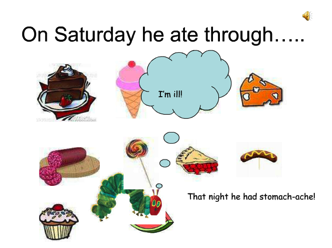 Saturday is the surprise day. The caterpillar eats one piece of chocolate cake, one ice-cream cone, one pickle, one slice of Swiss cheese, one slice of salami, one lollipop, one piece of cherry pie, one sausage, one cupcake, and one slice of watermelon. That night he gets a stomachache. I wasn’t really aware that Caterpillars ate ice cream, but i like ice cream and ice cream seems like a good thing to eat when you are very hungry. Now if Carle had written the book so that the caterpillar had ice cream on the pie, that might have been anthropomorphizing, but a stand alone ice cream cone. Yum!
Saturday is the surprise day. The caterpillar eats one piece of chocolate cake, one ice-cream cone, one pickle, one slice of Swiss cheese, one slice of salami, one lollipop, one piece of cherry pie, one sausage, one cupcake, and one slice of watermelon. That night he gets a stomachache. I wasn’t really aware that Caterpillars ate ice cream, but i like ice cream and ice cream seems like a good thing to eat when you are very hungry. Now if Carle had written the book so that the caterpillar had ice cream on the pie, that might have been anthropomorphizing, but a stand alone ice cream cone. Yum!
 When Sunday comes around he eats a leaf and feels better. Then he forms a cocoon. OK, the author, Eric Carle, had me up to this point. But seriously, I thought that a cocoon is the silk casing that a moth caterpillar spins around it before it turns into a pupa. If he had said “chrysalis,” I would have been expecting a butterfly, but as it was, I’m thinking to myself, “Aha, there will be a moth on the next page.” But No, Carle uses poetic license to bring forth a butterfly. It sent me to the dictionary to check out my sources. Reading the dictionary always gets me distracted. Did you know that the Atlas Moth has a wingspan of up to 30 cm? That’s one big moth – about a foot across. It is so large that it is often mistaken for a small bird when flying. What is more, the Atlas Moth has a cocoon that looks like a piece of fruit hanging from a tree. And it has markings on its forewings that resemble a snake which scare away predators. Like many other moths, it does all of its eating as a larva. The adult moth has no mouth and cannot eat.
When Sunday comes around he eats a leaf and feels better. Then he forms a cocoon. OK, the author, Eric Carle, had me up to this point. But seriously, I thought that a cocoon is the silk casing that a moth caterpillar spins around it before it turns into a pupa. If he had said “chrysalis,” I would have been expecting a butterfly, but as it was, I’m thinking to myself, “Aha, there will be a moth on the next page.” But No, Carle uses poetic license to bring forth a butterfly. It sent me to the dictionary to check out my sources. Reading the dictionary always gets me distracted. Did you know that the Atlas Moth has a wingspan of up to 30 cm? That’s one big moth – about a foot across. It is so large that it is often mistaken for a small bird when flying. What is more, the Atlas Moth has a cocoon that looks like a piece of fruit hanging from a tree. And it has markings on its forewings that resemble a snake which scare away predators. Like many other moths, it does all of its eating as a larva. The adult moth has no mouth and cannot eat.
 Anyway, the book seemed like just the right gift for our son for his birthday this year. He has a son who is one year old, and although not really quite old enough for the story in the book, as anyone who has talked to me knows, the child is very intelligent. Besides I bought the book for the father who is a librarian and should be able to figure out when is the right time to read the book to his son. In our house, the Constructive Playthings catalog is one of the most-read pieces of literature, so I ordered not just the book, but also a wonderful teaching prop set with a soft caterpillar and all of the foods. After stuffing the apple, pears, plums, strawberries, oranges, chocolate cake, ice-cream cone, pickle, Swiss cheese, salami, lollipop, cherry pie, sausage, cupcake, watermelon slice and leaf into the caterpillar, the toy can be turned inside out and becomes a butterfly. Now what doting grandparent could avoid such a purchase even if the grandchild may be a bit young for the story? After all I bought it as a birthday gift for the father. And the father is a librarian. Librarians need all kinds of books. Besides I couldn’t quite justify buying it for myself. As my wife of nearly 39 years will tell you, I’m pretty good at buying things I want to have as gifts for others.
Anyway, the book seemed like just the right gift for our son for his birthday this year. He has a son who is one year old, and although not really quite old enough for the story in the book, as anyone who has talked to me knows, the child is very intelligent. Besides I bought the book for the father who is a librarian and should be able to figure out when is the right time to read the book to his son. In our house, the Constructive Playthings catalog is one of the most-read pieces of literature, so I ordered not just the book, but also a wonderful teaching prop set with a soft caterpillar and all of the foods. After stuffing the apple, pears, plums, strawberries, oranges, chocolate cake, ice-cream cone, pickle, Swiss cheese, salami, lollipop, cherry pie, sausage, cupcake, watermelon slice and leaf into the caterpillar, the toy can be turned inside out and becomes a butterfly. Now what doting grandparent could avoid such a purchase even if the grandchild may be a bit young for the story? After all I bought it as a birthday gift for the father. And the father is a librarian. Librarians need all kinds of books. Besides I couldn’t quite justify buying it for myself. As my wife of nearly 39 years will tell you, I’m pretty good at buying things I want to have as gifts for others.
 The book is a classic. In 2009, to celebrate the book’s 40th anniversary, Google displayed a search page based on the story.
The book is a classic. In 2009, to celebrate the book’s 40th anniversary, Google displayed a search page based on the story.
Eric Carle went on to write other great books: The Very Quiet Cricket, The Mixed Up Chameleon, Papa, Please Get the Moon for Me and I See a Song. Come to think of it, I See a Song is a great Eric Carle book for a younger child. It doesn’t rely on words, just beautiful illustrations. There is a video of the book available on YouTube. But there is no puppet set to go with that book.
One of the great delights of this life is living long enough to become a grandpa. Society expects parents to be responsible and thoughtful and careful. If a parent gets to extravagant with spending and busy too many silly things, they are criticized. And when you are a parent you are working so hard to be responsible. After all you have to buy mundane things like groceries and diapers and clothes for a child who changes sizes every month. You’ve got house payments and you are trying to establish a career and find your way in life. Being a grandpa is far more relaxing and people don’t seem to mind if you are a bit quirky or extravagant or even silly.
So I was looking through the Creative Playthings Catalog. I’ve got a birthday coming up in a couple of months. I think I’ll drop a hint. The set of puppets with the Old Lady and finger puppets of all of the things she swallowed seems like something worth having. I already know the song, so I don’t need the book or the CD.
Life is good. And there are some stories that are worth telling over and over again.

The story line is the tale of the life cycle of a butterfly. In the opening scene, there is an egg on a leaf in the light of the moon. Out pops a caterpillar and he is hungry. On Monday he eats an apple, on Tuesday two pears, on Wednesday three plums, on Thursday four strawberries, and on Friday five oranges. So far, so good. We get the days of the week, numbers, and colors. I forgot to mention that the apple is red, the pears, green, the plums purple, the strawberries red and the oranges are. . . well orange.




Eric Carle went on to write other great books: The Very Quiet Cricket, The Mixed Up Chameleon, Papa, Please Get the Moon for Me and I See a Song. Come to think of it, I See a Song is a great Eric Carle book for a younger child. It doesn’t rely on words, just beautiful illustrations. There is a video of the book available on YouTube. But there is no puppet set to go with that book.
One of the great delights of this life is living long enough to become a grandpa. Society expects parents to be responsible and thoughtful and careful. If a parent gets to extravagant with spending and busy too many silly things, they are criticized. And when you are a parent you are working so hard to be responsible. After all you have to buy mundane things like groceries and diapers and clothes for a child who changes sizes every month. You’ve got house payments and you are trying to establish a career and find your way in life. Being a grandpa is far more relaxing and people don’t seem to mind if you are a bit quirky or extravagant or even silly.
So I was looking through the Creative Playthings Catalog. I’ve got a birthday coming up in a couple of months. I think I’ll drop a hint. The set of puppets with the Old Lady and finger puppets of all of the things she swallowed seems like something worth having. I already know the song, so I don’t need the book or the CD.
Life is good. And there are some stories that are worth telling over and over again.
Copyright © 2012 by Ted Huffman. I wrote this. If you want to copy it, please ask for permission. There is a contact me button at the bottom of this page. If you want to share my blog a friend, please direct your friend to my web site.
The Death of a Pope
18/03/12 05:38
The Ottoman Empire was one of the largest and longest lasting empires in history. At its height, it ruled most of the lands around the Mediterranean. The region that we now call the Middle East was once a peaceful land under an empire with far-reaching interests. For more than 600 years, the Empire was ruled from Constantinople, presently known as Istanbul. It was the center of relations between the East and the West.
The final collapse of the Ottoman Empire began with World War I. The partitioning of the Empire that followed was based primarily on European politics, not the natural relationships between the people who lived in the countries. Small countries were formed with improbably boundaries. Look at the modern country of Lebanon, for example. The people who lived there used to do regular business in cities that are now parts of Syria and Israel. The modern borders divide businesses, families and social relationships. The formation of the modern states resulted in people losing their homes, farms and properties without compensation.
The result has been that the region is scattered with refugees – people made homeless by political disputes.
There was a time when the Ottoman Empire was a model of religious tolerance. Christians, Jews and Muslims lived as neighbors in peace. This is not to say that there were not cases of discrimination and even eruptions of violence, but the land was once filled with cities that boasted churches and mosques and temples standing side by side. It is a popular theory these days to blame religion for the violence in the area, but there are still a few elders who remember when religious diversity was a way of life.
On Tuesday, they will bury a pope in Wadi Natron, northwest of Alexandria in Egypt. Pope Shenouda III died on Saturday at the age of 88. He had suffered from diabetes, renal failure and lung cancer. Shenouda was the head of the Coptic Orthodox Christian Church. The Coptic Church is the largest Christian church in the Middle East. Christians make up less than 10% of the total population of Egypt these days. Since the fall of the Ottoman Empire Christians have been leaving the Middle East in large numbers and the church has faced a steady decline in membership.

The death of a pope is a big event, nonetheless. Thousands of people have paraded by the pope’s body, displayed in an elaborate golden crown and red and golden robes. As many as two million people are expected for the funeral. The Coptic Church has a worldwide presence with members in Europe, Canada, the United States, Kenya, Zimbabwe, Nambibia and South Africa.
If one were to read the popular news media, you might think that there was only one pope in Christianity. Pope Benedict XVI is the head of the Roman Catholic Church, the largest Christian communion. But the Christian Church has experienced divisions and different communions for almost all of its history. Like other world religions, it is not a monolithic gathering of people who all have the same beliefs, theology and interpretation of scripture. It is rather a complex and diverse collection of many churches.
We often simplify when we look at others. We make the same mistake of misinterpretation of other world religions.
Violence against Christians in Egypt has been on the rise since last year’s revolution. In January of 2011, the bombing of a major church in Alexandria left 21 dead. At least 25 Coptic Christians were killed in clashes with the army in October. Christians are continuing to leave Egypt because of the fear of violence.
Life isn’t easy for those who leave. Christians who immigrate to the United States are often identified by their skin color and accent as Muslim and face rising anti-Muslim and anti-Middle Eastern discrimination. A distinct minority in Egypt, Coptic Christians find themselves to be members of an even smaller minority in other countries. The practices and traditions of the Coptic Church are distinct from those of other Christian groups and Coptic Christians do not feel at home in the midst of other Christian churches.
The region that once was the center of religious diversity now is becoming more and more polarized. Religion has become the excuse for violence. People have become intolerant of difference.
I have lived my life in a corner of Christianity that has been far from popes and hierarchical structures. My understanding of the organization of the Christian community is very different than the views of Coptic Christians. I am not a fan of icons, or lavish vestments, or crowns and jewels. I prefer the role of servant of the people. But I also know that our church has found significant partnerships with Coptic Christians. Engaging in mission around the world often means working with partners in different churches. In the Middle East, our Coptic Christian partners have been effective in their ministries of outreach and meaningful partners in development work, disaster response, and other ministries. I understand Jesus’ prayer, “That they may all be one,” to be about Christians working together in mission and ministry and not about mergers of church structures.
The death of a spiritual leader is always a time of uncertainty for faithful people. It will take some time for the 150 bishops of the church’s Holy Council to set up the process of selection of the new pope. Thousands of bishops, priests and monks are eligible to vote in the election. Shenouda has served since 1971, so it has been a long time since the selection process was needed. In the meantime, faithful Coptic Christians will wonder about the future of their church as it faces decreasing membership. This combines with fears about the future of their country as hard-line Islamists gain political power in a time of uncertainty and national transition.
I pray that religious tolerance and open religious dialogue are not just parts of the past in the Middle East, but also the way of the future. A new pope in the Coptic Christian Church will face incredible challenges and difficult times. May that new pope be graced with a vision of the future in which Christians, Jews and Muslims can live side by side with justice and peace.
The final collapse of the Ottoman Empire began with World War I. The partitioning of the Empire that followed was based primarily on European politics, not the natural relationships between the people who lived in the countries. Small countries were formed with improbably boundaries. Look at the modern country of Lebanon, for example. The people who lived there used to do regular business in cities that are now parts of Syria and Israel. The modern borders divide businesses, families and social relationships. The formation of the modern states resulted in people losing their homes, farms and properties without compensation.
The result has been that the region is scattered with refugees – people made homeless by political disputes.
There was a time when the Ottoman Empire was a model of religious tolerance. Christians, Jews and Muslims lived as neighbors in peace. This is not to say that there were not cases of discrimination and even eruptions of violence, but the land was once filled with cities that boasted churches and mosques and temples standing side by side. It is a popular theory these days to blame religion for the violence in the area, but there are still a few elders who remember when religious diversity was a way of life.
On Tuesday, they will bury a pope in Wadi Natron, northwest of Alexandria in Egypt. Pope Shenouda III died on Saturday at the age of 88. He had suffered from diabetes, renal failure and lung cancer. Shenouda was the head of the Coptic Orthodox Christian Church. The Coptic Church is the largest Christian church in the Middle East. Christians make up less than 10% of the total population of Egypt these days. Since the fall of the Ottoman Empire Christians have been leaving the Middle East in large numbers and the church has faced a steady decline in membership.

The death of a pope is a big event, nonetheless. Thousands of people have paraded by the pope’s body, displayed in an elaborate golden crown and red and golden robes. As many as two million people are expected for the funeral. The Coptic Church has a worldwide presence with members in Europe, Canada, the United States, Kenya, Zimbabwe, Nambibia and South Africa.
If one were to read the popular news media, you might think that there was only one pope in Christianity. Pope Benedict XVI is the head of the Roman Catholic Church, the largest Christian communion. But the Christian Church has experienced divisions and different communions for almost all of its history. Like other world religions, it is not a monolithic gathering of people who all have the same beliefs, theology and interpretation of scripture. It is rather a complex and diverse collection of many churches.
We often simplify when we look at others. We make the same mistake of misinterpretation of other world religions.
Violence against Christians in Egypt has been on the rise since last year’s revolution. In January of 2011, the bombing of a major church in Alexandria left 21 dead. At least 25 Coptic Christians were killed in clashes with the army in October. Christians are continuing to leave Egypt because of the fear of violence.
Life isn’t easy for those who leave. Christians who immigrate to the United States are often identified by their skin color and accent as Muslim and face rising anti-Muslim and anti-Middle Eastern discrimination. A distinct minority in Egypt, Coptic Christians find themselves to be members of an even smaller minority in other countries. The practices and traditions of the Coptic Church are distinct from those of other Christian groups and Coptic Christians do not feel at home in the midst of other Christian churches.
The region that once was the center of religious diversity now is becoming more and more polarized. Religion has become the excuse for violence. People have become intolerant of difference.
I have lived my life in a corner of Christianity that has been far from popes and hierarchical structures. My understanding of the organization of the Christian community is very different than the views of Coptic Christians. I am not a fan of icons, or lavish vestments, or crowns and jewels. I prefer the role of servant of the people. But I also know that our church has found significant partnerships with Coptic Christians. Engaging in mission around the world often means working with partners in different churches. In the Middle East, our Coptic Christian partners have been effective in their ministries of outreach and meaningful partners in development work, disaster response, and other ministries. I understand Jesus’ prayer, “That they may all be one,” to be about Christians working together in mission and ministry and not about mergers of church structures.
The death of a spiritual leader is always a time of uncertainty for faithful people. It will take some time for the 150 bishops of the church’s Holy Council to set up the process of selection of the new pope. Thousands of bishops, priests and monks are eligible to vote in the election. Shenouda has served since 1971, so it has been a long time since the selection process was needed. In the meantime, faithful Coptic Christians will wonder about the future of their church as it faces decreasing membership. This combines with fears about the future of their country as hard-line Islamists gain political power in a time of uncertainty and national transition.
I pray that religious tolerance and open religious dialogue are not just parts of the past in the Middle East, but also the way of the future. A new pope in the Coptic Christian Church will face incredible challenges and difficult times. May that new pope be graced with a vision of the future in which Christians, Jews and Muslims can live side by side with justice and peace.
Copyright © 2012 by Ted Huffman. I wrote this. If you want to copy it, please ask for permission. There is a contact me button at the bottom of this page. If you want to share my blog a friend, please direct your friend to my web site.
Telling the Truth
17/03/12 03:47
I am a fan of Apple Computer. I do not own any Apple Stock, but I have owned a series of Macintosh computers. We started out with a used Macintosh Plus. We had all of our programs on either 400K or 800K floppies. Later we added a Bernouli drive that had the capacity to store an amazing 20 megabytes of data on each cartridge. It was all very expensive. In those days I worked for The Kuna-Melba News and the Meridian Weekly Newspaper and our office bought a Macintosh 512k, a Macintosh Plus and an Apple Laser Printer. The cost for those computers was $10,000. My computer at home earned its own way, printing the mailing labels for the newspapers. I would load up the labels on a dot-matrix printer and start printing when I went to bed. If I was lucky and nothing jammed, the labels would print in about 2 hours. Some nights when I got up to check the printer, I had to start all over again.
We’ve had a strong of Macintosh computers since, including three different laptops. The MacBook Pro that I have been using since 2007 belongs to the church. By way of comparison, its internal hard drive holds 500 gigabytes of information.
I use an iphone4 and was one of the first in our community to get the device. I had pre-ordered it and it arrived on the release date.
I like the company, but I know that no company is perfect. I have read Walter Isaacson’s biography of Steve Jobs. I understand that he was a complex human being. Perhaps he had qualities that are accurately described as genius, but he also had quirks that could be described as annoying. The company he founded is amazing and their products are also amazing. But I know that I could never have worked with a boss like Steve. I know that the amazing company and amazing products came at a high price in human terms.
 I am also a fan of Public Radio. I listen to the radio as I drive around town and there used to be a list of programs that I tried to catch as often as I could. These days, I listen to my favorite programs on podcasts. I have my computer set to download the programs and I listen to them on my own schedule. I usually am listening as I do yard work or work in my garage. I’ve listened to every program of This American Life that has been broadcast. I caught up a couple of years ago when South Dakota Public Radio gave a flash drive filled with the program archives as a premium for a fund drive donation.
I am also a fan of Public Radio. I listen to the radio as I drive around town and there used to be a list of programs that I tried to catch as often as I could. These days, I listen to my favorite programs on podcasts. I have my computer set to download the programs and I listen to them on my own schedule. I usually am listening as I do yard work or work in my garage. I’ve listened to every program of This American Life that has been broadcast. I caught up a couple of years ago when South Dakota Public Radio gave a flash drive filled with the program archives as a premium for a fund drive donation.
So I listened carefully in January when This American Life broadcast a program titled “Mr. Daisey and the Apple Factory.” The show contained an excerpt of Mike Daisey’s one-man show, “The Agony and Ecstasy of Steve Jobs.” It detailed conditions in the Foxconn factory in China where many of Apple’s products are manufactured. It did not paint a pretty picture. The show got a lot of attention. There were online petition drives calling for Apple to change the conditions in the factory. Apple launched its own independent investigation and posted a new section on its website detailing workers’ conditions and its investigation. The show took some of the luster out of the company for me.
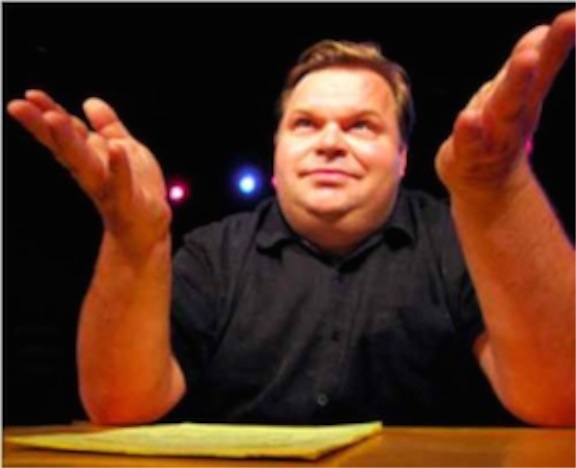 Like hundreds of thousands of others, I had grown to trust This American Life as a source for honest journalism. It didn’t occur to me that the information they were broadcasting might not be accurate. But that indeed was the fact. The program contained factual errors. And using the word “error” is a bit of kindness. The Mike Daisey monologue contained fictional elements that got by the fact checkers for the radio program.
Like hundreds of thousands of others, I had grown to trust This American Life as a source for honest journalism. It didn’t occur to me that the information they were broadcasting might not be accurate. But that indeed was the fact. The program contained factual errors. And using the word “error” is a bit of kindness. The Mike Daisey monologue contained fictional elements that got by the fact checkers for the radio program.
Today’s episode of the show will be entirely devoted to broadcasting the details of the errors in the show. The number of factories Daisey visited in China is inaccurate. He claimed to have met a group of workers injured by the chemical n-hexane on an Apple assembly line, but those workers were nearly a thousand miles from the city Daisey visited. His stories of meeting with underage workers and with a man whose hand was mangled by repetitive motion injuries are also fabricated.
Daisey’s web site has a couple of paragraphs commenting on the errors in the show. He says, “What I do is not journalism. The tools of the theater are not the same as the tools of journalism. For this reason, I regret that I allowed THIS AMERICAN LIFE to air an excerpt from my monologue.” He doesn’t regret that he made up characters and told the story as if he had actually interviewed them. He regrets that his stories were told on the radio.
Ira Glass, host of This American Life, posted a blog on the show’s web site that “Daisey lied to me and to This American Life producer Brian Redd during the fact-checking we did on the story, before it was broadcast.”
I’ll say this much for Glass and This American Life. Their pulling of the show and their courage in running a show today examining their mistakes and what was wrong with the original broadcast has earned them my respect. Most radio journalists, when confronted with mistakes or untruths in their broadcasts, tend to defend themselves and pile lie upon lie. We’ve come to expect bias and untruths from the broadcast industry.
 All of this does not confirm “sainthood” on Apple. The company has not been perfect. Workers have been injured in Foxconn factories. Working conditions are not as good as they should be. Apple continues to outsource production to China and Taiwan on a huge scale. The New York Times ran a series of articles on Apple’s working practices and production methods and the Times continues to stand by its articles. Apple did hire an independent third-party company to conduct a full audit of working conditions in factories that produce its products. The company would never have done that if there weren’t problems for workers.
All of this does not confirm “sainthood” on Apple. The company has not been perfect. Workers have been injured in Foxconn factories. Working conditions are not as good as they should be. Apple continues to outsource production to China and Taiwan on a huge scale. The New York Times ran a series of articles on Apple’s working practices and production methods and the Times continues to stand by its articles. Apple did hire an independent third-party company to conduct a full audit of working conditions in factories that produce its products. The company would never have done that if there weren’t problems for workers.
But people are never served by a lie. Passing fiction off as if it were the truth is deception. Claiming that information was the result of interviews when in fact it was a fabrication is what the Bible calls “false witness.”
I won’t be buying any tickets for Mike Daisey shows. But I will continue to listen to This American Life. I salute Ira Glass and the shows other producers for taking the time to bring out the truth.
We’ve had a strong of Macintosh computers since, including three different laptops. The MacBook Pro that I have been using since 2007 belongs to the church. By way of comparison, its internal hard drive holds 500 gigabytes of information.
I use an iphone4 and was one of the first in our community to get the device. I had pre-ordered it and it arrived on the release date.
I like the company, but I know that no company is perfect. I have read Walter Isaacson’s biography of Steve Jobs. I understand that he was a complex human being. Perhaps he had qualities that are accurately described as genius, but he also had quirks that could be described as annoying. The company he founded is amazing and their products are also amazing. But I know that I could never have worked with a boss like Steve. I know that the amazing company and amazing products came at a high price in human terms.

So I listened carefully in January when This American Life broadcast a program titled “Mr. Daisey and the Apple Factory.” The show contained an excerpt of Mike Daisey’s one-man show, “The Agony and Ecstasy of Steve Jobs.” It detailed conditions in the Foxconn factory in China where many of Apple’s products are manufactured. It did not paint a pretty picture. The show got a lot of attention. There were online petition drives calling for Apple to change the conditions in the factory. Apple launched its own independent investigation and posted a new section on its website detailing workers’ conditions and its investigation. The show took some of the luster out of the company for me.

Today’s episode of the show will be entirely devoted to broadcasting the details of the errors in the show. The number of factories Daisey visited in China is inaccurate. He claimed to have met a group of workers injured by the chemical n-hexane on an Apple assembly line, but those workers were nearly a thousand miles from the city Daisey visited. His stories of meeting with underage workers and with a man whose hand was mangled by repetitive motion injuries are also fabricated.
Daisey’s web site has a couple of paragraphs commenting on the errors in the show. He says, “What I do is not journalism. The tools of the theater are not the same as the tools of journalism. For this reason, I regret that I allowed THIS AMERICAN LIFE to air an excerpt from my monologue.” He doesn’t regret that he made up characters and told the story as if he had actually interviewed them. He regrets that his stories were told on the radio.
Ira Glass, host of This American Life, posted a blog on the show’s web site that “Daisey lied to me and to This American Life producer Brian Redd during the fact-checking we did on the story, before it was broadcast.”
I’ll say this much for Glass and This American Life. Their pulling of the show and their courage in running a show today examining their mistakes and what was wrong with the original broadcast has earned them my respect. Most radio journalists, when confronted with mistakes or untruths in their broadcasts, tend to defend themselves and pile lie upon lie. We’ve come to expect bias and untruths from the broadcast industry.

But people are never served by a lie. Passing fiction off as if it were the truth is deception. Claiming that information was the result of interviews when in fact it was a fabrication is what the Bible calls “false witness.”
I won’t be buying any tickets for Mike Daisey shows. But I will continue to listen to This American Life. I salute Ira Glass and the shows other producers for taking the time to bring out the truth.
Copyright © 2012 by Ted Huffman. I wrote this. If you want to copy it, please ask for permission. There is a contact me button at the bottom of this page. If you want to share my blog a friend, please direct your friend to my web site.
Kites
16/03/12 05:28
I’ve been flying kites since I was a kid. My first kites were made from instructions in a book of craft ideas that we had at our home. My father was a certified airplane mechanic, so I had access to a variety of lightweight materials and before long I was making kites that were bigger and more interesting than that first basic diamond kite. We lived in a small town and the kit kites that were sold in the stores were not very interesting and often didn’t fly too well. This was before the time when delta kites took over the low-end kit market. These days most kit kites will fly pretty well. At any rate, we made our own kites.
 You would think that a place that is famous for its wind would be a good place for flying kites. We certainly did have plenty of wind, but many kites are designed to fly on light breezes and the sometimes-gale-force winds we had could tear up a kite pretty easily. Actually the best places to fly kites are places where the wind blows with a steady velocity instead of having lots of gusts and surges. But we did a lot of kite flying all the same. I learned to make kites that would take stronger winds. One of my favorite designs was the tetrahedron. It is a basic pyramid, made of six sticks with two of the four resulting surfaces covered with fabric. I can make a basic kite with straws, thread and tissue paper in a few minutes. Tie together four of the pyramids to form a larger pyramid and you’ve got a respectable kite. After that, the sky is the limit in terms of design. You can tie together four of the multiple-pyramid kites to make an even bigger pyramid. You can make bigger pyramids. I decided that since wooden dowels came in 3’ lengths, using dowels for the basic sticks would make a grand kite. The four pyramids made a kite that was as tall as I was. The problem was finding suitable line to fly the kite. It packed a big pull. Binder twine was strong enough, but it is fairly heavy, so after 100’ or so, the line began to sag and pull the kite down. Also the pull was too strong for me to stand still by myself. I either had to tie myself to an anchor such as a fence post or the bumper of a car, or I had to have an assistant to help me fly the kite. Flying it turned out to be enough work that it didn’t happen too often.
You would think that a place that is famous for its wind would be a good place for flying kites. We certainly did have plenty of wind, but many kites are designed to fly on light breezes and the sometimes-gale-force winds we had could tear up a kite pretty easily. Actually the best places to fly kites are places where the wind blows with a steady velocity instead of having lots of gusts and surges. But we did a lot of kite flying all the same. I learned to make kites that would take stronger winds. One of my favorite designs was the tetrahedron. It is a basic pyramid, made of six sticks with two of the four resulting surfaces covered with fabric. I can make a basic kite with straws, thread and tissue paper in a few minutes. Tie together four of the pyramids to form a larger pyramid and you’ve got a respectable kite. After that, the sky is the limit in terms of design. You can tie together four of the multiple-pyramid kites to make an even bigger pyramid. You can make bigger pyramids. I decided that since wooden dowels came in 3’ lengths, using dowels for the basic sticks would make a grand kite. The four pyramids made a kite that was as tall as I was. The problem was finding suitable line to fly the kite. It packed a big pull. Binder twine was strong enough, but it is fairly heavy, so after 100’ or so, the line began to sag and pull the kite down. Also the pull was too strong for me to stand still by myself. I either had to tie myself to an anchor such as a fence post or the bumper of a car, or I had to have an assistant to help me fly the kite. Flying it turned out to be enough work that it didn’t happen too often.
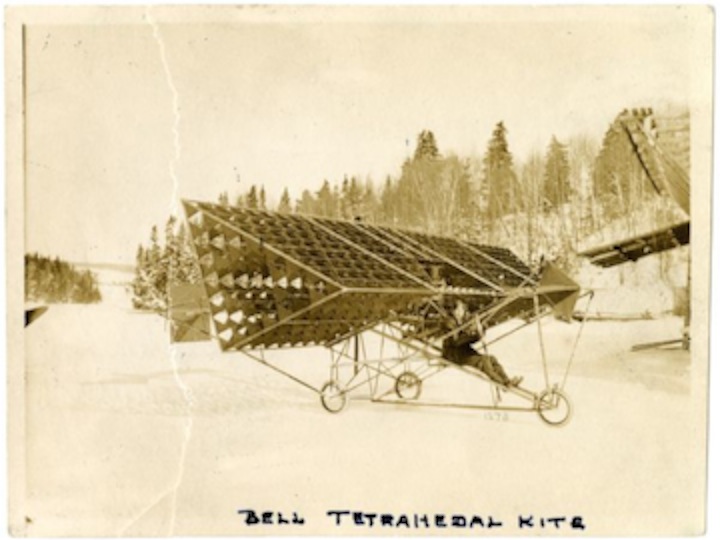 Here’s a bit of trivia for kite lovers. It is likely that the famous Benjamin Franklin electricity experiment kite was not a diamond kite as shown in so many illustrations. Franklin likely was flying a tetrahedron. Another bit of trivia: Alexander Graham Bell made a tetrahedron kite that was big enough to carry a human passenger aloft. They had designs on making an airplane, and did make a glider that was somewhat controllable.
Here’s a bit of trivia for kite lovers. It is likely that the famous Benjamin Franklin electricity experiment kite was not a diamond kite as shown in so many illustrations. Franklin likely was flying a tetrahedron. Another bit of trivia: Alexander Graham Bell made a tetrahedron kite that was big enough to carry a human passenger aloft. They had designs on making an airplane, and did make a glider that was somewhat controllable.
I was an adult before I discovered two-line kites that can be controlled. During our years in Boise, we got to the Pacific coast often and I collected a bag of different controlled kites. Most of them fly with two lines, but I have a revolution four-line kite and with a little practice, I can get it to fly pretty well.
So here I am, in South Dakota, with a bag of kites that I don’t get out very often. I take them with me when we travel and I do have a “pocket kite” that has not sticks. It is a basic parafoil and it flies very well with two lines. This style of kite is used for several different kinds of sport kiting, including kite skiing on water and kite boarding with modified skateboards. Mine is a smaller version, very portable and easy to fly anywhere. It has the added advantage of having no structural sticks, so there is nothing hard to strike someone if there happens to be a person downwind when you bring the kite close to the ground.
Controlled kites are fun to fly and can do much more than a series of loops high in the air. They can be flown comparatively close to the ground and taken through a series of maneuvers. It does take practice and I’ve had kites hit the ground.
 Spring is the season when I start thinking about kites and it is also the time of the year when kite festivals are held around the world. One of the famous festivals, the Thailand International Kite Festival, took place this past week. The festival features kites from over 100 countries. It is a surprising blend of space-age materials and traditional kite making. People have been flying kites in that area for millennia. Some say that kite flying originated in China. Whether or not this is true, there is a long history of kite flying throughout the entire region.
Spring is the season when I start thinking about kites and it is also the time of the year when kite festivals are held around the world. One of the famous festivals, the Thailand International Kite Festival, took place this past week. The festival features kites from over 100 countries. It is a surprising blend of space-age materials and traditional kite making. People have been flying kites in that area for millennia. Some say that kite flying originated in China. Whether or not this is true, there is a long history of kite flying throughout the entire region.
There is a display of fancy kites. This year they had the world’s largest Panda kites, and kites shaped like sharks, cupid, octopus, squids, frogs, turtles, monsters, dragons, tigers, and a lot of other creatures. There was a stunt kite competition, in which competitors have to fly their kites within a prescribed region in the sky, earning points for complex maneuvers. I would have loved to see the traditional Thai kite demonstrations. Chula-Pakpao kite fighting is an ancient sport in the region and is still practiced to this day.
I have a few too many hobbies for any one person and I have an unfinished rowboat project occupying my garage. I really don’t have time to fly a kite. But I do have a kite bag with everything I need just waiting for me to take out a kite. The wind is pretty predictable this time of year in South Dakota and there is an empty pasture not far from my home.
 Traditional kite flyers speak of the religions aspects of kite flying. It has been touted as a spiritual practice. There is a close connection between wind and theological concepts. In both Hebrew and Greek, the primary languages of our Bible, the word for Spirit is also the word for wind and for breath. Flying a kite is dancing with the holy if one thinks of the wind as a gift of God’s Spirit. Being attuned to creation is one way to come to know the Creator.
Traditional kite flyers speak of the religions aspects of kite flying. It has been touted as a spiritual practice. There is a close connection between wind and theological concepts. In both Hebrew and Greek, the primary languages of our Bible, the word for Spirit is also the word for wind and for breath. Flying a kite is dancing with the holy if one thinks of the wind as a gift of God’s Spirit. Being attuned to creation is one way to come to know the Creator.
It won’t be the Thailand International Kite Festival, but I may just go out and fly a kite. If you see me, just remember, I’m not playing. I’m doing theological research.


I was an adult before I discovered two-line kites that can be controlled. During our years in Boise, we got to the Pacific coast often and I collected a bag of different controlled kites. Most of them fly with two lines, but I have a revolution four-line kite and with a little practice, I can get it to fly pretty well.
So here I am, in South Dakota, with a bag of kites that I don’t get out very often. I take them with me when we travel and I do have a “pocket kite” that has not sticks. It is a basic parafoil and it flies very well with two lines. This style of kite is used for several different kinds of sport kiting, including kite skiing on water and kite boarding with modified skateboards. Mine is a smaller version, very portable and easy to fly anywhere. It has the added advantage of having no structural sticks, so there is nothing hard to strike someone if there happens to be a person downwind when you bring the kite close to the ground.
Controlled kites are fun to fly and can do much more than a series of loops high in the air. They can be flown comparatively close to the ground and taken through a series of maneuvers. It does take practice and I’ve had kites hit the ground.

There is a display of fancy kites. This year they had the world’s largest Panda kites, and kites shaped like sharks, cupid, octopus, squids, frogs, turtles, monsters, dragons, tigers, and a lot of other creatures. There was a stunt kite competition, in which competitors have to fly their kites within a prescribed region in the sky, earning points for complex maneuvers. I would have loved to see the traditional Thai kite demonstrations. Chula-Pakpao kite fighting is an ancient sport in the region and is still practiced to this day.
I have a few too many hobbies for any one person and I have an unfinished rowboat project occupying my garage. I really don’t have time to fly a kite. But I do have a kite bag with everything I need just waiting for me to take out a kite. The wind is pretty predictable this time of year in South Dakota and there is an empty pasture not far from my home.

It won’t be the Thailand International Kite Festival, but I may just go out and fly a kite. If you see me, just remember, I’m not playing. I’m doing theological research.
Copyright © 2012 by Ted Huffman. I wrote this. If you want to copy it, please ask for permission. There is a contact me button at the bottom of this page. If you want to share my blog a friend, please direct your friend to my web site.
31
15/03/12 05:39
Today is the 75th day of the year. Most years March 15 is the 74th day, but in leap year, it comes one day later. There are 291 days remaining until the end of the year. Welcome to the Ides of March. It is a day with great significance for our family.
31 years ago the weather was unusually mild on March 15. We were living in North Dakota, a place known for cold winters and slow springs, but I really got spring fever that year. In fact, I put out two sets of tomato plants that got frozen just because I couldn’t wait to get the garden in and was misled by the warm weather to think that the cold had passed. We knew better in North Dakota. It was just the mood of the year. March 15, 1981 was the day that we became parents for the first time.
It was a Sunday and the labor had been long. We had gone to the hospital the night before and spent a sleepless night buoyed by excitement and the sheer hard work of labor. Leading the 9:00 service was out - same for the 11:00 a.m. service. Folks at the 11:a.m. service went down to coffee to wait for the phone call from the hospital. Isaac was born just after noon. I didn’t make the 1:30 p.m. service at the nursing home, either. With mother and baby sleeping, I went home to shower and get some rest, but I was too excited to sleep. I went back to the hospital just to look at the little guy.
 And I really don’t know how it got to be three decades later. It has been an amazing and wonderful journey. For the last year and 35 days I have had the joy of watching that baby-now-grown be the father of a son of his own. It is a miracle every time I think of it.
And I really don’t know how it got to be three decades later. It has been an amazing and wonderful journey. For the last year and 35 days I have had the joy of watching that baby-now-grown be the father of a son of his own. It is a miracle every time I think of it.
The “1” years have been good for us. Susan was born in ’51. Isaac was born in ’81. Elliot was born in ’11. So it makes sense that 31 years is some kind of special year for us.
 31 is the Mersenne prime. It is a centered triangular number, a centered pentagonal number and a centered decagonal number. No integer added up to its base 10 digits results in 31, so 31 is a self number. Not only is 31 a prime, so is 331 as well as 3,331 and 33,331. The series continues with 333,331; 3,333,331 and 33,333,331. Some people used to think that every number in that form would be prime. But such is not the case. The next nine numbers in the sequence are composite numbers.
31 is the Mersenne prime. It is a centered triangular number, a centered pentagonal number and a centered decagonal number. No integer added up to its base 10 digits results in 31, so 31 is a self number. Not only is 31 a prime, so is 331 as well as 3,331 and 33,331. The series continues with 333,331; 3,333,331 and 33,333,331. Some people used to think that every number in that form would be prime. But such is not the case. The next nine numbers in the sequence are composite numbers.
31 is the number of days in nine of the months (January, March, May, July, August, October and December). It is the number for international direct-dial phone calls to the Netherlands. And, more significantly, 31 is the number of flavors of Baskin-Robbins ice cream. In Japan the chops are called 31 Ice Cream. It is the number of triads in music (12 major, 12 minor, 4 diminished and 3 augmented).
It is the atomic number of gallium.
It is quite a number. And for the next year we will use it to identify our son’s age. Which also says something about our ages since we weren’t exactly teenagers when we became parents.
But it is just a number. Next year he will be 32 the following year his sister will turn 31. Then it is a long wait until 2042 when our grandson turns 31. I’ll be reaching toward 90 by that time.
We are funny that way. We seem to want to count everything as if assigning a number would give us some way of making sense of the passage of time. But anyone who has lived at all knows that time doesn’t always pass at the same rate. A month of waiting for a two-year old is an eternity. For an old guy like me, knowing that the tax deadline is just a month away makes it seem really close. An hour spent in a doctor’s waiting room passes at a different rate than an hour working in the garden. And if we have to wait for 10 minutes for the microwave to bake a potato, we think that we’ve waited far to long. We wouldn’t consider waiting 10 minutes for the computer to boot up, but I can remember when I used to start downloading my e-mail at bedtime because it took all night for the computer to exchange the data on a 300-baud dial-up modem. Our understanding of time is pretty strange.
31 years, however, is a significant amount of time. Something that is 31 years old is substantial and significant. After all, I’ve been counting the years since 1981. I expect to be able to count them for many years to come. 31 years seems shorter looking back that it did looking the other way. Back then I thought that making it to the turn of the century would be a significant accomplishment. Back then when I thought of people the age I am now, I thought of them as being, well, old. Time to get out of the way and make room for someone younger to step up to the plate. These days someone my age doesn’t seem old at all. But we were of the “don’t trust anyone over 30 generation” even though our personal experience never led us to think the statement was true.
When I was in seminary, I took a course on aging from a professor who was 74 years old. I thought that he ought to be an expert in the field. He claimed his expertise came from being the son of a 94-year-old mother. It is all a matter of perspective.
So here’s to 31 years. I expect the next 31 to be as momentous as the last have been.
It gives me a whole year to think of what I might write about the number 32.
31 years ago the weather was unusually mild on March 15. We were living in North Dakota, a place known for cold winters and slow springs, but I really got spring fever that year. In fact, I put out two sets of tomato plants that got frozen just because I couldn’t wait to get the garden in and was misled by the warm weather to think that the cold had passed. We knew better in North Dakota. It was just the mood of the year. March 15, 1981 was the day that we became parents for the first time.
It was a Sunday and the labor had been long. We had gone to the hospital the night before and spent a sleepless night buoyed by excitement and the sheer hard work of labor. Leading the 9:00 service was out - same for the 11:00 a.m. service. Folks at the 11:a.m. service went down to coffee to wait for the phone call from the hospital. Isaac was born just after noon. I didn’t make the 1:30 p.m. service at the nursing home, either. With mother and baby sleeping, I went home to shower and get some rest, but I was too excited to sleep. I went back to the hospital just to look at the little guy.

The “1” years have been good for us. Susan was born in ’51. Isaac was born in ’81. Elliot was born in ’11. So it makes sense that 31 years is some kind of special year for us.

31 is the number of days in nine of the months (January, March, May, July, August, October and December). It is the number for international direct-dial phone calls to the Netherlands. And, more significantly, 31 is the number of flavors of Baskin-Robbins ice cream. In Japan the chops are called 31 Ice Cream. It is the number of triads in music (12 major, 12 minor, 4 diminished and 3 augmented).
It is the atomic number of gallium.
It is quite a number. And for the next year we will use it to identify our son’s age. Which also says something about our ages since we weren’t exactly teenagers when we became parents.
But it is just a number. Next year he will be 32 the following year his sister will turn 31. Then it is a long wait until 2042 when our grandson turns 31. I’ll be reaching toward 90 by that time.
We are funny that way. We seem to want to count everything as if assigning a number would give us some way of making sense of the passage of time. But anyone who has lived at all knows that time doesn’t always pass at the same rate. A month of waiting for a two-year old is an eternity. For an old guy like me, knowing that the tax deadline is just a month away makes it seem really close. An hour spent in a doctor’s waiting room passes at a different rate than an hour working in the garden. And if we have to wait for 10 minutes for the microwave to bake a potato, we think that we’ve waited far to long. We wouldn’t consider waiting 10 minutes for the computer to boot up, but I can remember when I used to start downloading my e-mail at bedtime because it took all night for the computer to exchange the data on a 300-baud dial-up modem. Our understanding of time is pretty strange.
31 years, however, is a significant amount of time. Something that is 31 years old is substantial and significant. After all, I’ve been counting the years since 1981. I expect to be able to count them for many years to come. 31 years seems shorter looking back that it did looking the other way. Back then I thought that making it to the turn of the century would be a significant accomplishment. Back then when I thought of people the age I am now, I thought of them as being, well, old. Time to get out of the way and make room for someone younger to step up to the plate. These days someone my age doesn’t seem old at all. But we were of the “don’t trust anyone over 30 generation” even though our personal experience never led us to think the statement was true.
When I was in seminary, I took a course on aging from a professor who was 74 years old. I thought that he ought to be an expert in the field. He claimed his expertise came from being the son of a 94-year-old mother. It is all a matter of perspective.
So here’s to 31 years. I expect the next 31 to be as momentous as the last have been.
It gives me a whole year to think of what I might write about the number 32.
Copyright © 2012 by Ted Huffman. I wrote this. If you want to copy it, please ask for permission. There is a contact me button at the bottom of this page. If you want to share my blog a friend, please direct your friend to my web site.
The Comma
14/03/12 05:18
The comma has been around the United Church of Christ for several years now. I was reluctant at first. It was related to a national advertising campaign, and I’m not much on advertising. I don’t know much about how it works and I am, frankly, skeptical of all advertising. It seems like a way of pressuring people to do what they otherwise would not do. I don’t think that is the business of the church or any other voluntary organization. The slogan is “Never put a period where God has put a comma.” It isn’t a quote from the Bible. It isn’t from a famous theologian. It is from a famous person: Gracie Allen.
That comma is persistent, however. Not very many people shared my initial reaction. The campaign, now officially known as the “Stillspeaking Ministry,” continues. And I have been wearing a comma pin most of the time these days. In fact, I have been giving them away. When friends or members of the church ask about the comma, I explain it and if they ask where they can get a comma, I tell them they have come to the right place, take mine off and give it to them.
 How I came to be wearing the comma is a long story.
How I came to be wearing the comma is a long story.
One inspiration was Sybil Pogany. I married into her niece. Sybil grew up in one of the most impoverished areas of the nation in the midst of hard times. She got married toward the end of the Great Depression. The guy who swept her off of her feet was the son of Hungarian Immigrants. They settled into a mixed farming/ranching operation near Isabel, South Dakota. It was not a life of luxury, warming the lambs in the house because there was no place else where it was warm. They mined a little coal from a vein on the edge of their property. The school district used construction equipment to carve out their coal. The Poganys used pick and shovel and a pickup truck. They never had children. By 1960, they were nearly out of business – there just wasn’t enough profit in the small farm to make a living. They went to work as managers of the state church camp. Sybil went back to school and earned her degree and became a schoolteacher. They lived two miles off of the highway, which itself could be a challenge in the winter. They never owned a four-wheel drive vehicle. Bill put chains on the old Ford 8N with a rear blade and plowed Sybil out to the highway where she commuted with her old rambler. Then in the late afternoon he’d plow back out there to meet her at the road.
I don’t know when Sybil’s first bout of cancer came, but it was some years before I met her. When the cancer came back the prognosis wasn’t good. But they went through treatment after treatment. She stayed well enough to make a few more trips. They visited the Holy Land together.
Sybil’s saying was, “Whenever God closes a door, he opens a window.” It was her version of the comma pin long before an ad agency got a hold of the United Church of Christ.
It seems like I’ve been discouraged quite a bit lately. It is nothing big. I think of Sybil. I have never been asked to face a fraction of the challenges she overcame in her life. I’ve been blessed with health, children, a grandson and a decent wages for all of my adult life. Getting to and from work is not a daily struggle for me. I’ve been reading John Paul Lederach’s stories of the frustration of trying to negotiate peace settlements in some of the world’s most intractable conflicts. I read Anthony Shadid’s tale of restoring a house after he survived being shot. And I know that Shadid ended up dying for this craft of journalism when he suffered an acute asthma attack while attempting to flee Syria on horseback.
I don’t have it rough. I don’t have a reason to complain.
I even know myself well enough to understand some of the dynamics of my discouragement. I’ve seen a bit of grief – nothing unusual, just my fair share, but grief is tricky and every time I think I’m over it, something reminds me that I am not. And I’ve been working with survivors following a recent suicide. It is deeply meaningful work for me, but I do have to watch my spirits when I get involved in such activities.
There have been a few too many times when I was ready to place a period when what I was being called to do was to take a pause and keep going. There has been a little grumbling in the church over the past year. It is nothing unusual, but some of the grumblers have been a bit mean. The timing of their actions and the places they were spreading complaints gave much more power to the grumbles than were deserved. Some days it seems like I spend more time responding to the complaints of a couple of people than ministering to the other hundreds in the congregation. Meetings of complaining people are not my favorite part of the job.
But it comes with the territory. I have nothing to complain about, really.
Still, I confess that there have been moments when I wondered if what God was saying was that it is time for me to move on and allow new leadership to emerge. It is a problem that is built into the work I do. Even though I serve a large number of people, I serve them one at a time. It is easy to be overly influenced by the minority and to lose focus on the will of the majority.
One of the most famous verses in all of Scripture is the focus for this week’s worship. It is the one that you see displayed at football games: John 3:16. It is also one of the most widely misinterpreted verses in the entire Bible. It says, “God so loved the world.” It doesn’t say “God loves people who agree with me,” or “God so loved those who see things my way,” or “God so loved the people of my religion or my point of view.”
 God so loved the world - the whole world -no exceptions. God so loved the people who drive me up the wall. God so loved the people who see things differently than I do. God so loved the people who try to make a big deal out of a little thing. God so loved the world – the whole world – no exceptions.
God so loved the world - the whole world -no exceptions. God so loved the people who drive me up the wall. God so loved the people who see things differently than I do. God so loved the people who try to make a big deal out of a little thing. God so loved the world – the whole world – no exceptions.
Some people are able to wear the comma pin as a message to others who see it. It is good advertising, or so I am told.
I wear the pin as a reminder to myself. Take a breath – it is way too early to be feeling discouraged. When the door seems slammed in your face, stick your head out the window and breathe some fresh air. God intends for the whole world to know of the great love – a love that does not condemn, but brings new life.
God’s story continues, comma, after comma, after comma.
That comma is persistent, however. Not very many people shared my initial reaction. The campaign, now officially known as the “Stillspeaking Ministry,” continues. And I have been wearing a comma pin most of the time these days. In fact, I have been giving them away. When friends or members of the church ask about the comma, I explain it and if they ask where they can get a comma, I tell them they have come to the right place, take mine off and give it to them.

One inspiration was Sybil Pogany. I married into her niece. Sybil grew up in one of the most impoverished areas of the nation in the midst of hard times. She got married toward the end of the Great Depression. The guy who swept her off of her feet was the son of Hungarian Immigrants. They settled into a mixed farming/ranching operation near Isabel, South Dakota. It was not a life of luxury, warming the lambs in the house because there was no place else where it was warm. They mined a little coal from a vein on the edge of their property. The school district used construction equipment to carve out their coal. The Poganys used pick and shovel and a pickup truck. They never had children. By 1960, they were nearly out of business – there just wasn’t enough profit in the small farm to make a living. They went to work as managers of the state church camp. Sybil went back to school and earned her degree and became a schoolteacher. They lived two miles off of the highway, which itself could be a challenge in the winter. They never owned a four-wheel drive vehicle. Bill put chains on the old Ford 8N with a rear blade and plowed Sybil out to the highway where she commuted with her old rambler. Then in the late afternoon he’d plow back out there to meet her at the road.
I don’t know when Sybil’s first bout of cancer came, but it was some years before I met her. When the cancer came back the prognosis wasn’t good. But they went through treatment after treatment. She stayed well enough to make a few more trips. They visited the Holy Land together.
Sybil’s saying was, “Whenever God closes a door, he opens a window.” It was her version of the comma pin long before an ad agency got a hold of the United Church of Christ.
It seems like I’ve been discouraged quite a bit lately. It is nothing big. I think of Sybil. I have never been asked to face a fraction of the challenges she overcame in her life. I’ve been blessed with health, children, a grandson and a decent wages for all of my adult life. Getting to and from work is not a daily struggle for me. I’ve been reading John Paul Lederach’s stories of the frustration of trying to negotiate peace settlements in some of the world’s most intractable conflicts. I read Anthony Shadid’s tale of restoring a house after he survived being shot. And I know that Shadid ended up dying for this craft of journalism when he suffered an acute asthma attack while attempting to flee Syria on horseback.
I don’t have it rough. I don’t have a reason to complain.
I even know myself well enough to understand some of the dynamics of my discouragement. I’ve seen a bit of grief – nothing unusual, just my fair share, but grief is tricky and every time I think I’m over it, something reminds me that I am not. And I’ve been working with survivors following a recent suicide. It is deeply meaningful work for me, but I do have to watch my spirits when I get involved in such activities.
There have been a few too many times when I was ready to place a period when what I was being called to do was to take a pause and keep going. There has been a little grumbling in the church over the past year. It is nothing unusual, but some of the grumblers have been a bit mean. The timing of their actions and the places they were spreading complaints gave much more power to the grumbles than were deserved. Some days it seems like I spend more time responding to the complaints of a couple of people than ministering to the other hundreds in the congregation. Meetings of complaining people are not my favorite part of the job.
But it comes with the territory. I have nothing to complain about, really.
Still, I confess that there have been moments when I wondered if what God was saying was that it is time for me to move on and allow new leadership to emerge. It is a problem that is built into the work I do. Even though I serve a large number of people, I serve them one at a time. It is easy to be overly influenced by the minority and to lose focus on the will of the majority.
One of the most famous verses in all of Scripture is the focus for this week’s worship. It is the one that you see displayed at football games: John 3:16. It is also one of the most widely misinterpreted verses in the entire Bible. It says, “God so loved the world.” It doesn’t say “God loves people who agree with me,” or “God so loved those who see things my way,” or “God so loved the people of my religion or my point of view.”

Some people are able to wear the comma pin as a message to others who see it. It is good advertising, or so I am told.
I wear the pin as a reminder to myself. Take a breath – it is way too early to be feeling discouraged. When the door seems slammed in your face, stick your head out the window and breathe some fresh air. God intends for the whole world to know of the great love – a love that does not condemn, but brings new life.
God’s story continues, comma, after comma, after comma.
Copyright © 2012 by Ted Huffman. I wrote this. If you want to copy it, please ask for permission. There is a contact me button at the bottom of this page. If you want to share my blog a friend, please direct your friend to my web site.
A Generation Passes
13/03/12 05:41
Our mother was one of five daughters. One of them died young, of a heart condition, so we grew up knowing the four sisters. They were very close to each other. Three of the sisters lived in Montana. The fourth, and youngest, lived in Maryland, near Washington D.C. It was exotic to have an aunt living in a distant location. We had two cousins out there who were a little older than we were and there were a few visits over the years. I was six the first time we went to the Washington D.C. area. Our aunt Lois was part of a professional portrait studio at that time. The photos were taken in black and white and she carefully painted in the colors for dramatic portraits. We each had a portrait taken and those photographs were in our family room until our mother moved out of that house. While there we also visited the Smithsonian Institution and various monuments around the Mall in Washington D.C. We rode the elevator to the top of the Washington monument and descended by the stairs. You could do that in those days. We went to Rehoboth Beach in Delaware and played in the Atlantic Ocean. It was a wonderful trip.
One of the things that I have always remembered was how glad my mother was to see her sister. They immediately took up conversation on many different subjects, including remembering lots of stories from their years of growing up. They were the two youngest of the sisters and had been close all of their lives.
Over the years we got to see our aunt on many occasions – more often from her coming out to Montana than from us going to Washington DC, but we did make another family trip out there when I was a teenager. By that time our aunt was working in the office of Senator Alan Cranston. Our tour of the Capitol building was highlighted by a visit to the Senator’s office to see where our aunt worked. Later she worked in the Congressional office of Gladys Spellman, who represented the 5th congressional district of Maryland. She was working in the Spellman office when the representative collapsed from a heart attack. Spellman remained comatose for the rest of her life.
I was always proud to have an aunt who lived in Washington, D.C. There was something exotic about someone who lived in a distant city and was somehow close to the government of our country. I think there was a bit of admiration for the courage that she must have had to leave Montana for life in a very different part of the country. We knew many people who had grown up and stayed in our state. Knowing someone who had moved a long ways away seemed a bit special. Knowing someone who worked in the U.S. Capitol was unique among our peers.
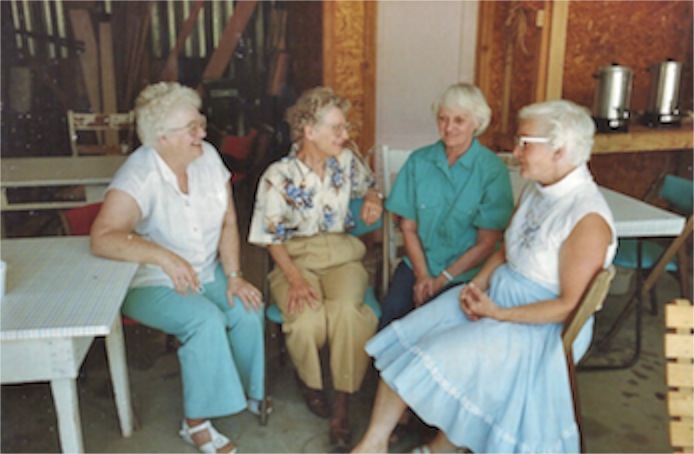 What I remember most, however, is how close the sisters remained. The three in Montana and the fourth in Washington D.C. were able to overcome whatever physical distance existed between them. They figured out how to stay connected through letters in days when long distance phone calls were very rare. They got together whenever they could and thoroughly enjoyed being together whenever they were able. We enjoyed hearing the stories of their childhood and teenage years and it seemed like there was always a new story each time the sisters got together.
What I remember most, however, is how close the sisters remained. The three in Montana and the fourth in Washington D.C. were able to overcome whatever physical distance existed between them. They figured out how to stay connected through letters in days when long distance phone calls were very rare. They got together whenever they could and thoroughly enjoyed being together whenever they were able. We enjoyed hearing the stories of their childhood and teenage years and it seemed like there was always a new story each time the sisters got together.
After our mother was widowed and our aunt retired, they were able to get together a bit more often. Our mom was able to make a few trips to Washington D.C. alone and later was able to visit our aunt in her home in Florida where she moved upon retirement. The cost of phone calls decreased and the two sisters were even able to have a couple of video chats over the computer before our mother died.
Our aunt passed away yesterday. It wasn’t a shock. We knew that she was facing serious health challenges. She had suffered a stroke and was a in a rehabilitation center following her time in the hospital. Still, we had no way of knowing that yesterday would be the day. She was the last of the sisters to die. We no longer have any living aunts on that side of our family. Only one of our father’s siblings is still living. The generation is passing.
As a child growing up, you seldom think of the passing of your elders. It seems like your parents and aunts and uncles will go on forever. We were blessed with a close family that made getting together a high priority. We had the example of our parents’ relationships with their siblings as a model of how family should be. Looking back from this moment, I have become aware of how our children have been paying attention to our relationships with our siblings as one of the models for their lives.
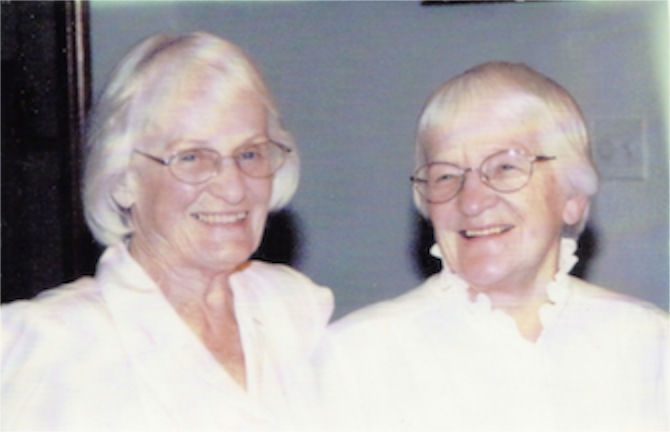 There was a special lesson that we learned from our Aunt Lois. It is simply that love is stronger than distance. Even when family is a long way away, close relationships are possible. In seminary we had academic discussions about the transcendent power of love. I already knew about that transcendence from living in a family. The book learning was merely reinforcing a truth that I already knew and understood. Love can overcome big distances.
There was a special lesson that we learned from our Aunt Lois. It is simply that love is stronger than distance. Even when family is a long way away, close relationships are possible. In seminary we had academic discussions about the transcendent power of love. I already knew about that transcendence from living in a family. The book learning was merely reinforcing a truth that I already knew and understood. Love can overcome big distances.
And so this morning as I reflect on the wonderful family with which I was blessed and the delightful love that was demonstrated all around me, I am cheered by the memory of those sisters when they were able to be together. How much they enjoyed those times. What treasures they were each time they occurred!
And here is one more theological reflection: Love transcends death. The power of love is stronger than death itself. I’ve never been good at speculating the exact nature of heaven or what happens after we die. I’ve been comfortable leaving that to the realm of faith. But I am confident that one of the characteristics of that realm is love. Another, I believe, is reunion.
I am confident that the sisters are reunited and once again taking great delight in being together. Love never dies.
One of the things that I have always remembered was how glad my mother was to see her sister. They immediately took up conversation on many different subjects, including remembering lots of stories from their years of growing up. They were the two youngest of the sisters and had been close all of their lives.
Over the years we got to see our aunt on many occasions – more often from her coming out to Montana than from us going to Washington DC, but we did make another family trip out there when I was a teenager. By that time our aunt was working in the office of Senator Alan Cranston. Our tour of the Capitol building was highlighted by a visit to the Senator’s office to see where our aunt worked. Later she worked in the Congressional office of Gladys Spellman, who represented the 5th congressional district of Maryland. She was working in the Spellman office when the representative collapsed from a heart attack. Spellman remained comatose for the rest of her life.
I was always proud to have an aunt who lived in Washington, D.C. There was something exotic about someone who lived in a distant city and was somehow close to the government of our country. I think there was a bit of admiration for the courage that she must have had to leave Montana for life in a very different part of the country. We knew many people who had grown up and stayed in our state. Knowing someone who had moved a long ways away seemed a bit special. Knowing someone who worked in the U.S. Capitol was unique among our peers.

After our mother was widowed and our aunt retired, they were able to get together a bit more often. Our mom was able to make a few trips to Washington D.C. alone and later was able to visit our aunt in her home in Florida where she moved upon retirement. The cost of phone calls decreased and the two sisters were even able to have a couple of video chats over the computer before our mother died.
Our aunt passed away yesterday. It wasn’t a shock. We knew that she was facing serious health challenges. She had suffered a stroke and was a in a rehabilitation center following her time in the hospital. Still, we had no way of knowing that yesterday would be the day. She was the last of the sisters to die. We no longer have any living aunts on that side of our family. Only one of our father’s siblings is still living. The generation is passing.
As a child growing up, you seldom think of the passing of your elders. It seems like your parents and aunts and uncles will go on forever. We were blessed with a close family that made getting together a high priority. We had the example of our parents’ relationships with their siblings as a model of how family should be. Looking back from this moment, I have become aware of how our children have been paying attention to our relationships with our siblings as one of the models for their lives.

And so this morning as I reflect on the wonderful family with which I was blessed and the delightful love that was demonstrated all around me, I am cheered by the memory of those sisters when they were able to be together. How much they enjoyed those times. What treasures they were each time they occurred!
And here is one more theological reflection: Love transcends death. The power of love is stronger than death itself. I’ve never been good at speculating the exact nature of heaven or what happens after we die. I’ve been comfortable leaving that to the realm of faith. But I am confident that one of the characteristics of that realm is love. Another, I believe, is reunion.
I am confident that the sisters are reunited and once again taking great delight in being together. Love never dies.
Copyright © 2012 by Ted Huffman. I wrote this. If you want to copy it, please ask for permission. There is a contact me button at the bottom of this page. If you want to share my blog a friend, please direct your friend to my web site.
The Land Mourns
12/03/12 05:57
For Lent this year, we are using a video Bible Study series. In general, I have avoided video series. I think that we have all too much television in our lives and I am simply not a fan of the medium. But this year, I was a proponent of this particular study because it gave us the opportunity to hear and see Dr. Walter Brueggemann give a short commentary on the text each week. The presentations by Dr. Brueggemann are 10 to 15 minutes. Then we stop the video and discuss what we have heard in our small group. The video also has a small group discussion of people who heard the original presentation by Dr. Brueggemann. We also watch that small group and use their discussion as a starting point for our continuing discussions. It has been working well. Our small group here in Rapid City has been engaged, involved, and inspired by the study.
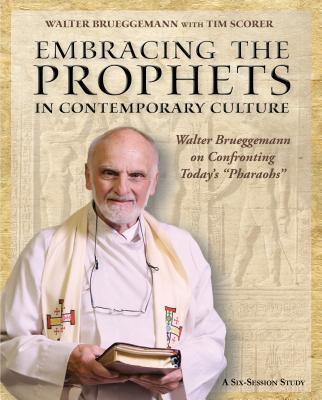 Last night I was struck by an idea that Dr. Brueggemann presented that we didn’t get around to discussing in detail. That is often the case with me and study groups. I get the glimmer of an idea, but it takes me time to process the thought and by the time I have something to say the group has ended and people have gone on to other activities in their lives. At times I think I’m pretty good at thinking on my feet and responding in the moment. At other times, I seem to process ideas slowly and it just takes me time to formulate my thoughts and reactions.
Last night I was struck by an idea that Dr. Brueggemann presented that we didn’t get around to discussing in detail. That is often the case with me and study groups. I get the glimmer of an idea, but it takes me time to process the thought and by the time I have something to say the group has ended and people have gone on to other activities in their lives. At times I think I’m pretty good at thinking on my feet and responding in the moment. At other times, I seem to process ideas slowly and it just takes me time to formulate my thoughts and reactions.
Here is the idea. Dr. Brueggemann says that the Bible is full of passages that speak of God’s glory and beneficence in creation. In the Sinai covenant, God declares that God will be our God if we will be God’s people. One of the blessings of this relationship is the continuing creation of God. But the prophets warn that there are real life consequences to our behavior when we ignore the covenant. If we do not obey the commandments, we distance ourselves from God. Jeremiah suggests that such a break in the relationship results in an undoing of creation.
It is not that God somehow intervenes in the processes of this world out of some vindictive desire to punish us. Rather the nature of creation is that when we ignore our role as stewards and caregivers, our lifestyle consumes resources in a way that is unsustainable.
Jeremiah says “the land mourns.” It is the poetic way of describing a drought.
According to the experts, we have not yet returned to drought conditions here in the hills. The abundant moisture of the winter and spring of 2010-2011 has not returned, but technically it takes more than a dry spell to make a drought.
Still, the grass crackles underfoot when we go for a walk. The dry pine needles and dry grass seem to be ready to burst into flame. We have taken to sniffing the air each time we go outside. There have been a few too many fires for so early in the season. The Cowboy hill fire on Friday was a warning to all of us. A little before noon we saw smoke rising and heard the sirens of the trucks rushing to the area. They fought fire long and hard for more than nine hours before getting that one contained. They had to bring in a helicopter and a retardant bomber before the firefighters got the upper hand. It was 24 hours later before they got around to packing up the mobile command center and pulling all of the equipment off of the fire. A few hours later we could see smoke rising from the Nemo Road area, where a fire was burning on land that had been burned in the 1988 Westbury Trails fire. So far we haven’t lost any homes, but we know that can happen.
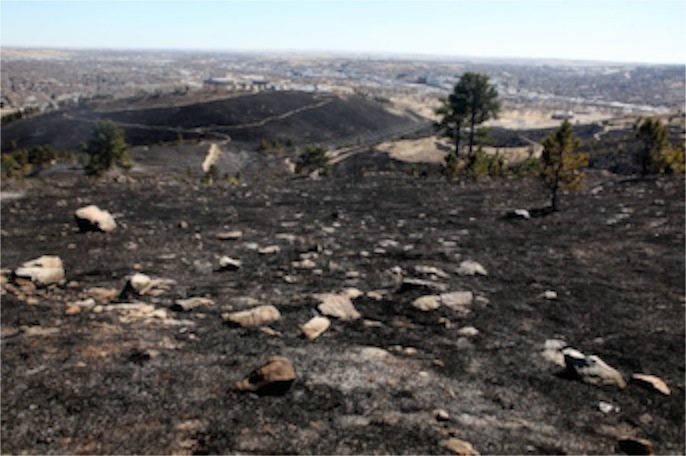 Those of us who have seen a few too many fires in our lives are a bit jittery. We keep scanning the sky for clouds and telling stories of the really big spring blizzards that we have seen. A couple of feed of wet snow wouldn’t be unwelcome at this point. If we don’t get a wet spring, it is going to be a long summer. One of the benefits of the moist year last year is that the grass grew tall. It is all now dry and long and the fuels have really built up on the hillsides. When we get fires in this country, they tend to burn into steep areas where they are hard to fight.
Those of us who have seen a few too many fires in our lives are a bit jittery. We keep scanning the sky for clouds and telling stories of the really big spring blizzards that we have seen. A couple of feed of wet snow wouldn’t be unwelcome at this point. If we don’t get a wet spring, it is going to be a long summer. One of the benefits of the moist year last year is that the grass grew tall. It is all now dry and long and the fuels have really built up on the hillsides. When we get fires in this country, they tend to burn into steep areas where they are hard to fight.
Ray Bubb, division chief for the South Dakota Wildland Fire Suppression division says “The fire danger is as high as it gets. It’s as dry and dead as it gets. People need to be careful.”
Maybe the land is mourning. Jeremiah, in his poetic voice, asks, “How long will the land mourn and the grass of every field wither?” (Jeremiah 12:4) We can understand his question. We’re ready for some soaking rains or some soggy snow so that the green will begin to appear on the hillsides and the smell of fresh grass will replace the dry crackling underfoot each time we take a little walk.
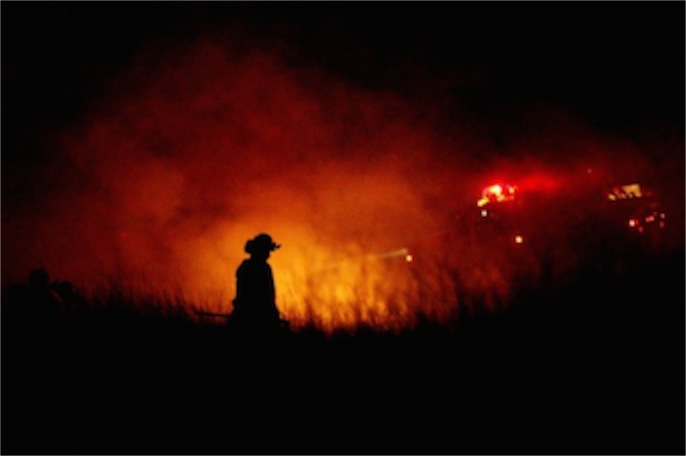 I know that the cycles of drought and moisture are a part of this land and have been a part of this land for as long as any one can remember. We don’t exactly live in a rainforest. One thing that attracts people to this country is the fact that most days are sunny and the weather is mild. One day last year when it had rained for several days in a row, someone said, “If I had wanted to live in Seattle, I would have moved to Seattle.” Of course we don’t ever get rain like some places and Rapid City isn’t really very much like Seattle in its weather patterns or in its traffic. But those of us who live here actually like the weather we get most of the time.
I know that the cycles of drought and moisture are a part of this land and have been a part of this land for as long as any one can remember. We don’t exactly live in a rainforest. One thing that attracts people to this country is the fact that most days are sunny and the weather is mild. One day last year when it had rained for several days in a row, someone said, “If I had wanted to live in Seattle, I would have moved to Seattle.” Of course we don’t ever get rain like some places and Rapid City isn’t really very much like Seattle in its weather patterns or in its traffic. But those of us who live here actually like the weather we get most of the time.
Still we could use a little rain.
After all, another characteristic that describes us well is that we like to complain about the weather.
I haven’t formed a complete theology of drought. I have only formulated a few ideas, stirred up by Dr. Brueggemann’s presentation. Sometimes it takes a while for me to organize my thoughts. In the meantime, it wouldn’t hurt to pay a little attention to the commandments.

Here is the idea. Dr. Brueggemann says that the Bible is full of passages that speak of God’s glory and beneficence in creation. In the Sinai covenant, God declares that God will be our God if we will be God’s people. One of the blessings of this relationship is the continuing creation of God. But the prophets warn that there are real life consequences to our behavior when we ignore the covenant. If we do not obey the commandments, we distance ourselves from God. Jeremiah suggests that such a break in the relationship results in an undoing of creation.
It is not that God somehow intervenes in the processes of this world out of some vindictive desire to punish us. Rather the nature of creation is that when we ignore our role as stewards and caregivers, our lifestyle consumes resources in a way that is unsustainable.
Jeremiah says “the land mourns.” It is the poetic way of describing a drought.
According to the experts, we have not yet returned to drought conditions here in the hills. The abundant moisture of the winter and spring of 2010-2011 has not returned, but technically it takes more than a dry spell to make a drought.
Still, the grass crackles underfoot when we go for a walk. The dry pine needles and dry grass seem to be ready to burst into flame. We have taken to sniffing the air each time we go outside. There have been a few too many fires for so early in the season. The Cowboy hill fire on Friday was a warning to all of us. A little before noon we saw smoke rising and heard the sirens of the trucks rushing to the area. They fought fire long and hard for more than nine hours before getting that one contained. They had to bring in a helicopter and a retardant bomber before the firefighters got the upper hand. It was 24 hours later before they got around to packing up the mobile command center and pulling all of the equipment off of the fire. A few hours later we could see smoke rising from the Nemo Road area, where a fire was burning on land that had been burned in the 1988 Westbury Trails fire. So far we haven’t lost any homes, but we know that can happen.

Ray Bubb, division chief for the South Dakota Wildland Fire Suppression division says “The fire danger is as high as it gets. It’s as dry and dead as it gets. People need to be careful.”
Maybe the land is mourning. Jeremiah, in his poetic voice, asks, “How long will the land mourn and the grass of every field wither?” (Jeremiah 12:4) We can understand his question. We’re ready for some soaking rains or some soggy snow so that the green will begin to appear on the hillsides and the smell of fresh grass will replace the dry crackling underfoot each time we take a little walk.

Still we could use a little rain.
After all, another characteristic that describes us well is that we like to complain about the weather.
I haven’t formed a complete theology of drought. I have only formulated a few ideas, stirred up by Dr. Brueggemann’s presentation. Sometimes it takes a while for me to organize my thoughts. In the meantime, it wouldn’t hurt to pay a little attention to the commandments.
Copyright © 2012 by Ted Huffman. I wrote this. If you want to copy it, please ask for permission. There is a contact me button at the bottom of this page. If you want to share my blog a friend, please direct your friend to my web site.
Hope a year after
11/03/12 05:36
There are turning points in life – dates that you always remember. For most people here in the United States 9-11 has become a date etched in the public memory. In Japan, the date is 3 – 11. That’s today. Today is the one-year anniversary of the devastating 9.0 magnitude earthquake, tsunami and nuclear disaster that were all rolled into one. At 2:46 p.m. the precise moment when the earthquake pulsed 80 miles off the northeastern coast of Japan, the country paused for a moment of silence. Emperor Akihito, just 22 days after bypass surgery, stood and joined his nation in their expression of grief and loss.
The loss is huge. The official toll lists 15,853 confirmed deaths and an additional 3,282 missing. 6,023 are listed as injured. Grief for those who have died has merged with grief for those missing and the country comes to grips with the simple fact that there are many bodies that will never be recovered.
 Hundreds of thousands of lives are still in turmoil. More than 330,000 people are still living in temporary shelters. The government estimates that there is over 25 million tons of debris, of which only about 5% has been processed. Piles upon piles of wood, concrete and steel fill fields near the worst hit areas. The financial costs are staggering and will not be fully known for years.
Hundreds of thousands of lives are still in turmoil. More than 330,000 people are still living in temporary shelters. The government estimates that there is over 25 million tons of debris, of which only about 5% has been processed. Piles upon piles of wood, concrete and steel fill fields near the worst hit areas. The financial costs are staggering and will not be fully known for years.
So, in the midst of the destruction and debris, in the midst of disrupted lives, in the midst of grief and uncertainty, the nation paused for a moment of silence. Bells rang, prayers were offered, incense sticks and candles were lit, and the world watched as the nation paused briefly.
Then they went back to work.
The rebuilding has barely begun. Huge piles of wreckage dominate the landscape where people hope that one day soon there will be the sounds and sights of construction. There are dreams of rebuilding.
In the midst of all of it, there are a few signs of hope.
 At Rikuzentakata, the surge of the tsunami was 44 feet high. The sea wall was destroyed. The pine forest that surrounded the town was laid waste. The highest number of missing is the count of people who once lived in Rikuzentakata. Thousands may never be found, though families are still hoping that bodies may one day be found for proper burial. The new sea wall has been built – higher and stronger than the old one. And in the midst of the devastation and debris, a lone tree stands. It has become famous throughout Japan as a symbol of resilience and survival and hope.
At Rikuzentakata, the surge of the tsunami was 44 feet high. The sea wall was destroyed. The pine forest that surrounded the town was laid waste. The highest number of missing is the count of people who once lived in Rikuzentakata. Thousands may never be found, though families are still hoping that bodies may one day be found for proper burial. The new sea wall has been built – higher and stronger than the old one. And in the midst of the devastation and debris, a lone tree stands. It has become famous throughout Japan as a symbol of resilience and survival and hope.
The pine tree is the symbol of Rikukzenkata. The locals can remember the time, just over a year ago, when 70.000 pine trees stood along the beach in the area. Only one survived the rush of water. The trees were planted about 350 years ago as a shield against the sea air to protect agricultural produce. The trees became a larger source of income than the crops they were planted to protect. Before the tsunami, over a million tourists visited the area each year to take in the sea and look at the beautiful trees.
Locals have vowed to once again plant new trees, even if it takes hundreds of years for the forest to recover.
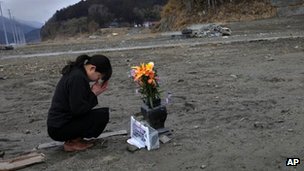 At Otsuchi, after the earthquake came the tsunami. After the tsunami, came a fire that ravaged the entire city and destroyed most of the buildings that had survived the quake and flood. All that remains today are foundations. In order to facilitate the clean up, crews have laid new roads into the area and some access roads have been built within the city, between the foundations, to facilitate the work of crews who are sorting rubble to see what can be recovered or recycled. The work isn’t going as quickly as hoped. Crews, however, are on the job each day and to support the crews, vending machines have been installed at various locations throughout the town. In a scene of devastation, the machines stand as a sign that normalcy might one day return. You wouldn’t think that a pop machine would be a sign of hope, but for those who come back to the area to wonder whether or not they will one day have a home to replace the one that was lost, seeing the machines is a powerful symbol that life is returning, even if progress is much slower than desired.
At Otsuchi, after the earthquake came the tsunami. After the tsunami, came a fire that ravaged the entire city and destroyed most of the buildings that had survived the quake and flood. All that remains today are foundations. In order to facilitate the clean up, crews have laid new roads into the area and some access roads have been built within the city, between the foundations, to facilitate the work of crews who are sorting rubble to see what can be recovered or recycled. The work isn’t going as quickly as hoped. Crews, however, are on the job each day and to support the crews, vending machines have been installed at various locations throughout the town. In a scene of devastation, the machines stand as a sign that normalcy might one day return. You wouldn’t think that a pop machine would be a sign of hope, but for those who come back to the area to wonder whether or not they will one day have a home to replace the one that was lost, seeing the machines is a powerful symbol that life is returning, even if progress is much slower than desired.
We are far from Japan. But our prayers will join with the prayers of others around the world as we seek to share a bit of their grief. Throughout the years, our sisters and brothers in Japan have been the focus of our prayers in worship, in our Vacation Bible School, which devoted a day to Japan, and in many other settings as we once again recall that we are linked and bonded with people who live in distant locations.
Today at a ceremony at Tokyo’s National Theater, Emperor Akihito said, “We shall not let our memory of the disasters fade. I hope all the people will keep the victims in their hearts.”
Those who have suffered sudden and traumatic loss often express a fear that their loved one will be forgotten. They know first hand how quickly things can change. They know that the will never forget the loved one who has now died. They look incredulously as the world goes on and think to themselves, “How can things be normal after this?” Over time they begin to fear that memory will fade and the one they loved will somehow be forgotten. In places where the world has experienced massive loss of life, where death has overwhelmed us, we have always pledged to never forget. This is now true of the ones who were swept away by the tsunami. We will not forget.
We will not forget that they were fathers and mothers and sons and daughters. We will not forget that they had hopes and fears and dreams that were their own. We will not forget that they lived and loved. We will not reduce human lives to mere statistics only.
At 2:46 p.m. today, I will be issuing the call to worship at a regular service at Westhills South Assisted Living. I will mention the people of Japan in my invocation and again in my sermon and in other prayers. We will pause for a moment of solidarity with those who have been praying all day long, as the earth turns and the moment arrives in various time zones. It will be night in Japan as we pray.
And when darkness descends in our part of the earth, the sun will be rising in Japan and hope will be present as the workers go back to their jobs. It will be years of recovery work. And we know that for many “normal” will never return. Like them, we will not forget.
The loss is huge. The official toll lists 15,853 confirmed deaths and an additional 3,282 missing. 6,023 are listed as injured. Grief for those who have died has merged with grief for those missing and the country comes to grips with the simple fact that there are many bodies that will never be recovered.

So, in the midst of the destruction and debris, in the midst of disrupted lives, in the midst of grief and uncertainty, the nation paused for a moment of silence. Bells rang, prayers were offered, incense sticks and candles were lit, and the world watched as the nation paused briefly.
Then they went back to work.
The rebuilding has barely begun. Huge piles of wreckage dominate the landscape where people hope that one day soon there will be the sounds and sights of construction. There are dreams of rebuilding.
In the midst of all of it, there are a few signs of hope.

The pine tree is the symbol of Rikukzenkata. The locals can remember the time, just over a year ago, when 70.000 pine trees stood along the beach in the area. Only one survived the rush of water. The trees were planted about 350 years ago as a shield against the sea air to protect agricultural produce. The trees became a larger source of income than the crops they were planted to protect. Before the tsunami, over a million tourists visited the area each year to take in the sea and look at the beautiful trees.
Locals have vowed to once again plant new trees, even if it takes hundreds of years for the forest to recover.

We are far from Japan. But our prayers will join with the prayers of others around the world as we seek to share a bit of their grief. Throughout the years, our sisters and brothers in Japan have been the focus of our prayers in worship, in our Vacation Bible School, which devoted a day to Japan, and in many other settings as we once again recall that we are linked and bonded with people who live in distant locations.
Today at a ceremony at Tokyo’s National Theater, Emperor Akihito said, “We shall not let our memory of the disasters fade. I hope all the people will keep the victims in their hearts.”
Those who have suffered sudden and traumatic loss often express a fear that their loved one will be forgotten. They know first hand how quickly things can change. They know that the will never forget the loved one who has now died. They look incredulously as the world goes on and think to themselves, “How can things be normal after this?” Over time they begin to fear that memory will fade and the one they loved will somehow be forgotten. In places where the world has experienced massive loss of life, where death has overwhelmed us, we have always pledged to never forget. This is now true of the ones who were swept away by the tsunami. We will not forget.
We will not forget that they were fathers and mothers and sons and daughters. We will not forget that they had hopes and fears and dreams that were their own. We will not forget that they lived and loved. We will not reduce human lives to mere statistics only.
At 2:46 p.m. today, I will be issuing the call to worship at a regular service at Westhills South Assisted Living. I will mention the people of Japan in my invocation and again in my sermon and in other prayers. We will pause for a moment of solidarity with those who have been praying all day long, as the earth turns and the moment arrives in various time zones. It will be night in Japan as we pray.
And when darkness descends in our part of the earth, the sun will be rising in Japan and hope will be present as the workers go back to their jobs. It will be years of recovery work. And we know that for many “normal” will never return. Like them, we will not forget.
Copyright © 2012 by Ted Huffman. I wrote this. If you want to copy it, please ask for permission. There is a contact me button at the bottom of this page. If you want to share my blog a friend, please direct your friend to my web site.
Planing Wood
10/03/12 04:56
I grew up in a family that respected tools. When I was a very young boy, my father made a workbench for me as a Christmas gift. With the bench, I received a vise, a handsaw, a claw hammer, two screwdrivers (1 slotted, one Phillips) an assortment of scraps of wood, screws and nails and a small Stanley trimming plane. I had some familiarity with most of the tools, but the little block plane was a fascination for me. I new that my father and my grandfather had larger block planes. I also knew that those tools were not to be used by children. I had been allowed to use a crosscut saw and a claw hammer. I had been allowed to try my hand with screwdrivers. But the planes were off limits for me until the day I received my own.
My dad set the blade for me and clamped a short piece of 2 x 4 in the vise. He had me start by peeling off the corner of the block. Each swipe brought a slightly larger curl of wood than the one before. I worked the corner until I was able to cut a piece of about a half-inch then turned the block and worked on another corner. The throat off the plane was about and inch wide, but I didn’t have the strength to push it on a thicker surface. My little plane and I were not up to trimming a door yet.
The plane soon became dull and I couldn’t get the smooth curls of wood that had made my initial use of the tool so much fun. I began to realize that there was a lot more that needed to be learned. The workbench was a Christmas gift. The next summer, for my birthday, I received my first pocketknife. There was another gift that birthday, from my Uncle Ted. It didn’t look like much, really. It was a flat piece of Missouri soapstone. And with the sharpening stone began my lessons from Uncle Ted on sharpening and honing blades.
I still don’t own any fancy sharpening tools. I don’t have a honing guide. I hold my blades at their angles by hand. I don’t have a fancy stone holder. My stone is in a simple cedar box. But I can put a razor edge on a blade when I need one.
 Over the years I have collected the planes of my elders. I have My father’s Stanley #2 block plane and I have a couple of larger planes from my grandfather. I have one plane that belonged to Susan’s grandfather. I still have the little plane from my childhood and it is a good trimming plane. But there is one plane that I have purchased. It is a small bullnose rabbet plane. The body of the plane is cast in such a way that the blade is exposed on the right and left sides so you can cut a square edge when taking the corner off of a board. It is a tricky blade to sharpen, because in addition to the precise 25-degree angle, you have to keep the corners just right. When everything is honed properly, it cuts sweetly with even, paper-thin curls.
Over the years I have collected the planes of my elders. I have My father’s Stanley #2 block plane and I have a couple of larger planes from my grandfather. I have one plane that belonged to Susan’s grandfather. I still have the little plane from my childhood and it is a good trimming plane. But there is one plane that I have purchased. It is a small bullnose rabbet plane. The body of the plane is cast in such a way that the blade is exposed on the right and left sides so you can cut a square edge when taking the corner off of a board. It is a tricky blade to sharpen, because in addition to the precise 25-degree angle, you have to keep the corners just right. When everything is honed properly, it cuts sweetly with even, paper-thin curls.
Last evening, I had a few minutes to work on my rowboat project. It doesn’t look like anything yet. Since this project is using plywood instead of dimension lumber, I haven’t even generated my usual amount of sawdust. But I have the planks glued up and there is a stack of them on the worktable. The boat will be lapstrake which means that the planks overlap each other. Where they lap, there is a rabbet, a small place on the edge of the plywood where some wood is cut away for the next plank to fit. The rabbets on one edge of the board can be cut with a router as they run the entire length of the plank. On the other side, at the bow, each plank needs a gain to be cut. The gain is like a small ramp. On this boat the gains are 10” long. This isn’t thick plywood, so the ramp starts at the surface of the board and is 1/8 inch deep at the end. I’m working with fancy okume (and expensive) marine plywood with really thin plies, so I cut through about four plies in that 1/8-inch.
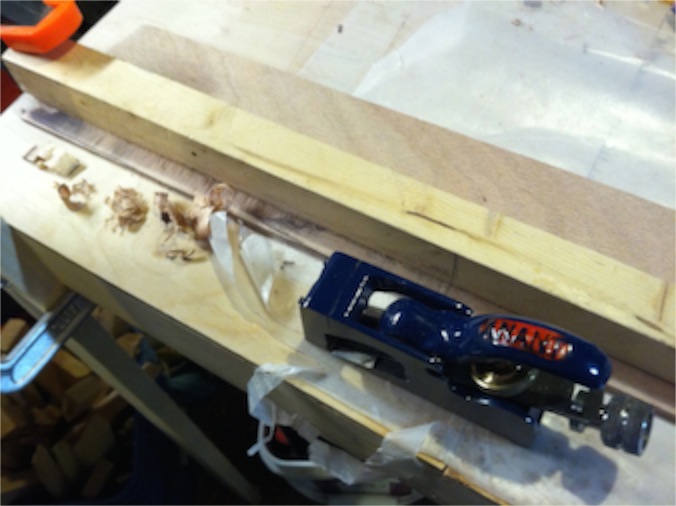 Plywood is hard to work with a plane because each layer has a different grain direction. To cut a gain, you have to work with multiple plies of the wood with each swipe. Firm pressure is required to keep the blade from skipping on the cross grain layers. Last night I carefully honed the blade of my rabbet plane. Then I took some 150 grit black paper and set it on the saw table and carefully polished the foot of the plane so it was perfectly true. I put the blade in the plane and adjusted the cut for a very thin slice. I tested it on a scrap piece of plywood and it worked beautifully.
Plywood is hard to work with a plane because each layer has a different grain direction. To cut a gain, you have to work with multiple plies of the wood with each swipe. Firm pressure is required to keep the blade from skipping on the cross grain layers. Last night I carefully honed the blade of my rabbet plane. Then I took some 150 grit black paper and set it on the saw table and carefully polished the foot of the plane so it was perfectly true. I put the blade in the plane and adjusted the cut for a very thin slice. I tested it on a scrap piece of plywood and it worked beautifully.
8 to 10 slices with the plane each a bit longer than the previous one left the gains cut just the way I wanted them. I paused between each slice to carefully clean the curls out of the plane. With the clamping and measuring it took me a couple of hours to cut the gains on ten planks. It is very satisfying work. It doesn’t look like much, but it will make a big difference in the final appearance of the boat.
 As I worked I thought about the work I do with people. People are sort of like plywood, with many layers and different appearances at different levels. Sometimes you need to get beneath the surface to know the real person. Scripture is definitely a layered study. The truth can be on the surface, but a surface reading rarely produces the deep truth. Studying the same passage over and over across the span of a life continues to reveal new depth and meaning. As my teacher Ross Snyder once wrote, it reveals “depth on depth of Spirit’s birth.”
As I worked I thought about the work I do with people. People are sort of like plywood, with many layers and different appearances at different levels. Sometimes you need to get beneath the surface to know the real person. Scripture is definitely a layered study. The truth can be on the surface, but a surface reading rarely produces the deep truth. Studying the same passage over and over across the span of a life continues to reveal new depth and meaning. As my teacher Ross Snyder once wrote, it reveals “depth on depth of Spirit’s birth.”
When you bring people and scripture together, it takes carefully honed skills to open the depths and reveal the truth. To stay on top of the craft, you have to continually hone your skills. For me, working with wood keeps my hands engaged while my mind works with the layers of people and text that I need to bring together each week.
We have been taught that Jesus’ father was a carpenter. I like to think that the boy learned techniques and tools in his father’s workshop. Maybe sometimes, at the end of a long week, he would take up a blade and work a piece of wood. When the curl of wood that you slice off is as pretty as the cut that you have made you know you are making progress. I like to think that time spent in the garage with my tools adds value to my sermons. It is a theory that I can’t prove, just a hunch that I hold.
My dad set the blade for me and clamped a short piece of 2 x 4 in the vise. He had me start by peeling off the corner of the block. Each swipe brought a slightly larger curl of wood than the one before. I worked the corner until I was able to cut a piece of about a half-inch then turned the block and worked on another corner. The throat off the plane was about and inch wide, but I didn’t have the strength to push it on a thicker surface. My little plane and I were not up to trimming a door yet.
The plane soon became dull and I couldn’t get the smooth curls of wood that had made my initial use of the tool so much fun. I began to realize that there was a lot more that needed to be learned. The workbench was a Christmas gift. The next summer, for my birthday, I received my first pocketknife. There was another gift that birthday, from my Uncle Ted. It didn’t look like much, really. It was a flat piece of Missouri soapstone. And with the sharpening stone began my lessons from Uncle Ted on sharpening and honing blades.
I still don’t own any fancy sharpening tools. I don’t have a honing guide. I hold my blades at their angles by hand. I don’t have a fancy stone holder. My stone is in a simple cedar box. But I can put a razor edge on a blade when I need one.

Last evening, I had a few minutes to work on my rowboat project. It doesn’t look like anything yet. Since this project is using plywood instead of dimension lumber, I haven’t even generated my usual amount of sawdust. But I have the planks glued up and there is a stack of them on the worktable. The boat will be lapstrake which means that the planks overlap each other. Where they lap, there is a rabbet, a small place on the edge of the plywood where some wood is cut away for the next plank to fit. The rabbets on one edge of the board can be cut with a router as they run the entire length of the plank. On the other side, at the bow, each plank needs a gain to be cut. The gain is like a small ramp. On this boat the gains are 10” long. This isn’t thick plywood, so the ramp starts at the surface of the board and is 1/8 inch deep at the end. I’m working with fancy okume (and expensive) marine plywood with really thin plies, so I cut through about four plies in that 1/8-inch.

8 to 10 slices with the plane each a bit longer than the previous one left the gains cut just the way I wanted them. I paused between each slice to carefully clean the curls out of the plane. With the clamping and measuring it took me a couple of hours to cut the gains on ten planks. It is very satisfying work. It doesn’t look like much, but it will make a big difference in the final appearance of the boat.

When you bring people and scripture together, it takes carefully honed skills to open the depths and reveal the truth. To stay on top of the craft, you have to continually hone your skills. For me, working with wood keeps my hands engaged while my mind works with the layers of people and text that I need to bring together each week.
We have been taught that Jesus’ father was a carpenter. I like to think that the boy learned techniques and tools in his father’s workshop. Maybe sometimes, at the end of a long week, he would take up a blade and work a piece of wood. When the curl of wood that you slice off is as pretty as the cut that you have made you know you are making progress. I like to think that time spent in the garage with my tools adds value to my sermons. It is a theory that I can’t prove, just a hunch that I hold.
Copyright © 2012 by Ted Huffman. I wrote this. If you want to copy it, please ask for permission. There is a contact me button at the bottom of this page. If you want to share my blog a friend, please direct your friend to my web site.
Dancing Spirits part 2
09/03/12 05:22
Different cultures have different ways of talking about time. We are prone to describe the past as “behind” us and the future as “before” us. In several tribal cultures, the mode of speaking is just the opposite. In such cultures, the past is that which is before. The past has been experienced and is known so it can be “seen” as something that lies before an individual. The future is unknown and unseen as something that is behind one. It may seem like a silly distinction – a quirk of language and perception, but in fact there are fundamental differences between the ways in which humans interpret events. Sometimes the differences in interpretation bring conflict that erupts into violence. The art of resolving conflict often requires the ability to see things differently – and to understand the perspective of the other.
How we view time affects our perceptions of many things. Whether it is ahead or behind, all humans live with a limited amount of time. Most of us know that we will one day die. Whether or not we are aware of it, we come with an expiration date. Whether we perceive time as linear or circular or in another shape or form, death looms as a huge transition. The span between this moment and the moment of our death is finite.
My work brings that truth to me every day. Here are a few vignettes from my life:
We are in a hospital room. It has been a tiring day for the patient. She was an elder for a long time before she broke her hip. Since then she has endured surgery and physical therapy and no small amount of pain. A couple of days ago she commented, “I wouldn’t recommend taking this up as a hobby.” This day she is tired and having trouble keeping her eyes open. Still she wants to be a part of the conversations in the room and share with those who have come to visit. She begins to tell us a recipe that came from her grandparents. She describes to us the difference between sour cream, whipped cream, cottage cheese and clotted milk. She tells us that when she was a child, the women in her family would put milk into shallow bowls and leave it standing over night. She was struggling to remember the exact process, but after standing, it was heated and the clots were skimmed off of the top. This produced something the adults thought was wonderful – fit for Sunday breakfast – but that she as a child did not like. Her memories of the details were delightful for those of us who were there. We knew that pain and loss and grief and sadness were not just a part of what she had experienced, but that the day when we lose her will come. We were aware of how frail she was. So the gift of this moment and of her remembering the recipes became a rare treasure to be savored. It was sweeter than clotted milk.
Another scene: I am in the kitchen of a home that I entered for the first time just minutes ago. I am working hard to remember the names of the people I have just met – the family who lives in the home. There are two uniformed officers present and I am wearing an official identification badge. The family is struggling to come to grips with a sudden, traumatic and unexpected loss. Their emotions are raw. Tears are just beneath the surface and erupt unexpectedly. Just holding composure to speak with the strangers in their home is a huge effort. Their day has unfolded in ways that they could not have anticipated. The meanings of familiar places have been altered by the death of a son and a brother. They have known death and loss and grief before, but nothing like what they are experiencing. Their world seems unreal, unpredictable, out of control. There is information that I want to communicate, resources that I want to share. They don’t want to talk about it. They don’t even want to think about it. But they cannot avoid the death that has entered their lives today.
A conversation: After more than 65 years of marriage, the couple knows that one of them will likely die before the other. In fact one partner in the marriage is so old and frail that her body is shutting down. The process is not sudden. It is not dramatic. It requires incredible patience to sit and wait for the time that is coming. She has access to good care and they have long discussed which medical procedures they will pursue and which they will decline. The paperwork is complete. The advance directives and power of attorney have been established. But discussing these things in theory is not the same thing as making decisions in context. When she was in the hospice house her strongest desire was to come home. She made it the focus of her attention and worked hard. At home she can do little but lie in bed, being turned by others on a regular schedule. Home health care workers come in for eleven hours a day. Her beloved takes the night shift. We talk about how it is going. “Slowly,” he says. But I know that he is doing exactly what he wants to be doing. There is a bit of triumph in the plan that has brought her home. There is a bit of nervousness about the time that is yet to come. But there is no need to change the pace. There is no need to count minutes or hours. What is important right now is being together. Even if all they can do is share the same space and the sense of being incredibly tired.
Those are some of the stories I am privileged to witness. And those are from just one day – yesterday. I drove home in the dark, past my normal dinnertime, once again out of my schedule – not confined by the usual constraints of time. As I drove I kept looking to the north sky. I was hoping for a glimpse of the lights. The plan had been to bundle up and sit outside on my front porch and ponder the night sky for a while before turning in to bed. Plans are made to be changed. I didn’t see the northern lights. But I saw a gorgeous full moon and Venus and Jupiter engaged in their circle dance with us around the sun that had set.
I didn’t need to see the lights to remember that we are dancing with the spirits of those who are no longer living, but clearly remembered.
As I went into the warmth and light of our home with the aromas that meant that I was about to be well fed, I remembered the recipes and the tears and the sense of time that had been shared. For a moment I didn’t know if I was coming or going – if the future is ahead or behind. And it was not a problem. It was just right to be surrounded by memories and anticipation and to be reminded that each moment is a precious gift. Surely I have been dancing with the spirits.
How we view time affects our perceptions of many things. Whether it is ahead or behind, all humans live with a limited amount of time. Most of us know that we will one day die. Whether or not we are aware of it, we come with an expiration date. Whether we perceive time as linear or circular or in another shape or form, death looms as a huge transition. The span between this moment and the moment of our death is finite.
My work brings that truth to me every day. Here are a few vignettes from my life:
We are in a hospital room. It has been a tiring day for the patient. She was an elder for a long time before she broke her hip. Since then she has endured surgery and physical therapy and no small amount of pain. A couple of days ago she commented, “I wouldn’t recommend taking this up as a hobby.” This day she is tired and having trouble keeping her eyes open. Still she wants to be a part of the conversations in the room and share with those who have come to visit. She begins to tell us a recipe that came from her grandparents. She describes to us the difference between sour cream, whipped cream, cottage cheese and clotted milk. She tells us that when she was a child, the women in her family would put milk into shallow bowls and leave it standing over night. She was struggling to remember the exact process, but after standing, it was heated and the clots were skimmed off of the top. This produced something the adults thought was wonderful – fit for Sunday breakfast – but that she as a child did not like. Her memories of the details were delightful for those of us who were there. We knew that pain and loss and grief and sadness were not just a part of what she had experienced, but that the day when we lose her will come. We were aware of how frail she was. So the gift of this moment and of her remembering the recipes became a rare treasure to be savored. It was sweeter than clotted milk.
Another scene: I am in the kitchen of a home that I entered for the first time just minutes ago. I am working hard to remember the names of the people I have just met – the family who lives in the home. There are two uniformed officers present and I am wearing an official identification badge. The family is struggling to come to grips with a sudden, traumatic and unexpected loss. Their emotions are raw. Tears are just beneath the surface and erupt unexpectedly. Just holding composure to speak with the strangers in their home is a huge effort. Their day has unfolded in ways that they could not have anticipated. The meanings of familiar places have been altered by the death of a son and a brother. They have known death and loss and grief before, but nothing like what they are experiencing. Their world seems unreal, unpredictable, out of control. There is information that I want to communicate, resources that I want to share. They don’t want to talk about it. They don’t even want to think about it. But they cannot avoid the death that has entered their lives today.
A conversation: After more than 65 years of marriage, the couple knows that one of them will likely die before the other. In fact one partner in the marriage is so old and frail that her body is shutting down. The process is not sudden. It is not dramatic. It requires incredible patience to sit and wait for the time that is coming. She has access to good care and they have long discussed which medical procedures they will pursue and which they will decline. The paperwork is complete. The advance directives and power of attorney have been established. But discussing these things in theory is not the same thing as making decisions in context. When she was in the hospice house her strongest desire was to come home. She made it the focus of her attention and worked hard. At home she can do little but lie in bed, being turned by others on a regular schedule. Home health care workers come in for eleven hours a day. Her beloved takes the night shift. We talk about how it is going. “Slowly,” he says. But I know that he is doing exactly what he wants to be doing. There is a bit of triumph in the plan that has brought her home. There is a bit of nervousness about the time that is yet to come. But there is no need to change the pace. There is no need to count minutes or hours. What is important right now is being together. Even if all they can do is share the same space and the sense of being incredibly tired.
Those are some of the stories I am privileged to witness. And those are from just one day – yesterday. I drove home in the dark, past my normal dinnertime, once again out of my schedule – not confined by the usual constraints of time. As I drove I kept looking to the north sky. I was hoping for a glimpse of the lights. The plan had been to bundle up and sit outside on my front porch and ponder the night sky for a while before turning in to bed. Plans are made to be changed. I didn’t see the northern lights. But I saw a gorgeous full moon and Venus and Jupiter engaged in their circle dance with us around the sun that had set.
I didn’t need to see the lights to remember that we are dancing with the spirits of those who are no longer living, but clearly remembered.
As I went into the warmth and light of our home with the aromas that meant that I was about to be well fed, I remembered the recipes and the tears and the sense of time that had been shared. For a moment I didn’t know if I was coming or going – if the future is ahead or behind. And it was not a problem. It was just right to be surrounded by memories and anticipation and to be reminded that each moment is a precious gift. Surely I have been dancing with the spirits.
Copyright © 2012 by Ted Huffman. I wrote this. If you want to copy it, please ask for permission. There is a contact me button at the bottom of this page. If you want to share my blog a friend, please direct your friend to my web site.
Dancing Spirits
08/03/12 05:29
So far, the weather forecast for tonight for our part of the world is just right. We are supposed to have clear skies throughout all of the evening hours and beyond midnight. Temperatures will sink from about 44 degrees at 6 p.m. to an overnight low of about 32. That’s a few degrees warmer than it is right now, though the temperature is not what I’m looking for. What I am hoping for seems to be firmly in the forecast: clear skies.
Our house faces the North. From our front porch, the view is not quite toward magnetic north, but close enough to afford a good view in that direction. There are a few trees on the horizon, but the hill sinks away from us in that direction, so we can get a good view to the north and that is the direction that I plan to be looking.
 We live a bit too far south to see the Northern Lights. It is one thing that I miss about our present location. When we lived in North Dakota, I would get to see the northern lights most winters and I learned to look forward to evening drives that took me north from our home. But these days, glimpses of the lights are rare opportunities.
We live a bit too far south to see the Northern Lights. It is one thing that I miss about our present location. When we lived in North Dakota, I would get to see the northern lights most winters and I learned to look forward to evening drives that took me north from our home. But these days, glimpses of the lights are rare opportunities.
It is looking good tonight, though.
The earth is currently being battered by a storm of charged particles from the Sun. It is the largest solar storm in five years and today is the day the bombardment of particles will be the most intense. Some scientists are predicting that there could be disruptions in power grids, satellite navigation and the routing of some flights. Because the effects will be the most intense in Polar Regions, some flights may be re-directed away from their normal great circle routes to trips at lower latitudes.
All of this means that the Northern Lights may be seen at lower latitudes and tonight is the night with the best chance to see them in recent years.
If we miss them, we won’t worry. The sun’s storms seem to rise and fall on an eleven-year cycle and we are still on the upswing with the peak coming sometime next year. This particular storm involved a coronal mass ejection. A really huge ball of gas, traveling at a high speed has been blown off of the surface of the sun. The earth has a magnetic field that surrounds it. That field will protect us from the harmful radiation in the particles form the sun, but the magnetic field will be shaken. There will be electric currents in the atmosphere that are not normally there. Previous geomagnetic storms have knocked out long-distance phone service in some areas and even caused power blackouts. GPS signals may be disrupted.
 I’m ready for those things. Unless I get a dispatch from the LOSS team, I won’t need my GPS. Even then, if it is not working, I have the dispatch team to help me find my destination. I’m on call, but if the phone doesn’t work, I can’t be called. I do have both a landline and a cell phone, so one or the other is likely to work. And a short interruption of electrical service would make it really dark – the better to view the northern lights. It shouldn’t bee too cold to bundle up and go outside.
I’m ready for those things. Unless I get a dispatch from the LOSS team, I won’t need my GPS. Even then, if it is not working, I have the dispatch team to help me find my destination. I’m on call, but if the phone doesn’t work, I can’t be called. I do have both a landline and a cell phone, so one or the other is likely to work. And a short interruption of electrical service would make it really dark – the better to view the northern lights. It shouldn’t bee too cold to bundle up and go outside.
I’m ready.
Of course I may not see anything. Aurorae are by their nature unpredictable. What we are likely to have is a more diffuse light in the northern sky than the sharp bright color display that is visible from more northern locations. Still, I will be outside and looking tonight.
The Northern Lights have many different names. Scientists like to use Aurora Borealis for them. They call the similar phenomenon in the southern hemisphere Aurora Australis. Aurora was the Roman Goddess of Dawn. Boreas was the Greek name for the north wind. In 1621, Peter Gassendi but the two names together and the moniker stuck to this day. Unless you are far up in the North Country, the aurora appears close to the horizon, sort of like a sunrise coming from the wrong direction.
I wish I could remember the Cree words for the lights. A few years ago, when we were studying at the Saulteaux Resource Center in Manitoba, we heard the musical sounds of Cree from many native speakers. But my ear and memory for languages is not good and the words have slipped. But the Cree word for the lights means “Dancing Spirits.” In Cree beliefs the northern lights are the spirits of dead relatives dancing. A common practice that continues is a memorial feast and round dance. People travel from community to community to participate in the ceremonies. The ceremonies honor relatives who are no longer living and keep alive the traditions of the Cree people.
I am not of Cree heritage and I do not practice their ceremonies except as a guest when invited, but I do like the thought of those whom we have loved and who have died joining us as dancing spirits. I think my parents and grandparents, brother and sister might just be the sort of spirits who would enjoy dancing on a cold winter night. They were just the kind of people who would try to get us to dance with them.
Cree is a hard language for me. Root words take on different forms to adapt to gender and number. And the words for brother and sister are varied depending on birth order. The root words are: ohtawiyimaw for father; okawiyimaw for mother; ostesimaw for brother and omisimaw for sister, if my notes from those days are accurate. When Cree speakers say the words, they have to repeat over an over for me to even be able to hear the distinctions. Then they make subtle changes to change “father” into “grandfather” or “brother” into “little brother.” My ears are not trained to hear the subtle differences.
But if you lived in the North Country, far from roads and electricity, and if you had been successful in the fall hunts, there would be many long nights in the lodge to listen to the speech of the elders and learn to hear the distinctions. Some nights in the winter, the time would come to go outside and take a look at the lights. If the spirits were dancing it would be a good time to go visit others and join in the dance.

Tonight might be a good night for dancing with the spirits. I’m thinking my spirit could use a little dancing.
Our house faces the North. From our front porch, the view is not quite toward magnetic north, but close enough to afford a good view in that direction. There are a few trees on the horizon, but the hill sinks away from us in that direction, so we can get a good view to the north and that is the direction that I plan to be looking.

It is looking good tonight, though.
The earth is currently being battered by a storm of charged particles from the Sun. It is the largest solar storm in five years and today is the day the bombardment of particles will be the most intense. Some scientists are predicting that there could be disruptions in power grids, satellite navigation and the routing of some flights. Because the effects will be the most intense in Polar Regions, some flights may be re-directed away from their normal great circle routes to trips at lower latitudes.
All of this means that the Northern Lights may be seen at lower latitudes and tonight is the night with the best chance to see them in recent years.
If we miss them, we won’t worry. The sun’s storms seem to rise and fall on an eleven-year cycle and we are still on the upswing with the peak coming sometime next year. This particular storm involved a coronal mass ejection. A really huge ball of gas, traveling at a high speed has been blown off of the surface of the sun. The earth has a magnetic field that surrounds it. That field will protect us from the harmful radiation in the particles form the sun, but the magnetic field will be shaken. There will be electric currents in the atmosphere that are not normally there. Previous geomagnetic storms have knocked out long-distance phone service in some areas and even caused power blackouts. GPS signals may be disrupted.

I’m ready.
Of course I may not see anything. Aurorae are by their nature unpredictable. What we are likely to have is a more diffuse light in the northern sky than the sharp bright color display that is visible from more northern locations. Still, I will be outside and looking tonight.
The Northern Lights have many different names. Scientists like to use Aurora Borealis for them. They call the similar phenomenon in the southern hemisphere Aurora Australis. Aurora was the Roman Goddess of Dawn. Boreas was the Greek name for the north wind. In 1621, Peter Gassendi but the two names together and the moniker stuck to this day. Unless you are far up in the North Country, the aurora appears close to the horizon, sort of like a sunrise coming from the wrong direction.
I wish I could remember the Cree words for the lights. A few years ago, when we were studying at the Saulteaux Resource Center in Manitoba, we heard the musical sounds of Cree from many native speakers. But my ear and memory for languages is not good and the words have slipped. But the Cree word for the lights means “Dancing Spirits.” In Cree beliefs the northern lights are the spirits of dead relatives dancing. A common practice that continues is a memorial feast and round dance. People travel from community to community to participate in the ceremonies. The ceremonies honor relatives who are no longer living and keep alive the traditions of the Cree people.
I am not of Cree heritage and I do not practice their ceremonies except as a guest when invited, but I do like the thought of those whom we have loved and who have died joining us as dancing spirits. I think my parents and grandparents, brother and sister might just be the sort of spirits who would enjoy dancing on a cold winter night. They were just the kind of people who would try to get us to dance with them.
Cree is a hard language for me. Root words take on different forms to adapt to gender and number. And the words for brother and sister are varied depending on birth order. The root words are: ohtawiyimaw for father; okawiyimaw for mother; ostesimaw for brother and omisimaw for sister, if my notes from those days are accurate. When Cree speakers say the words, they have to repeat over an over for me to even be able to hear the distinctions. Then they make subtle changes to change “father” into “grandfather” or “brother” into “little brother.” My ears are not trained to hear the subtle differences.
But if you lived in the North Country, far from roads and electricity, and if you had been successful in the fall hunts, there would be many long nights in the lodge to listen to the speech of the elders and learn to hear the distinctions. Some nights in the winter, the time would come to go outside and take a look at the lights. If the spirits were dancing it would be a good time to go visit others and join in the dance.

Tonight might be a good night for dancing with the spirits. I’m thinking my spirit could use a little dancing.
Copyright © 2012 by Ted Huffman. I wrote this. If you want to copy it, please ask for permission. There is a contact me button at the bottom of this page. If you want to share my blog a friend, please direct your friend to my web site.
Webs of Relationships
07/03/12 05:06
I have been thinking about webs recently. Spiders, of course have their reasons for building webs. Insects become trapped in the webs, providing a food source for the spider. There is archeological evidence of spider webs as old as 140 million years. The silk web material was captured in amber from the early Cretaceous period. Scientists believe that when spiders began to move from the water to the land they started making silk to protect their bodies and eggs. Gradually the silk was used for hunting purposes, first as guide or signal lines, later as ground webs, and eventually as aerial webs.
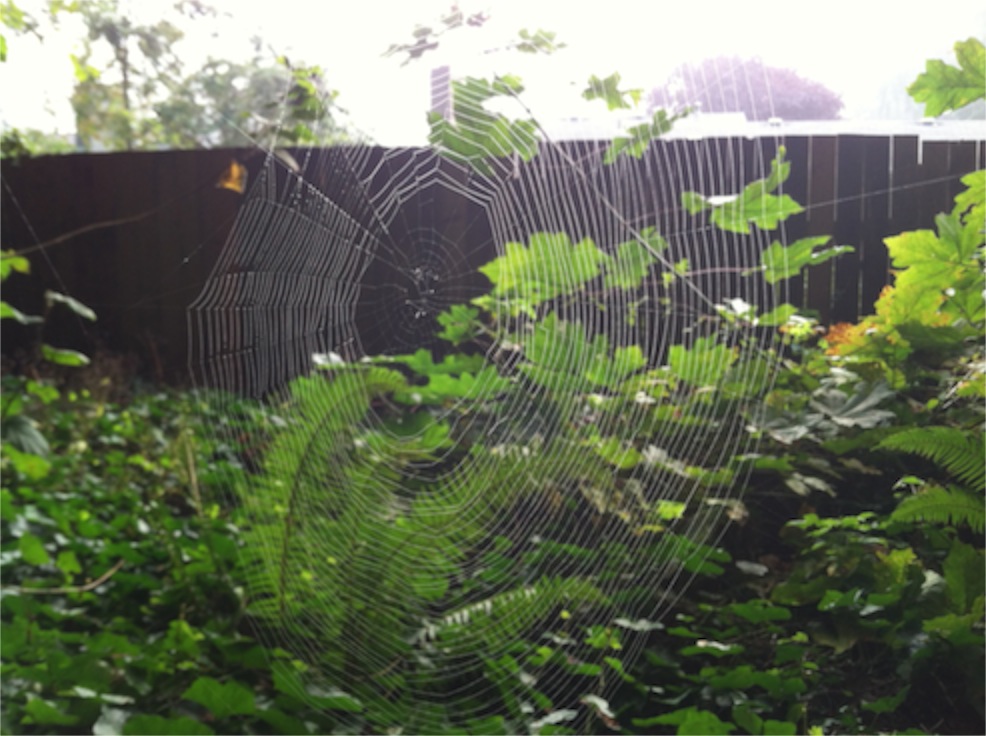
Spiders save energy by not having to run down their prey. However, the process of making the silk requires a large amount of protein. Some spiders recycle their webs by eating and recycling the protein.
Spider webs are strong. The tensile strength of spider silk is greater than the same weight to steel and is much more elastic. Scientists are working to discover ways to use the material in products as diverse as bulletproof vests and artificial tendons to help people recover after injuries.
But I have been thinking of webs in a different way. I have been thinking of them as a metaphor for the networks of relationships we humans develop. A spider begins by stretching a silk line from one point to another. Then another line is stretched to another point. Multiple lines connect many different objects. Then the spider begins to connect the various lines with other lines until the entire network is so connected that the spider can feel vibration from any point in the network. We connect ourselves in networks of relationships. What happens to another person has an effect on us.
Much attention has been given lately to computer-mediated social networking. People invest incredible amounts of time developing relationships through sites such as Facebook and LinkedIn. I have participated in those and other networking tools, but am also aware of how much time they can take. There is a distance that the computer provides that makes such networking a bit less satisfying than in person relationships. Nonetheless, it is a good way to maintain relationships over large distances. We get to see pictures of friends who live in other countries and keep up with their families in ways that were not practical before.
Spiders, it appears, are more adaptable than we humans.
 Recently, floodwaters forced the evacuation of Wagga Wagga, a town in Australia. The human inhabitants weren’t the only ones who were forced to flee. When the floodwaters swamped the town and surrounding fields, thousands upon thousands of spiders were forced to relocate. The flood triggered what is called a mass ballooning event. The spiders spin a sail of silk and are carried by the wind to another location. When thousands of spiders land in the same place, there is a mass and they all set about spinning new webs. There are fields that have turned white with spider webs topping every bush and stalk of grass. The spiders are harmless to humans, but the numbers can be a bit overwhelming, especially to those who aren’t fond of the creatures in the first place.
Recently, floodwaters forced the evacuation of Wagga Wagga, a town in Australia. The human inhabitants weren’t the only ones who were forced to flee. When the floodwaters swamped the town and surrounding fields, thousands upon thousands of spiders were forced to relocate. The flood triggered what is called a mass ballooning event. The spiders spin a sail of silk and are carried by the wind to another location. When thousands of spiders land in the same place, there is a mass and they all set about spinning new webs. There are fields that have turned white with spider webs topping every bush and stalk of grass. The spiders are harmless to humans, but the numbers can be a bit overwhelming, especially to those who aren’t fond of the creatures in the first place.
Authorities in Australia say that nothing needs to be done. As the waters recede, the spiders will naturally spread out. The concentrations of spiders make them easy prey for birds and other predators. They will also naturally spread out because there are not enough insects to provide food for the mass concentrations of spiders.
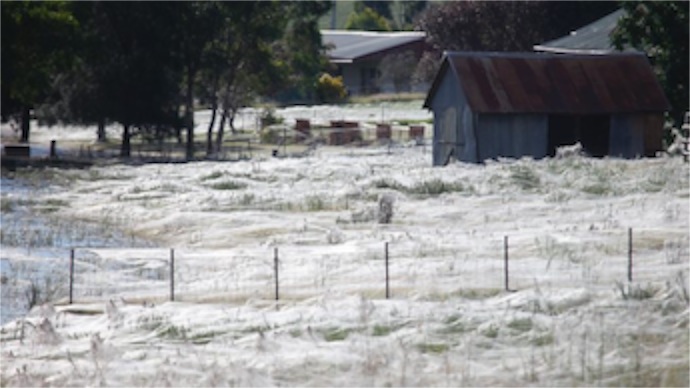 When we have our support networks disrupted, we are much slower to rebuild them. It can take years to establish new relationships and new connections after a major life event changes things for us. And when we build unhealthy networks with destructive relationships, the challenge of creating new networks can be overwhelming.
When we have our support networks disrupted, we are much slower to rebuild them. It can take years to establish new relationships and new connections after a major life event changes things for us. And when we build unhealthy networks with destructive relationships, the challenge of creating new networks can be overwhelming.
Our friend and teacher Ross Snyder spoke of the network of relationships that we carry with us as “ ecology of spirit.” It is a useful term. We are shaped by many different kinds of relationships. Some of them come from reading books and articles and other resources. Some of them come from people in our past who have helped to shape our characters and influence our journeys. Some of them come from people with whom we have entered into covenant and with whom we remain faithful over long periods of time. Some of them come from those who move through our lives, connecting for brief periods of time. Over the years, our ecology becomes larger and more complex. A particular event may have connections with many other points in our ecology without us being consciously aware of how those connections were forged.
Yesterday I had a brief visit with a family in a hospital. An elder was recovering from surgery following a fracture. Other members of the family were sitting with the elder visiting and providing care. After the visit, as I walked through the hospital, I thought of how many times I have met members of this family at the hospital over the years. We have, of course, met in lots of other places as well – in homes, in church, in stores, at various functions around town. But the hospital provides distinct memories of events in our lives. Both of our families have undergone lots of changes over the years. I have participated in multiple funerals of members of their family, and they have seen a few funerals in my family as well.
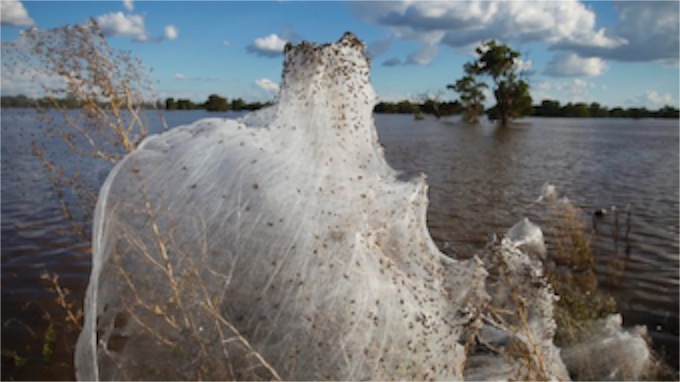 We have grown to treasure our relationships. We enjoy seeing each other and we know how much we can count on each other. And we would never have met were it not for the church.
We have grown to treasure our relationships. We enjoy seeing each other and we know how much we can count on each other. And we would never have met were it not for the church.
Maybe, in some ways, we are like the spiders of Wagga Wagga. Much of our lives are spent dispersed in a thousand different locations with meetings appearing to be by chance. But when the floods come – when trouble arises – we come together. Our connections through the ecology of spirit help us to find our center that is not the institution of the church, but rather the common faith we share.
How many times have I sat around some campfire singing, “We are one in the Spirit, we are one in the Lord?” Too many to count. Nonetheless it is true.

Spiders save energy by not having to run down their prey. However, the process of making the silk requires a large amount of protein. Some spiders recycle their webs by eating and recycling the protein.
Spider webs are strong. The tensile strength of spider silk is greater than the same weight to steel and is much more elastic. Scientists are working to discover ways to use the material in products as diverse as bulletproof vests and artificial tendons to help people recover after injuries.
But I have been thinking of webs in a different way. I have been thinking of them as a metaphor for the networks of relationships we humans develop. A spider begins by stretching a silk line from one point to another. Then another line is stretched to another point. Multiple lines connect many different objects. Then the spider begins to connect the various lines with other lines until the entire network is so connected that the spider can feel vibration from any point in the network. We connect ourselves in networks of relationships. What happens to another person has an effect on us.
Much attention has been given lately to computer-mediated social networking. People invest incredible amounts of time developing relationships through sites such as Facebook and LinkedIn. I have participated in those and other networking tools, but am also aware of how much time they can take. There is a distance that the computer provides that makes such networking a bit less satisfying than in person relationships. Nonetheless, it is a good way to maintain relationships over large distances. We get to see pictures of friends who live in other countries and keep up with their families in ways that were not practical before.
Spiders, it appears, are more adaptable than we humans.

Authorities in Australia say that nothing needs to be done. As the waters recede, the spiders will naturally spread out. The concentrations of spiders make them easy prey for birds and other predators. They will also naturally spread out because there are not enough insects to provide food for the mass concentrations of spiders.

Our friend and teacher Ross Snyder spoke of the network of relationships that we carry with us as “ ecology of spirit.” It is a useful term. We are shaped by many different kinds of relationships. Some of them come from reading books and articles and other resources. Some of them come from people in our past who have helped to shape our characters and influence our journeys. Some of them come from people with whom we have entered into covenant and with whom we remain faithful over long periods of time. Some of them come from those who move through our lives, connecting for brief periods of time. Over the years, our ecology becomes larger and more complex. A particular event may have connections with many other points in our ecology without us being consciously aware of how those connections were forged.
Yesterday I had a brief visit with a family in a hospital. An elder was recovering from surgery following a fracture. Other members of the family were sitting with the elder visiting and providing care. After the visit, as I walked through the hospital, I thought of how many times I have met members of this family at the hospital over the years. We have, of course, met in lots of other places as well – in homes, in church, in stores, at various functions around town. But the hospital provides distinct memories of events in our lives. Both of our families have undergone lots of changes over the years. I have participated in multiple funerals of members of their family, and they have seen a few funerals in my family as well.

Maybe, in some ways, we are like the spiders of Wagga Wagga. Much of our lives are spent dispersed in a thousand different locations with meetings appearing to be by chance. But when the floods come – when trouble arises – we come together. Our connections through the ecology of spirit help us to find our center that is not the institution of the church, but rather the common faith we share.
How many times have I sat around some campfire singing, “We are one in the Spirit, we are one in the Lord?” Too many to count. Nonetheless it is true.
Copyright © 2012 by Ted Huffman. I wrote this. If you want to copy it, please ask for permission. There is a contact me button at the bottom of this page. If you want to share my blog a friend, please direct your friend to my web site.
Pondering our Beginnings
06/03/12 05:50
This week I will be leading a class with the students preparing for the rite of confirmation in our church. The topic for the week is creation. I’ve been having regular conversations with teens about the topic for three decades and the conversations never get old. Last week, when we had a bit of time for free conversation at the end of our class, questions about creation were already bobbing to the surface.
Some of the questions are ones that have been around for decades and more. Most of the youth have heard that the Biblical view of creation is diametrically opposed to the view of science and that there is some kind of forced choice: you have to believe in one or the other. The truth, of course, is more complex than a simple science vs. religion debate. In polarized debates one of the techniques employed is to simplify the position of the opposition. If you only listen to the debates you might come to the conclusion that both sides are inherently simple. Seeking the truth requires a more nuanced and careful approach than is offered in debates focused on producing winners and losers.
For generations our people answered the questions of origin on family terms. We told the stories of our ancestors. Often the stories began with Abram and Sarai departing their family in Haran and setting off in pursuit of the vision that God was revealing to them. There don’t seem to be many stories about what happened before that time. When our people were part of a tribal society, wandering from place to place, the most important question was not what set the universe in motion, but rather what makes our story unique. How are we different from other people? What does it mean to join up with our band and be a part of our journeys?
Later, during the exile, we encountered origin stories of other people. Some of these stories posited theories about the beginnings of the world, as it was then known. Our people reacted negatively to the stories that involved multiple deities. We had become attached to the theology of one and only one God by that time. So we came up with our own stories. By that point in our history, we were already used to multiple points of view, so when the book of Genesis made the transition from a collection of carefully kept oral traditions to a written document, it represented multiple points of view. Scholars can identify at least four camps within the book. Sometimes these are discussed as if there were four distinct authors each offering their own contributions. The reality is likely more complex, but we do know that the book that has become the beginning of our bible is the product of many people who lived in faith and were engaged in deep relationship with God.
These important and long-treasured stories of our people continue to tell the important perspective on which we have staked our faith. There is only one God and the true God is the source of all that is.
What these stories do not do, is to present a scientific perspective. Written more than a couple of millennia before the advent of modern scientific method, they offer no opinion, pro or con, as to the effectiveness of scientific methodologies in discerning truth. The bottom line is that the Bible is not interested in arguing with science. It is interested in proclaiming the truth about God and inviting people into relationship with God.
Some scientists, however, are intent on arguing with the Bible. They have come to the conclusion that God does not exist and like to use scientific method to argue against the existence of God. The problem with their arguments is that invariably they do not know the God of the bible and their arguments succeed in arguing against the existence of quite a different notion of God than the Biblical God.
And they still run into many of us who have no desire to argue about the existence of God in the first place. When you live your life in a deep relationship with God, there is little interest in discussing whether or not God exists. It seems as silly as discussing whether or not the universe exists. Exploring the nature of God and talking about how God works in human history are interesting topics. Getting to know God better is worthy of our time. In that we are like the scientists. They do not invest their time or studies in the question of whether or not the universe exists. Rather they study that which seems to them to be obvious. Things that can be observed are “real” and therefore worthy of study.
It doesn’t take a competent scientist long to discover that there is more to the universe than what can be directly observed. Some things are too distant, others are too tiny, and more than a few things move too quickly to allow visual observation to be the only tool employed by scientists. Even the incredible tools that enhance vision such as telescopes and microscopes don’t provide sufficient assistance for direct observation.
Scientists set up experiments and devise elaborate schemes to make their experiments repeatable so that they can replicate results. And they make mistakes. Mistakes in calculations as well as mistakes in assuming that all variables have been considered can result in misleading results. But mistakes are the stuff of scientific observation. Each mistake that is caught opens the door to additional learning. Each result that surprises gives rise to new experiments to test the result. Each new discovery points to how little is known and how much is left to discover.
So I do not approach my discussions with students as if I somehow possessed knowledge. I have some insights and perhaps a modicum of wisdom honed over the decades. But I do not own the answers. What I can share with the students is the joy of discovery and the delight in asking the big questions.
And I can share my conviction that regardless of the methodology, God is at the heart of all that is. Which means that the conclusions of science are always partial truths waiting for new discovery. Interpretation of observations is always subject to revision. Those who conclude that there is no God have drawn their conclusions prematurely without having considered all of the evidence.
The story of our people and our relationship with God may have been going on for thousands of years, but the God we serve is eternal. From God’s point of view, we are just beginning. These young people, which whom I am privileged to work, will discover and understand more than I am able to imagine.
When we walk with God, the truth is never behind us. It is always ahead.
Some of the questions are ones that have been around for decades and more. Most of the youth have heard that the Biblical view of creation is diametrically opposed to the view of science and that there is some kind of forced choice: you have to believe in one or the other. The truth, of course, is more complex than a simple science vs. religion debate. In polarized debates one of the techniques employed is to simplify the position of the opposition. If you only listen to the debates you might come to the conclusion that both sides are inherently simple. Seeking the truth requires a more nuanced and careful approach than is offered in debates focused on producing winners and losers.
For generations our people answered the questions of origin on family terms. We told the stories of our ancestors. Often the stories began with Abram and Sarai departing their family in Haran and setting off in pursuit of the vision that God was revealing to them. There don’t seem to be many stories about what happened before that time. When our people were part of a tribal society, wandering from place to place, the most important question was not what set the universe in motion, but rather what makes our story unique. How are we different from other people? What does it mean to join up with our band and be a part of our journeys?
Later, during the exile, we encountered origin stories of other people. Some of these stories posited theories about the beginnings of the world, as it was then known. Our people reacted negatively to the stories that involved multiple deities. We had become attached to the theology of one and only one God by that time. So we came up with our own stories. By that point in our history, we were already used to multiple points of view, so when the book of Genesis made the transition from a collection of carefully kept oral traditions to a written document, it represented multiple points of view. Scholars can identify at least four camps within the book. Sometimes these are discussed as if there were four distinct authors each offering their own contributions. The reality is likely more complex, but we do know that the book that has become the beginning of our bible is the product of many people who lived in faith and were engaged in deep relationship with God.
These important and long-treasured stories of our people continue to tell the important perspective on which we have staked our faith. There is only one God and the true God is the source of all that is.
What these stories do not do, is to present a scientific perspective. Written more than a couple of millennia before the advent of modern scientific method, they offer no opinion, pro or con, as to the effectiveness of scientific methodologies in discerning truth. The bottom line is that the Bible is not interested in arguing with science. It is interested in proclaiming the truth about God and inviting people into relationship with God.
Some scientists, however, are intent on arguing with the Bible. They have come to the conclusion that God does not exist and like to use scientific method to argue against the existence of God. The problem with their arguments is that invariably they do not know the God of the bible and their arguments succeed in arguing against the existence of quite a different notion of God than the Biblical God.
And they still run into many of us who have no desire to argue about the existence of God in the first place. When you live your life in a deep relationship with God, there is little interest in discussing whether or not God exists. It seems as silly as discussing whether or not the universe exists. Exploring the nature of God and talking about how God works in human history are interesting topics. Getting to know God better is worthy of our time. In that we are like the scientists. They do not invest their time or studies in the question of whether or not the universe exists. Rather they study that which seems to them to be obvious. Things that can be observed are “real” and therefore worthy of study.
It doesn’t take a competent scientist long to discover that there is more to the universe than what can be directly observed. Some things are too distant, others are too tiny, and more than a few things move too quickly to allow visual observation to be the only tool employed by scientists. Even the incredible tools that enhance vision such as telescopes and microscopes don’t provide sufficient assistance for direct observation.
Scientists set up experiments and devise elaborate schemes to make their experiments repeatable so that they can replicate results. And they make mistakes. Mistakes in calculations as well as mistakes in assuming that all variables have been considered can result in misleading results. But mistakes are the stuff of scientific observation. Each mistake that is caught opens the door to additional learning. Each result that surprises gives rise to new experiments to test the result. Each new discovery points to how little is known and how much is left to discover.
So I do not approach my discussions with students as if I somehow possessed knowledge. I have some insights and perhaps a modicum of wisdom honed over the decades. But I do not own the answers. What I can share with the students is the joy of discovery and the delight in asking the big questions.
And I can share my conviction that regardless of the methodology, God is at the heart of all that is. Which means that the conclusions of science are always partial truths waiting for new discovery. Interpretation of observations is always subject to revision. Those who conclude that there is no God have drawn their conclusions prematurely without having considered all of the evidence.
The story of our people and our relationship with God may have been going on for thousands of years, but the God we serve is eternal. From God’s point of view, we are just beginning. These young people, which whom I am privileged to work, will discover and understand more than I am able to imagine.
When we walk with God, the truth is never behind us. It is always ahead.
Copyright © 2012 by Ted Huffman. I wrote this. If you want to copy it, please ask for permission. There is a contact me button at the bottom of this page. If you want to share my blog a friend, please direct your friend to my web site.
Are our cats deprived?
05/03/12 05:29
We share our home with two cats. They are frequently the subjects of my photography. In the early days of this blog, the cats were mentioned so often that I decided that I had already written everything I know about cats and that further blogs focusing on the pets would become boring for readers. The cats didn’t stop doing things that I think are cute.
 The cats were a natural outgrowth of being parents. Our daughter was the one who wanted to have cats and I didn’t resist. We had had pets when we were children and pets offer a lot of education for growing children. The jobs of pet care are good lessons for children. They need to be fed even when the child is tired or not feeling well. They need attention even when the child is distracted. And pets offer unconditional love. When things at school aren’t going well, the pet still comes to cuddle. When friends are being fickle, pets are not.
The cats were a natural outgrowth of being parents. Our daughter was the one who wanted to have cats and I didn’t resist. We had had pets when we were children and pets offer a lot of education for growing children. The jobs of pet care are good lessons for children. They need to be fed even when the child is tired or not feeling well. They need attention even when the child is distracted. And pets offer unconditional love. When things at school aren’t going well, the pet still comes to cuddle. When friends are being fickle, pets are not.
Our first experience with a cat didn’t go as expected. The kitten was adopted from a farm and on its first visit to the vet we learned that it had feline leukemia. We opted to provide comfort care and to keep the cat in our home. It was a lesson in mortality for our children. The cat was able to drink and we were able to control pain right up to the end, so we watched as the small creature lost strength and finally died in its sleep. A simple backyard burial and many conversations about grief and loss followed. We waited before adopting another cat.
Over the years, we lost two cats to encounters with cars on the busy streets in our neighborhood. Trips to the shelter resulted in new cats in our home. When our daughter moved out on her own, she mostly lived in apartments that did not allow pets. For one short period of time she had one of the cats in her apartment and we had the other at home, but another move ended up with the cat back at our house. Now she and her husband are in their own home with their own puppy and we are living our lives with the cats here.
I didn’t exactly plan for life to be this way, but I am not complaining. We’ve lived with the cats long enough that we’ve become quite attached to them. The routines of their care don’t take too much of our time and the cats enjoy taking lots of naps and so aren’t bothered by the fact that we work outside of the home every day. Cats don’t have to be walked every day, so the work load is a bit lighter than a dog.
And they are photogenic.
According to the American Pet Association, the spending on pets in the United States topped $50 billion in 2011. That is a lot of money. Food and veterinary costs accounted for about 65% of the figure, but the category of “pet services” grew faster than any other, totaling $3.79 billion. That category includes grooming, boarding, pet hotels, and pet-sitting.
We contributed to that figure in 2011. It was a sabbatical year for us. We were gone for three months during which our cats lived in our home. I think we paid neighbor kids a total of about $60 to come and check our cats’ food, water and litter boxes. That was an unusually expensive year for us in the pet care department. Most years $20 will cover the costs.
Our cats have never gone to a pet hotel. Given their behavior at the veterinary clinic, I don’t think they would be seen as star guests. They don’t get paid grooming. We buy a new brush from time to time, but that is it. They also haven’t ever had the benefit of pet dental services. Our vet does recommend tooth cleaning for the cats, but so far we have resisted. They get an annual visit to the vet. They get high-quality food – the brand recommended by the vet. They get fresh cat litter – though it is beyond me why Bentonite, mined and dried in Wyoming, has to be put on a train and shipped to St. Louis where it is bagged then put on a truck and shipped to Rapid City where I buy it. Our cat litter gets to travel a lot more than our cats do.
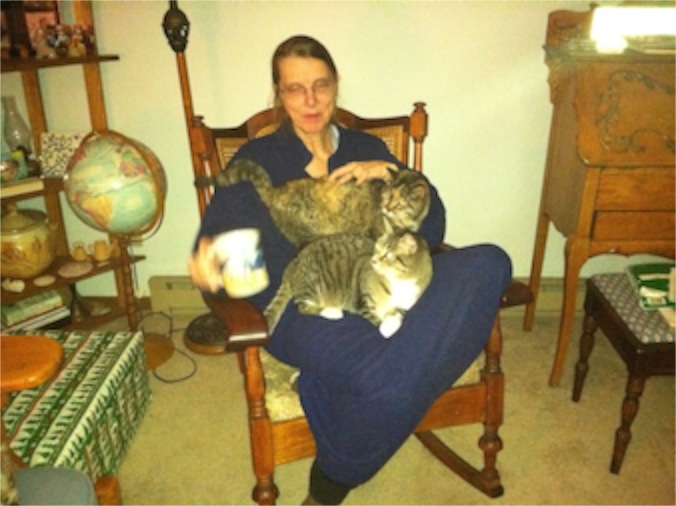 Our cats appear to be healthy. Peekaboo, the elder, is two or three years older than the average life for a domestic shorthair. She is thin, but otherwise healthy. She doesn’t appear to have any pain in her joints and her teeth appear to be just fine. Coconut, the younger of the cats, is no spring chicken, either. She must be ten or eleven years old. Other than the fact that her claws are too long and I can’t bring myself to trim them, so she has to go to the vet for that service, she doesn’t get any fancy grooming, either.
Our cats appear to be healthy. Peekaboo, the elder, is two or three years older than the average life for a domestic shorthair. She is thin, but otherwise healthy. She doesn’t appear to have any pain in her joints and her teeth appear to be just fine. Coconut, the younger of the cats, is no spring chicken, either. She must be ten or eleven years old. Other than the fact that her claws are too long and I can’t bring myself to trim them, so she has to go to the vet for that service, she doesn’t get any fancy grooming, either.
Most cats are naturally good groomers and since both of ours are shorthairs they really don’t require more than brushing.
Here’s another thing our cats don’t have: insurance. Yes, they are among the millions of uninsured pets. That doesn’t stop pet insurance from being a growing industry. Pet insurance premiums were estimated to be $450 million in 2011, and the industry is growing.
Our cats also don’t have any bionic toys. Heck, they don’t even have a mechanical mouse. I have, however, neglected to repair the torn seal on the bottom of one of our garage doors. As a result a mouse can slip under the door. Since the cats’ bed is in the garage and they spend quite a bit of time out there, they find the occasional mouse to be a great entertainment. Both cats believe that they would be fearless hunters if we allowed them to go outside. The problem is not their fear, but my fear of cars on the street. At any rate, they are efficient in dispatching the occasional mouse that is attracted by the presence of cat food in our garage. And they seem to be entertained by the exercise. I haven’t yet noticed a dramatic change in the number of mice in the grassland and forest near our home.
I don’t know if our cats feel any sense of disenfranchisement due to the fact that our spending on them is much lower than average. They both seem to have quite a few psychological quirks. Peekaboo has a persistent paranoia, especially when we have guests in our home. She can hide for hours at a time. Coconut is definitely hyperactive. She may even have attention deficit disorder. We’ll never have firm diagnoses. Both cats belong to an owner who is too cheap for pet psychiatrists.
Never fear, the economy is strong. Pet psychology is another growing field in the U.S. Spending on psychiatric medications such as Prozac and Zoloft for pets was up 35 percent in 2011. It may be the fastest growing segment of the $7 billion pet pharmaceutical industry.
I don’t think the cats know that they are deprived.

Our first experience with a cat didn’t go as expected. The kitten was adopted from a farm and on its first visit to the vet we learned that it had feline leukemia. We opted to provide comfort care and to keep the cat in our home. It was a lesson in mortality for our children. The cat was able to drink and we were able to control pain right up to the end, so we watched as the small creature lost strength and finally died in its sleep. A simple backyard burial and many conversations about grief and loss followed. We waited before adopting another cat.
Over the years, we lost two cats to encounters with cars on the busy streets in our neighborhood. Trips to the shelter resulted in new cats in our home. When our daughter moved out on her own, she mostly lived in apartments that did not allow pets. For one short period of time she had one of the cats in her apartment and we had the other at home, but another move ended up with the cat back at our house. Now she and her husband are in their own home with their own puppy and we are living our lives with the cats here.
I didn’t exactly plan for life to be this way, but I am not complaining. We’ve lived with the cats long enough that we’ve become quite attached to them. The routines of their care don’t take too much of our time and the cats enjoy taking lots of naps and so aren’t bothered by the fact that we work outside of the home every day. Cats don’t have to be walked every day, so the work load is a bit lighter than a dog.
And they are photogenic.
According to the American Pet Association, the spending on pets in the United States topped $50 billion in 2011. That is a lot of money. Food and veterinary costs accounted for about 65% of the figure, but the category of “pet services” grew faster than any other, totaling $3.79 billion. That category includes grooming, boarding, pet hotels, and pet-sitting.
We contributed to that figure in 2011. It was a sabbatical year for us. We were gone for three months during which our cats lived in our home. I think we paid neighbor kids a total of about $60 to come and check our cats’ food, water and litter boxes. That was an unusually expensive year for us in the pet care department. Most years $20 will cover the costs.
Our cats have never gone to a pet hotel. Given their behavior at the veterinary clinic, I don’t think they would be seen as star guests. They don’t get paid grooming. We buy a new brush from time to time, but that is it. They also haven’t ever had the benefit of pet dental services. Our vet does recommend tooth cleaning for the cats, but so far we have resisted. They get an annual visit to the vet. They get high-quality food – the brand recommended by the vet. They get fresh cat litter – though it is beyond me why Bentonite, mined and dried in Wyoming, has to be put on a train and shipped to St. Louis where it is bagged then put on a truck and shipped to Rapid City where I buy it. Our cat litter gets to travel a lot more than our cats do.

Most cats are naturally good groomers and since both of ours are shorthairs they really don’t require more than brushing.
Here’s another thing our cats don’t have: insurance. Yes, they are among the millions of uninsured pets. That doesn’t stop pet insurance from being a growing industry. Pet insurance premiums were estimated to be $450 million in 2011, and the industry is growing.
Our cats also don’t have any bionic toys. Heck, they don’t even have a mechanical mouse. I have, however, neglected to repair the torn seal on the bottom of one of our garage doors. As a result a mouse can slip under the door. Since the cats’ bed is in the garage and they spend quite a bit of time out there, they find the occasional mouse to be a great entertainment. Both cats believe that they would be fearless hunters if we allowed them to go outside. The problem is not their fear, but my fear of cars on the street. At any rate, they are efficient in dispatching the occasional mouse that is attracted by the presence of cat food in our garage. And they seem to be entertained by the exercise. I haven’t yet noticed a dramatic change in the number of mice in the grassland and forest near our home.
I don’t know if our cats feel any sense of disenfranchisement due to the fact that our spending on them is much lower than average. They both seem to have quite a few psychological quirks. Peekaboo has a persistent paranoia, especially when we have guests in our home. She can hide for hours at a time. Coconut is definitely hyperactive. She may even have attention deficit disorder. We’ll never have firm diagnoses. Both cats belong to an owner who is too cheap for pet psychiatrists.
Never fear, the economy is strong. Pet psychology is another growing field in the U.S. Spending on psychiatric medications such as Prozac and Zoloft for pets was up 35 percent in 2011. It may be the fastest growing segment of the $7 billion pet pharmaceutical industry.
I don’t think the cats know that they are deprived.
Copyright © 2012 by Ted Huffman. I wrote this. If you want to copy it, please ask for permission. There is a contact me button at the bottom of this page. If you want to share my blog a friend, please direct your friend to my web site.
I read the book
04/03/12 05:23
I am a reader. I love books and there is never a time when I don’t have a couple of books in progress. The love of books is consistent with my calling, as reading is a big part of preparing sermons and thinking theologically. I am just a couple of years too old to have been raised with the Dr. Seuss book club. My parents subscribed my younger brother. Of course I read all of the books he got. The club had regular offerings by Dr. Seuss as well as basic readers by other authors. In those days, a subscription to the book club brought two books in the first mailing: “The Cat in the Hat” and “The Cat in the Hat Comes Back.” There were new books every month. We read them out loud to our younger brothers.
 “The 500 Hats of Bartholomew Cubbins” was a favorite, so we were ready when “Bartholomew and the Oobleck” came out. We read “Horton Hatches the Egg,” which gave us plenty of anticipation for “Horton Hears a Who.” “Scrambled Eggs Super” was OK, but “Green Eggs and Ham” was spectacular.
“The 500 Hats of Bartholomew Cubbins” was a favorite, so we were ready when “Bartholomew and the Oobleck” came out. We read “Horton Hatches the Egg,” which gave us plenty of anticipation for “Horton Hears a Who.” “Scrambled Eggs Super” was OK, but “Green Eggs and Ham” was spectacular.
I was still reading Dr. Seuss books when our children came along. And we bought the books for them to read. I had “One Fish, Two Fish, Red Fish, Blue Fish” memorized before our children did. I never knew if they had learned to read the words or if they simply memorized the story word for word. And how can you resist reading “Hop on Pop” when you have a child who loves to sit and bounce on your belly?
 “Mr. Brown Can Moo! Can You?” was designed to teach children about onomatopoeia, though one never knows for sure why children need to learn onomatopoeia before they are old enough to learn the word which is as much fun as the concept. I could get the “moo” and even the frying pan’s “sizzle,” but is a hippo’s “grum” a sound in he everyday world of a child?
“Mr. Brown Can Moo! Can You?” was designed to teach children about onomatopoeia, though one never knows for sure why children need to learn onomatopoeia before they are old enough to learn the word which is as much fun as the concept. I could get the “moo” and even the frying pan’s “sizzle,” but is a hippo’s “grum” a sound in he everyday world of a child?
How often can one read “How the Grinch Stole Christmas!” and keep laughing? I don’t know. I still enjoy reading the book out loud when I have an audience.
We enjoyed the books tremendously. Most of the memorable titles were written by Theodore Geisel under the pen name based on his middle name, Dr. Seuss. After all, he published 46 titles in his lifetime. The one title from the book club that was not written by Dr. Seuss but will always remain a classic in our house is “Go Dog Go” by P.D. Eastman. Now that is a book that has everything: adventure, a touch of romance with glorious hats, cars, scooters, skis, chase scenes and a surprise ending! Wow! They don’t write books much better than that one.
 Dr. Seuss, during his lifetime, resisted licensing his characters. These days, licensing is part of marketing books, but back then, he could earn a living by being a writer. The books sold well and the book club was an innovative way to get more books out. He didn’t need a line of toys or lunch boxes or other objects. Even after his death, his family was slow to go into the licensing business. I have preferred it that way.
Dr. Seuss, during his lifetime, resisted licensing his characters. These days, licensing is part of marketing books, but back then, he could earn a living by being a writer. The books sold well and the book club was an innovative way to get more books out. He didn’t need a line of toys or lunch boxes or other objects. Even after his death, his family was slow to go into the licensing business. I have preferred it that way.
So I wasn’t eager when they started making the books into movies. I did go to “How the Grinch Stole Christmas.” It had been a made for TV movie when our children were younger and returning to the theatre to see the Grinch with Jim Carey’s voice and his loyal dog, Max, seemed like a good adventure with our then teenaged children.
But I didn’t go to “The Cat in the Hat” or “Horton Hears a Who.” I’d read the books and I preferred the images and voices in my imagination to whatever the big screen had to offer. I doubt if I will go to “The Lorax” which is showing in theatres now.
I am amused at the inflamed rhetoric that has arisen over the movie. The book was one of Dr. Seuss’s later creations and by the early 1970’s the environmental movement was very popular. The images of the earth from space that had come from the Apollo program combined with shortages of some natural resources to create an awareness of our relationship with this planet. Congress was passing environmental legislation, Earth day was begun, and there was a lot of interest in learning to reduce consumption and adjusting our lifestyles. I suppose that the times influenced Dr. Seuss. He may have injected some of his own opinions and ideas into the story. Certainly he was trying to teach values such as respect and care for other creatures. I’m sure the hopeful ending was on purpose.
 But the furor over the movie is amusing to me. Yes, the book is a bit dark and contains an obvious environmental warning. But is it truly anti-capitalist? Did Dr. Seuss have some sinister objective of bringing down the financial system of our country? I think not. It seems more likely that it was a bit of a personal crusade. Dr. Seuss had a studio in Sand Diego overlooking the Pacific with lots of eucalyptus trees. He was opposed to the cutting of the trees for further development. Writing a children’s book was his way of resisting the developers. It worked. The trees were preserved.
But the furor over the movie is amusing to me. Yes, the book is a bit dark and contains an obvious environmental warning. But is it truly anti-capitalist? Did Dr. Seuss have some sinister objective of bringing down the financial system of our country? I think not. It seems more likely that it was a bit of a personal crusade. Dr. Seuss had a studio in Sand Diego overlooking the Pacific with lots of eucalyptus trees. He was opposed to the cutting of the trees for further development. Writing a children’s book was his way of resisting the developers. It worked. The trees were preserved.
I doubt that he set out to develop anti-business, anti-logging, environmental propaganda and to surreptitiously undermine society by indoctrinating children against big business.
The furor around the film is, for me, another reason to stay home and read a book. I did watch the trailer and I did notice that the online version was followed by an advertisement for a SUV. I doubt if the movie producers are armed for a full-out attack on big business.
Here is the difference. Dr. Seuss, in his lifetime, wrote books with the understanding and intention that parents would read his books with their children. He knew that parents have a much stronger influence on the values and behaviors of their children than do outside sources. He understood that nothing, not even good books, could substitute for good parenting. At the most, he used his books to bring up subjects for conversations within families. He never thought that he had the power to shape or indoctrinate children.
Sadly, movies, especially when they are burned onto DVD’s and brought into homes, are being substituted for parenting in today’s culture. A big screen TV is a poor substitute for a human babysitter, but it is employed far too often.
If people are concerned about the politics of a movie, they would do well to spend less time complaining and more time reading stories to children.
I know I have a stack of books waiting for the next visit from our grandson.

I was still reading Dr. Seuss books when our children came along. And we bought the books for them to read. I had “One Fish, Two Fish, Red Fish, Blue Fish” memorized before our children did. I never knew if they had learned to read the words or if they simply memorized the story word for word. And how can you resist reading “Hop on Pop” when you have a child who loves to sit and bounce on your belly?

How often can one read “How the Grinch Stole Christmas!” and keep laughing? I don’t know. I still enjoy reading the book out loud when I have an audience.
We enjoyed the books tremendously. Most of the memorable titles were written by Theodore Geisel under the pen name based on his middle name, Dr. Seuss. After all, he published 46 titles in his lifetime. The one title from the book club that was not written by Dr. Seuss but will always remain a classic in our house is “Go Dog Go” by P.D. Eastman. Now that is a book that has everything: adventure, a touch of romance with glorious hats, cars, scooters, skis, chase scenes and a surprise ending! Wow! They don’t write books much better than that one.

So I wasn’t eager when they started making the books into movies. I did go to “How the Grinch Stole Christmas.” It had been a made for TV movie when our children were younger and returning to the theatre to see the Grinch with Jim Carey’s voice and his loyal dog, Max, seemed like a good adventure with our then teenaged children.
But I didn’t go to “The Cat in the Hat” or “Horton Hears a Who.” I’d read the books and I preferred the images and voices in my imagination to whatever the big screen had to offer. I doubt if I will go to “The Lorax” which is showing in theatres now.
I am amused at the inflamed rhetoric that has arisen over the movie. The book was one of Dr. Seuss’s later creations and by the early 1970’s the environmental movement was very popular. The images of the earth from space that had come from the Apollo program combined with shortages of some natural resources to create an awareness of our relationship with this planet. Congress was passing environmental legislation, Earth day was begun, and there was a lot of interest in learning to reduce consumption and adjusting our lifestyles. I suppose that the times influenced Dr. Seuss. He may have injected some of his own opinions and ideas into the story. Certainly he was trying to teach values such as respect and care for other creatures. I’m sure the hopeful ending was on purpose.

I doubt that he set out to develop anti-business, anti-logging, environmental propaganda and to surreptitiously undermine society by indoctrinating children against big business.
The furor around the film is, for me, another reason to stay home and read a book. I did watch the trailer and I did notice that the online version was followed by an advertisement for a SUV. I doubt if the movie producers are armed for a full-out attack on big business.
Here is the difference. Dr. Seuss, in his lifetime, wrote books with the understanding and intention that parents would read his books with their children. He knew that parents have a much stronger influence on the values and behaviors of their children than do outside sources. He understood that nothing, not even good books, could substitute for good parenting. At the most, he used his books to bring up subjects for conversations within families. He never thought that he had the power to shape or indoctrinate children.
Sadly, movies, especially when they are burned onto DVD’s and brought into homes, are being substituted for parenting in today’s culture. A big screen TV is a poor substitute for a human babysitter, but it is employed far too often.
If people are concerned about the politics of a movie, they would do well to spend less time complaining and more time reading stories to children.
I know I have a stack of books waiting for the next visit from our grandson.
Copyright © 2012 by Ted Huffman. I wrote this. If you want to copy it, please ask for permission. There is a contact me button at the bottom of this page. If you want to share my blog a friend, please direct your friend to my web site.
Where there's smoke
03/03/12 05:34
I think that I probably have a slightly elevated fear of fire. I guess that most people have some fear of fire and being burned, so it is possible that I am not really different from others, but I know that I have more fear now than I did earlier in my life. In 2001, I suffered burns on my face, hands, arms and chest. They were not severe or life threatening. The burns were mostly 1st and 2nd degree and I have healed well. I did not require any skin grafts and did not suffer infections. All in all the experience wasn’t any near as terrible as some people have suffered. But it changed the way I think and behave around fire. I don’t use liquid charcoal lighter any more, preferring to use a charcoal chimney and newspaper for my barbecue. I am very careful around fuels and keep gas and kerosene cans in a shed that is not attached to our home.
 I notice when a fire occurs in our town. I check out the reports from news agencies to get as much information as I can about the fire. One of the spokespersons for our local fire department is a friend of mine and I have been known to pepper him with questions about fires.
I notice when a fire occurs in our town. I check out the reports from news agencies to get as much information as I can about the fire. One of the spokespersons for our local fire department is a friend of mine and I have been known to pepper him with questions about fires.
While I know first hand that a fire is no laughing matter, there is a dark side to my sense of humor that notices irony and causes me to occasionally laugh at a joke about fire or burning.
So I noticed, yesterday, when driving north on Campbell Street here in Rapid City, a strange posting on the letter board at a local car dealership. A few blocks before I reached the intersection where the car dealership is located, I drove by the former location of the same dealership. Billion Kia in Rapid City had to relocate after a fire on November 3 destroyed their former building. It was a dramatic fire that got lots of attention from news media. Fortunately no one was injured, but the building was a total loss. I don’t know the results of the full investigation of the fire, but there were reports that the fire started in a waste oil tank that was located near the area where employees stepped out of the building to smoke cigarettes.
 Demolition has not yet begun at the old building. They have erected a chain link fence around it, but no other work has been done at the site even though it has been four months since the fire. I suppose that there must be some issues involving insurance yet to be resolved before clean up can begin. As I drove by yesterday, I wondered about how long the charred hull of a building with a collapsed roof would remain before work begins. It is a valuable piece of commercial property and the owner is not realizing any income from it the way it now stands.
Demolition has not yet begun at the old building. They have erected a chain link fence around it, but no other work has been done at the site even though it has been four months since the fire. I suppose that there must be some issues involving insurance yet to be resolved before clean up can begin. As I drove by yesterday, I wondered about how long the charred hull of a building with a collapsed roof would remain before work begins. It is a valuable piece of commercial property and the owner is not realizing any income from it the way it now stands.
The dealership is now located in a facility with bigger and newer buildings on a very visible intersection. The increased traffic at the new intersection, which has a car dealership on every corner, means that they are unlikely to go back to the old location.
At their new location they have a sign with changeable letters. It isn’t as fancy as the big electronic billboard at the Nissan dealership across the street, but the letters are large enough to catch my attention and I had plenty of time to read them as I was stopped in the intersection. In fact, I had enough time to take a picture with my phone before the light changed.
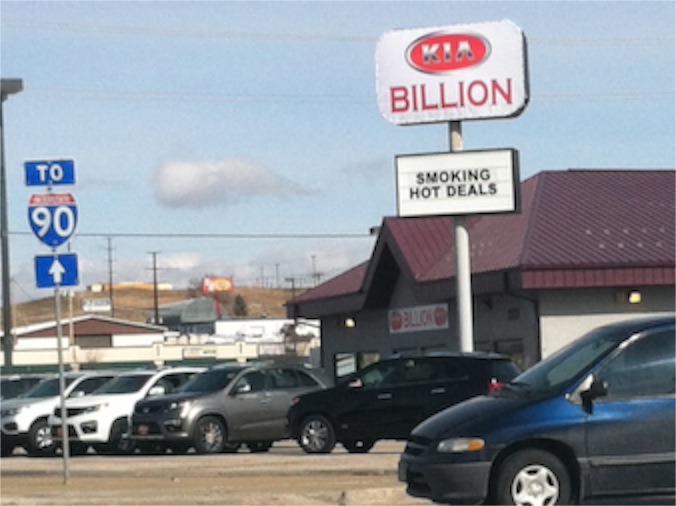 I wonder if the dealership caught the irony in their sign. In fact, the way my mind works, I thought that it was possible, or even likely, that they chose the words on purpose to get the attention of the people who remember the fire. It could even be their way of commemorating the first quarter of doing business in the new location.
I wonder if the dealership caught the irony in their sign. In fact, the way my mind works, I thought that it was possible, or even likely, that they chose the words on purpose to get the attention of the people who remember the fire. It could even be their way of commemorating the first quarter of doing business in the new location.
Then again, they might have just taken a stock marketing phrase and put it up on the letter board without thinking about it. I guess I could have stopped and asked them. Quite frankly, however, the sign didn’t make me want to stop. It got my attention, but didn’t attract me. I have a thing about fires, you know.
They may have smoking hot deals, but I feel no desire to be a part of one given the dealership’s experience with scary fires. I’m not even sure that it is good advertising to bring up the possibility that one could get burned in a car deal.
Friends tell me that I am overly critical of the signs that are posted around town. I catch spelling and grammar mistakes and have been known to complain about the proliferation of electronic billboards. If it is illegal for a driver to watch videos in the car while driving, what makes us think it is less dangerous for drivers to watch videos on signboards outside of the car? If those signs aren’t distracting, they aren’t doing their job. The intent of the advertisers is to get people to think about something other than driving. We have enough distracted drivers without adding more distractions.
Signs and billboards are a topic of frequent debate in our city. Last year Rapid City voters approved restrictions on the huge video billboards. Recently the state legislature passed a bill that may have overturned those regulations. You can find people who will heatedly argue for or against various restrictions on billboards. And there is no shortage of billboards in Rapid City. Four states, Alaska, Hawaii, Maine and Vermont have bans on billboards. All are known for their scenic beauty. None have suffered loss of tourist traffic because of their bans. I wouldn’t mind having South Dakota join those states. I think that we have an abundance of natural beauty that is in no way enhanced by the visual litter of excessive advertising.
But then, there are plenty of people who consider my views to be extreme. I have a friend whose family is in the outdoor advertising business who just rolls her eyes when I get on the topic.
I do have to concede that the signs are effective. They get my attention. Why just yesterday I took a picture with my cell phone while waiting for the light to change at one of the busiest intersections in town. That can’t be safe.
Fortunately I avoided an accident yesterday.
I didn’t get burned, either.

While I know first hand that a fire is no laughing matter, there is a dark side to my sense of humor that notices irony and causes me to occasionally laugh at a joke about fire or burning.
So I noticed, yesterday, when driving north on Campbell Street here in Rapid City, a strange posting on the letter board at a local car dealership. A few blocks before I reached the intersection where the car dealership is located, I drove by the former location of the same dealership. Billion Kia in Rapid City had to relocate after a fire on November 3 destroyed their former building. It was a dramatic fire that got lots of attention from news media. Fortunately no one was injured, but the building was a total loss. I don’t know the results of the full investigation of the fire, but there were reports that the fire started in a waste oil tank that was located near the area where employees stepped out of the building to smoke cigarettes.

The dealership is now located in a facility with bigger and newer buildings on a very visible intersection. The increased traffic at the new intersection, which has a car dealership on every corner, means that they are unlikely to go back to the old location.
At their new location they have a sign with changeable letters. It isn’t as fancy as the big electronic billboard at the Nissan dealership across the street, but the letters are large enough to catch my attention and I had plenty of time to read them as I was stopped in the intersection. In fact, I had enough time to take a picture with my phone before the light changed.

Then again, they might have just taken a stock marketing phrase and put it up on the letter board without thinking about it. I guess I could have stopped and asked them. Quite frankly, however, the sign didn’t make me want to stop. It got my attention, but didn’t attract me. I have a thing about fires, you know.
They may have smoking hot deals, but I feel no desire to be a part of one given the dealership’s experience with scary fires. I’m not even sure that it is good advertising to bring up the possibility that one could get burned in a car deal.
Friends tell me that I am overly critical of the signs that are posted around town. I catch spelling and grammar mistakes and have been known to complain about the proliferation of electronic billboards. If it is illegal for a driver to watch videos in the car while driving, what makes us think it is less dangerous for drivers to watch videos on signboards outside of the car? If those signs aren’t distracting, they aren’t doing their job. The intent of the advertisers is to get people to think about something other than driving. We have enough distracted drivers without adding more distractions.
Signs and billboards are a topic of frequent debate in our city. Last year Rapid City voters approved restrictions on the huge video billboards. Recently the state legislature passed a bill that may have overturned those regulations. You can find people who will heatedly argue for or against various restrictions on billboards. And there is no shortage of billboards in Rapid City. Four states, Alaska, Hawaii, Maine and Vermont have bans on billboards. All are known for their scenic beauty. None have suffered loss of tourist traffic because of their bans. I wouldn’t mind having South Dakota join those states. I think that we have an abundance of natural beauty that is in no way enhanced by the visual litter of excessive advertising.
But then, there are plenty of people who consider my views to be extreme. I have a friend whose family is in the outdoor advertising business who just rolls her eyes when I get on the topic.
I do have to concede that the signs are effective. They get my attention. Why just yesterday I took a picture with my cell phone while waiting for the light to change at one of the busiest intersections in town. That can’t be safe.
Fortunately I avoided an accident yesterday.
I didn’t get burned, either.
Copyright © 2012 by Ted Huffman. I wrote this. If you want to copy it, please ask for permission. There is a contact me button at the bottom of this page. If you want to share my blog a friend, please direct your friend to my web site.
Rebuilding a Cathedral
02/03/12 04:43
I have never been to New Zealand. So any comments I have to make about Christchurch Cathedral are made from afar. If I had gone to New Zealand, however, you can be sure that the cathedral would have been on my list of places to visit. I have visited churches and cathedrals all over the world. I am well aware that there are sacred places that are not the product of human construction, but there are some human constructions that are so impressive that they point beyond the people who built them. I have no doubt that the cathedral was one of those places.
But the decision came down yesterday (or today, I can never get the days right when peering across the International Time Line): The Cathedral will be taken down and replaced by a new structure. The venerable old church has simply suffered too much structural damage from earthquakes to make reconstruction practical.
 It has seen a few earthquakes. Within a month of the cathedral’s consecration in 1861, a quake dislodged a stone from the finial cap, just below the cross. Seven years later the 1888 North Canterbury earthquake caused a large section of the spire to fall. The spire was replaced. Earthquakes caused additional damage in 1901, 1922 and 2010. The February 2011 earthquake was 6.3 in magnitude and left the cathedral damaged and surrounding buildings in ruins. The spire was completely destroyed. Part of the roof collapsed. Further significant damage occurred in quakes in June and December of 2011.
It has seen a few earthquakes. Within a month of the cathedral’s consecration in 1861, a quake dislodged a stone from the finial cap, just below the cross. Seven years later the 1888 North Canterbury earthquake caused a large section of the spire to fall. The spire was replaced. Earthquakes caused additional damage in 1901, 1922 and 2010. The February 2011 earthquake was 6.3 in magnitude and left the cathedral damaged and surrounding buildings in ruins. The spire was completely destroyed. Part of the roof collapsed. Further significant damage occurred in quakes in June and December of 2011.
The only way to repair the building is to tear down, or deconstruct most of the damaged structure. An emotional battle is being waged over whether the replacement should be a replica or have a new look. Anglican Bishop Victoria Matthews said a new cathedral with a different design would be built in its place. She did announce that no bulldozers or wrecking balls would be employed as the cathedral is deconstructed “with the utmost care and respect.”
 It is not easy to build a cathedral. It took Bishop Henry John Chitty Harper two years to get the diocese to approve the construction of a cathedral. It was another six years before the cornerstone was laid. From the beginning there were problems with escalating costs and shortfalls in fund raising. The construction proved to be more difficult than anticipated. For eight years between 1867 and 1873 little work was accomplished. The novelist Anthony Trollope declared that the cathedral was a huge failure built on “vain foundations” when he visited in 1872. It took until 1881, a quarter of a century after the cathedral project was envisioned, before the nave and tower were consecrated. Another 15 years of construction were required after that before the transepts, chancel and sanctuary were finished.
It is not easy to build a cathedral. It took Bishop Henry John Chitty Harper two years to get the diocese to approve the construction of a cathedral. It was another six years before the cornerstone was laid. From the beginning there were problems with escalating costs and shortfalls in fund raising. The construction proved to be more difficult than anticipated. For eight years between 1867 and 1873 little work was accomplished. The novelist Anthony Trollope declared that the cathedral was a huge failure built on “vain foundations” when he visited in 1872. It took until 1881, a quarter of a century after the cathedral project was envisioned, before the nave and tower were consecrated. Another 15 years of construction were required after that before the transepts, chancel and sanctuary were finished.
No one knows how long it will take to build a new cathedral. No one yet knows what the new structure will look like. What is known is that the existing building is unsafe. It cannot be used for worship or for other work of the church. There are hundreds of heritage items that need to be salvaged in the process of deconstruction. Many stained glass windows are still intact. Memorial stones that were built into the cathedral need to be salvaged. Even if the building is taken down, the commitment of the church to preserving memory will not be lost.
News reports from New Zealand tell of a public debate over the structure. Conservationists are asking the church to reconsider the decision to deconstruct the building. They want officials to look at other options for reinforcing and keeping the existing structure. It seems as if everyone has an opinion.
It shouldn’t be surprising that the building engenders strong emotions. I serve a congregation that is relatively small compared to those who worshiped in the cathedral. Our building is just over 50 years old. But I know how strongly people feel about the building. One afternoon I spent over an hour listening to a member of our community who is not a member of our congregation as he talked about his reverence for the architect who designed our building and how important details in the building were. This man made it clear that he would be upset if we were to change the color of the paint on the steel beams that support the sanctuary roof.
Communities develop a sense of ownership for buildings. And sometimes the ones who haven’t belonged or even participated express the deepest sense of shock when decisions are made. The bishop and diocese of the Christchurch cathedral will be criticized whatever decisions they make.

It seems to me that Lent is the appropriate season to consider the future of the cathedral. With a smudge of ashes on our foreheads we all begin this season with a simple declaration that we do not go on forever. We are all mortal. “From dust you have come, to dust you will return.” Worshipers in Christchurch gathered in a park. Mixed in with the ashes of last year’s palms was a bit of dust from the collapse of the cathedral. With tears and solemn prayers they remembered the 185 people who died in the earthquake and aftershocks. The tremor had changed everything for the people. The memory is fresh.
Like our very lives, the works of human hands are temporary. We gain an illusion that we can make things that will last a long time by virtue of the simple fact that there are plenty of buildings that have outlasted a single generation. Previous generations have constructed buildings that have lasted centuries and, in some rare cases, millennia. It gives us an illusion of permanence. From the perspective of the eternal, human efforts all come to an end. “From dust we have come, to dust we will return.”
As I said at the beginning of this reflection, the people of New Zealand shouldn’t be influenced by my opinion. The decisions about what to do next with the cathedral are not and should not be mine. But for what it is worth, I think the time has come for them to do something new. Even if it takes decades, I believe that a new cathedral in Christchurch is worthy of the sacrifice and work. Perhaps the new building could incorporate the latest in earthquake resistance. Perhaps it could be energy efficient and low maintenance.
Most of all, I hope that it does not attract too much attention to itself. Every church and every cathedral should point beyond itself. It is not now and it never has been about the building. It is always about the relationship with God.
May God bless the people of Christchurch as they seek direction for the future of their cathedral.
But the decision came down yesterday (or today, I can never get the days right when peering across the International Time Line): The Cathedral will be taken down and replaced by a new structure. The venerable old church has simply suffered too much structural damage from earthquakes to make reconstruction practical.

The only way to repair the building is to tear down, or deconstruct most of the damaged structure. An emotional battle is being waged over whether the replacement should be a replica or have a new look. Anglican Bishop Victoria Matthews said a new cathedral with a different design would be built in its place. She did announce that no bulldozers or wrecking balls would be employed as the cathedral is deconstructed “with the utmost care and respect.”

No one knows how long it will take to build a new cathedral. No one yet knows what the new structure will look like. What is known is that the existing building is unsafe. It cannot be used for worship or for other work of the church. There are hundreds of heritage items that need to be salvaged in the process of deconstruction. Many stained glass windows are still intact. Memorial stones that were built into the cathedral need to be salvaged. Even if the building is taken down, the commitment of the church to preserving memory will not be lost.
News reports from New Zealand tell of a public debate over the structure. Conservationists are asking the church to reconsider the decision to deconstruct the building. They want officials to look at other options for reinforcing and keeping the existing structure. It seems as if everyone has an opinion.
It shouldn’t be surprising that the building engenders strong emotions. I serve a congregation that is relatively small compared to those who worshiped in the cathedral. Our building is just over 50 years old. But I know how strongly people feel about the building. One afternoon I spent over an hour listening to a member of our community who is not a member of our congregation as he talked about his reverence for the architect who designed our building and how important details in the building were. This man made it clear that he would be upset if we were to change the color of the paint on the steel beams that support the sanctuary roof.
Communities develop a sense of ownership for buildings. And sometimes the ones who haven’t belonged or even participated express the deepest sense of shock when decisions are made. The bishop and diocese of the Christchurch cathedral will be criticized whatever decisions they make.

It seems to me that Lent is the appropriate season to consider the future of the cathedral. With a smudge of ashes on our foreheads we all begin this season with a simple declaration that we do not go on forever. We are all mortal. “From dust you have come, to dust you will return.” Worshipers in Christchurch gathered in a park. Mixed in with the ashes of last year’s palms was a bit of dust from the collapse of the cathedral. With tears and solemn prayers they remembered the 185 people who died in the earthquake and aftershocks. The tremor had changed everything for the people. The memory is fresh.
Like our very lives, the works of human hands are temporary. We gain an illusion that we can make things that will last a long time by virtue of the simple fact that there are plenty of buildings that have outlasted a single generation. Previous generations have constructed buildings that have lasted centuries and, in some rare cases, millennia. It gives us an illusion of permanence. From the perspective of the eternal, human efforts all come to an end. “From dust we have come, to dust we will return.”
As I said at the beginning of this reflection, the people of New Zealand shouldn’t be influenced by my opinion. The decisions about what to do next with the cathedral are not and should not be mine. But for what it is worth, I think the time has come for them to do something new. Even if it takes decades, I believe that a new cathedral in Christchurch is worthy of the sacrifice and work. Perhaps the new building could incorporate the latest in earthquake resistance. Perhaps it could be energy efficient and low maintenance.
Most of all, I hope that it does not attract too much attention to itself. Every church and every cathedral should point beyond itself. It is not now and it never has been about the building. It is always about the relationship with God.
May God bless the people of Christchurch as they seek direction for the future of their cathedral.
Copyright © 2012 by Ted Huffman. I wrote this. If you want to copy it, please ask for permission. There is a contact me button at the bottom of this page. If you want to share my blog a friend, please direct your friend to my web site.
When Storms Come
01/03/12 05:52
Last year made it into the record books as one of the worst tornado seasons. 550 people were killed, making it the deadliest season on 75 years according to the National Weather Service. Most of us have some images in our minds from the news pictures of Joplin Missouri.
The tornado season got off to an early start this week as a series of huge storms caused damage and devastation in Kansas, Missouri, Illinois and Tennessee. The intense storm system was a result of cold air blowing from the Rockies in Colorado and mixing with warm air from the Gulf of Mexico. At least ten people were killed and more than 150 injured as a result of the storms. Some people had a brief warning from the storm sirens before everything went black and the storm hit.
In the first town hit, Harveyville, Kansas, there was no warning of the tornado that carved a path through the town and left six people hospitalized. About a dozen homes were destroyed. But one of the first things people noticed, when they went out to survey the damage is that their church is gone. One of only two churches in town, the Harveyville United Methodist Church was totally destroyed. Where there once was a beautiful white church, there is now a pile of rubble. The church was one of the oldest buildings in town, constructed in 1885. The steeple toppled, the walls fell and everything, including the new sound system, was completely destroyed.

We were talking about that church last evening. Rev. Jane Ireland, a retired minister and member of our congregation served as pastor of that church. She was relieved to learn that no one was killed, but was wondering what is going to happen next. Power and phone lines are down, making communication with the community’s residents difficult. And talking to a former pastor who now lives in South Dakota isn’t the highest priority for those who are trying to salvage what they can before another storm system sweeps into the area. Storms are predicted for Friday across the region.
The Red Cross set up a shelter for those who lost their homes in Harveyville. Since there was no suitable building in town, they set up at a school in Eskridge, a small town to the northwest. No one came to the shelter. The people of Harveyville opened their doors to their neighbors and everyone was able to stay in town. That is the way it is in a small town. You help the neighbors.
Jane knows the people of Eskridge, too. There was a yoked parish of churches in Eskridge and Harveyville that she served, driving back and forth between the two small towns southwest of Topeka.
Tornadoes are rare in February in Kansas. But for the people of Harveyville they aren’t rare enough. It just took one storm to create chaos in the town. Four residents were trapped in damaged homes and were rescued by neighbors and emergency personnel. About half of the buildings in the town were destroyed or damaged so severely that they will need to be replaced.
Harveyville isn’t what one would call a large town. There are only about 250 residents. They drive to Topeka for medical care, for some of their shopping, and for other necessary services. Some of the folk drive that far to go to work each day. Now they have the task of cleaning up and rebuilding their town. Governor Sam Brownback issued a state of emergency for Wabaunsee County. Utility crews are scrambling to restore power to the area after the storm leveled hundreds of power poles.
The National Weather Service said that the Harveyville tornado formed and dissipated so quickly that there was no chance to update the severe thunderstorm warning to a tornado warning. Local officials say that the tornado sirens are old and probably wouldn’t have worked anyway. It took less than three minutes for the storm to work its devastation. No one had any warning.
 The people say they will rebuild. Along with new homes, they vow to build a new church. A church, they say, is not a building. A church is the people. They promise to continue the life of their historic congregation. There will be plenty of steps required before construction begins. There will be forms to fill out, adjusters to meet, rubble to clear, plans to be formed, and probably a bit of fund-raising that will be required as well.
The people say they will rebuild. Along with new homes, they vow to build a new church. A church, they say, is not a building. A church is the people. They promise to continue the life of their historic congregation. There will be plenty of steps required before construction begins. There will be forms to fill out, adjusters to meet, rubble to clear, plans to be formed, and probably a bit of fund-raising that will be required as well.
For this week, prayers of thanksgiving will be part of this Sunday’s worship wherever the people gather. No one was killed in a storm that clearly had the power to bring death to the small community. Three people remain in critical condition, so there will be prayers of healing as well. The people of Harveyville will not be alone in their prayers. The effects of their storm were felt at least as far away as Rapid City, were we gathered in the hallway of our church and heard part of the story as our choir prepared for its rehearsal and our youth prepared for confirmation class. At the opening of the class, the youth prayed for the people of Harveyville. None of them had ever been to the town. None of them had ever seen the Methodist church. All they knew was the story. And they know Jane. And somehow they felt a connection that was deep enough to make the congregation and other residents of Harveyville the subject of one of their prayers.
The youth preparing for confirmation in our congregation are beginning to learn a lesson that comes to us again and again as we continue our life’s journey: we are all in this together. The things that happen to one affect all. The concerns of people in far away places – even those we have never met – become our concerns. When we sing, “We are one in the Spirit,” it is not just some sentimental expression of emotion. It is a serious statement of a real connection.
It looks like it is shaping up to be another tough year for storms. It might be a good year for extra prayers as well.
The tornado season got off to an early start this week as a series of huge storms caused damage and devastation in Kansas, Missouri, Illinois and Tennessee. The intense storm system was a result of cold air blowing from the Rockies in Colorado and mixing with warm air from the Gulf of Mexico. At least ten people were killed and more than 150 injured as a result of the storms. Some people had a brief warning from the storm sirens before everything went black and the storm hit.
In the first town hit, Harveyville, Kansas, there was no warning of the tornado that carved a path through the town and left six people hospitalized. About a dozen homes were destroyed. But one of the first things people noticed, when they went out to survey the damage is that their church is gone. One of only two churches in town, the Harveyville United Methodist Church was totally destroyed. Where there once was a beautiful white church, there is now a pile of rubble. The church was one of the oldest buildings in town, constructed in 1885. The steeple toppled, the walls fell and everything, including the new sound system, was completely destroyed.

We were talking about that church last evening. Rev. Jane Ireland, a retired minister and member of our congregation served as pastor of that church. She was relieved to learn that no one was killed, but was wondering what is going to happen next. Power and phone lines are down, making communication with the community’s residents difficult. And talking to a former pastor who now lives in South Dakota isn’t the highest priority for those who are trying to salvage what they can before another storm system sweeps into the area. Storms are predicted for Friday across the region.
The Red Cross set up a shelter for those who lost their homes in Harveyville. Since there was no suitable building in town, they set up at a school in Eskridge, a small town to the northwest. No one came to the shelter. The people of Harveyville opened their doors to their neighbors and everyone was able to stay in town. That is the way it is in a small town. You help the neighbors.
Jane knows the people of Eskridge, too. There was a yoked parish of churches in Eskridge and Harveyville that she served, driving back and forth between the two small towns southwest of Topeka.
Tornadoes are rare in February in Kansas. But for the people of Harveyville they aren’t rare enough. It just took one storm to create chaos in the town. Four residents were trapped in damaged homes and were rescued by neighbors and emergency personnel. About half of the buildings in the town were destroyed or damaged so severely that they will need to be replaced.
Harveyville isn’t what one would call a large town. There are only about 250 residents. They drive to Topeka for medical care, for some of their shopping, and for other necessary services. Some of the folk drive that far to go to work each day. Now they have the task of cleaning up and rebuilding their town. Governor Sam Brownback issued a state of emergency for Wabaunsee County. Utility crews are scrambling to restore power to the area after the storm leveled hundreds of power poles.
The National Weather Service said that the Harveyville tornado formed and dissipated so quickly that there was no chance to update the severe thunderstorm warning to a tornado warning. Local officials say that the tornado sirens are old and probably wouldn’t have worked anyway. It took less than three minutes for the storm to work its devastation. No one had any warning.

For this week, prayers of thanksgiving will be part of this Sunday’s worship wherever the people gather. No one was killed in a storm that clearly had the power to bring death to the small community. Three people remain in critical condition, so there will be prayers of healing as well. The people of Harveyville will not be alone in their prayers. The effects of their storm were felt at least as far away as Rapid City, were we gathered in the hallway of our church and heard part of the story as our choir prepared for its rehearsal and our youth prepared for confirmation class. At the opening of the class, the youth prayed for the people of Harveyville. None of them had ever been to the town. None of them had ever seen the Methodist church. All they knew was the story. And they know Jane. And somehow they felt a connection that was deep enough to make the congregation and other residents of Harveyville the subject of one of their prayers.
The youth preparing for confirmation in our congregation are beginning to learn a lesson that comes to us again and again as we continue our life’s journey: we are all in this together. The things that happen to one affect all. The concerns of people in far away places – even those we have never met – become our concerns. When we sing, “We are one in the Spirit,” it is not just some sentimental expression of emotion. It is a serious statement of a real connection.
It looks like it is shaping up to be another tough year for storms. It might be a good year for extra prayers as well.